
The cover image was created by the transcriber and is placed in the public domain.
Title: Londinium, Architecture and the Crafts
Author: W. R. Lethaby
Release date: September 10, 2021 [eBook #66260]
Most recently updated: October 18, 2024
Language: English
Credits: Charlene Taylor, Barry Abrahamsen, and the Online Distributed Proofreading Team at https://www.pgdp.net (This file was produced from images generously made available by The Internet Archive) Last Edit of Project Info

The cover image was created by the transcriber and is placed in the public domain.

| CHAP. | PAGE | |
| I. | Building Materials and Methods | 7 |
| II. | Buildings and Streets | 33 |
| III. | Walls, Gates and Bridge | 57 |
| IV. | Cemeteries and Tombs | 84 |
| V. | Some Larger Monuments | 101 |
| VI. | Sculpture | 120 |
| VII. | The Mosaics | 142 |
| VIII. | Wall Paintings and Marble Linings | 162 |
| IX. | Lettering and Inscriptions | 176 |
| X. | The Crafts | 193 |
| XI. | Early Christian London | 214 |
| XII. | The Origin of London | 228 |
| Index | 247 |
6These chapters were first printed in “The Builder” during the year 1921. For that reason, and because the earlier records of Roman discoveries in London given in this Journal seemed to have been less worked over than other sources, a large number of references are given to its pages. The account of Roman London in the “Victoria County History,” C. Roach Smith’s “Illustrations of Roman London,” and Mr. T. Ward’s “Roman Era in Britain,” and “Roman British Buildings,” may be specially mentioned among the works consulted. The first named is cited as V.C.H. Mr. A. H. Lyell’s “Bibliographical List of Romano-British Remains” (1912) is indispensable to the student.
IT is curious that Roman buildings and crafts in Britain have hardly been studied as part of the story of our national art. The subject has been neglected by architects and left aside for antiquaries. Yet when this story is fully written, it will appear how important it is as history, and how suggestive in the fields of practice. This provincial Roman art was, in fact, very different from the “classical style” of ordinary architectural treatises. M. Louis Gillet in the latest history of French art considers this phenomenon. “It is very difficult to measure exactly the part of the Gauls in the works of the Roman epoch which cover the land, such, for instance, as the Maison Carrée and the Mausoleum at St. Remy. There is in these chefs d’œuvre something not of Rome. The elements are used with liberty and delicacy more like the work of the Renaissance than of Vitruvius. In three centuries Gaul had become educated: these Gallo-Roman works, like certain verses of Ausonius, show little of Rome, they are already French.” We should hesitate to say just this in Britain, although the Brito-Roman arts were intimately allied 8to those of Gaul. In fuller truth and wider fact, they were closely related to the provincial Roman art as practised in Spain, North Africa, Syria, and Asia Minor. Alexandria was probably the chief centre from which the new experimenting spirit radiated. We may agree, however, that in the centuries of the Roman occupation, Britain like Gaul became educated and absorbed the foreign culture with some national difference. In attempting to give some account of Roman building and minor arts in London, I wish to bring out and deepen our sense of the antiquity and dignity of the City, so as to suggest an historical background against which we may see our modern ways and works in proper perspective and proportion.
Tools, etc.—Roman building methods were remarkably like our own of a century ago. The large number of tools which have been found and brought together in our museums are one proof of this. We have adzes and axes, hammers, chisels and gouges, saws, drills and files; also foot-rules, plumb-bobs and a plane. The plane found at Silchester was an instrument of precision; the plumb-bob of bronze, from Wroxeter, in the British Museum, is quite a beautiful thing, and exactly like one figured by Daremberg and Saglio under the word Perpendicularum. At the Guildhall are masons’ chisels and trowels; the latter with long leaf-shaped blades. At the British Museum is the model of a frame saw. Only last year (1922) many tools were found at Colchester. (For the history of tools in antiquity, see Prof. Flinders Petrie’s volume.)
A foot-rule found at Warrington gave a length of 11·54 in. The normal Roman foot is said to be 911·6496 in. (also 0·2957 m.). This agrees closely with the Greek foot and the Chaldean. (What is the history of the English foot?) The length of the Roman foot, a little over 11½ of our inches, is worth remembering, for measurements would have been set out by this standard. For example, we may examine the ordinary building “tile” used in Londinium. In the Lombard Street excavations of 1785 many Roman bricks were found which are said to have measured about 18 in. by 12 in. I have found this measurement many times repeated, and also three more precise estimates. Dr. Woodward said that bricks from London Wall were 17-4/10 in. by 11-6/10 in., and he observed that this would be 1½ by 1 Roman foot. Mr. Loftus Brock gave the size of one found in London Wall as 17 in. by 11⅝ in. Dr. P. Norman gave the size of another tile as about 17½ in. by nearly 12 in. At the Guildhall are several flue and roof tiles about 17½ in. long, and a large tile 23¼ in. long. We shall see when we come to examine buildings that the dimensions in many cases are likely to have been round numbers of Roman feet.
Masonry.—Walling had three main origins in mud, timber and stone. Walling stones were at first, and for long, packed together without mortar. Mud and stone were then combined; later, lime mortar took the place of mud, being a sort of mud which will set harder. In concrete, again, the mortar became the principal element. Stone walling was at first formed of irregular lumps. When hewn blocks came to be used a practice arose of linking them with wood or metal cramps. There are also three main types of wall construction—aggregation of mud, framing of timber, and association 10of blocks of stone. A later development of mud walling was to break up the material, by analogy with hewn stone, into regular lumps separately dried before they were used; thus crude bricks, the commonest building material in antiquity, were formed. Roofing tiles were developed from pottery, and such tiles came to be used for covering the tops of crude brick walls. Then, later, whole walls were formed of baked material, and thus the tile or brick wall was obtained. An alternative method of using mud was to daub it over timber or wattle (basket work) of sticks; and this seems to have been a common procedure in Celtic Britain.
Interesting varieties of concrete walling were developed by Roman builders. One of these was the use of little stones for the faces of a wall, tailing back into the concrete mass and forming a hard skin or mail on the surfaces, very like modern paving. Triangular tiles with their points toothed into the concrete mass were also used. Then tile courses were set in stone and concrete walls at every few feet of height.
I have been speaking of general principles and history, not limiting myself to Britain and Londinium, but the evolution of the wall is an interesting introduction to our proper subject.
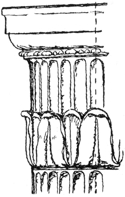
Fig. 1.
In Londinium wrought stonework must have been very sparingly used because of the difficulty and cost of transit. There were columns, pilasters, plinths, cornices, etc., but it may be doubted whether there were any buildings other than small monuments wholly of such masonry. Even in the first century the “details” of masonry were far from being “correctly classical,” and ornaments were very redundant and inventive. Provincial 11Roman building was something very different from the grammars propounded by architects. As we may study it in the fine museums of Trèves, Lyons, and London, it seems more like proto-Romanesque than a late form of “classic.” The Corinthian capitals of Cirencester are very fine works indeed; the acanthus is treated freshly, the points of the leaves being sharp and arranged as in Byzantine work; a sculptured pediment and ornamental frieze at Bath are also free and fine. On the other hand, moulded work is usually coarse and poor. An interesting architectural fragment found in London was the upper drum of a column which had several bands of leafage around the shaft and was a remote descendant of the acanthus column at Delphi (Fig. 1). Parts of small columns and their bases have been found, the latter with crude mouldings. I mention them because small circular work was usually turned in a lathe like Saxon baluster-shafts. A small capital from Silchester in the Reading Museum is of the bowl form so characteristic of Romanesque art.
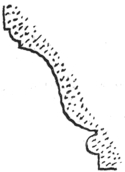
Fig. 2.
A few fragments of mouldings and other stones are in our museums (Fig. 2), and a considerable number of semicircular stones have been found which must have been copings. Large wrought 12stones were usually cramped together; lewis holes show how they were hoisted; smaller wall-facings were, I think, cut with an axe instead of a chisel. We find mention of one stone arch (a small niche?) in a Minute of the Society of Antiquaries: “Mar. 8, 1732: Mr. Sam Gale acquainted the Society, yt in digging up some old foundations near ye new Fabric erected Anno 1732 for ye Bank of England Mr. Sampson ye architect discovered a large old wall, eight foot under ye surface of ye ground, consisting of chalk stone and rubble, next to Threadneedle Street, in which was an arch of stone and a Busto of a man placed in it standing upon ye plinth, which he carefully covered up again: there was no inscription but he believed it to be Roman.”
Mortar and Concrete.—Roman builders early learnt how to make good mortar and concrete, being careful to use clean coarse gravel and finely divided lime. They also found that an addition of crushed tiles and pottery was an improvement, and for their good work used so much of this that the mortar became quite red. “Roman mortar was generally composed of lime, pounded tiles, sand and gravel, more or less coarse, and even small pebbles. At Richborough the mortar used in the interior of the walls is composed of lime and sand and pebbles or sea-beach, but the facing stones throughout are cemented with a much finer mortar in which powdered tile is introduced” (T. Wright).
One of the advantages of coarsely-crushed tiles is that it absorbs and holds water so that the mortar made with it dries very slowly and thus hardens perfectly. In Archæologia (lx.) an analysis is given of “mortar made with crushed tiles as grit in place 13of, or in conjunction with, sand.” In Rochester Museum a dishful of the crushed tile is shown which was taken from a heap found ready for use at the Roman villa at Darenth. I may say here that I have found mortar prepared in this way wonderfully tenacious, and suitable for special purposes like stopping holes in ancient walls. A strong cement made of finely powdered tiles, lime and oil was used by Byzantine and mediæval builders and probably by the Romans also. Villars de Honnecourt (thirteenth century) gives a recipe: “Take lime and pounded pagan tile in equal quantities until its colour predominates; moisten this with oil and with it you can make a tank hold water.” The use of crushed pottery in cement goes back to Minoan days in Crete.
In London a long, thick wall of concrete formed between timbering was recently found between Knightrider and Friday Streets; it showed prints of half-round upright posts and horizontal planking; it bent in its course and may have been the boundary of a stream. On the site of the old Post Office a Roman rubbish pit was found, about 50 ft. by 35 ft. in size. “In late Roman times the whole pit had been covered with concrete about a foot thick and a building had been erected on the spot” (Archæol. lxvi.). At Newgate the Roman structure was erected on a “raft” of rubble in clay finished with a layer of concrete. Rubble in clay formed the foundation of the City Wall.

Fig. 3.
Many walls, described as of chalk, rubble or rag-masonry, have been found in London—one instance at the Bank has been quoted above. Chalk and flints were the most accessible material after local gravel, clay and wood. Mr. F. W. Troup 14tells me that “in the foundations for the Blackfriars House, New Bridge Street, we exposed a remarkable foundation (possibly not Roman). It consisted of rammed chalk, fine white material about 4 ft. wide and high, laid on great planks of elm 6 in. thick, which appeared to be sawn. These were laid side by side in the direction of the length of the wall, which ran along the west bank of the Fleet River.” I mention this, although it was probably a mediæval wall, as an example of a record; we ought to have every excavation registered. The walls of a room found in Leadenhall Street in 1830 were of rubble forming a hard concretion, with a single row of bond tiles through the thickness of the wall at about every 2 ft. in height. A sketch of this wall at the Society of Antiquaries shows it plastered outside and in. This was one of the common types of walling. Better stone walls were formed with face casings of roughly-squared little stones—what the French call petit appareil—as described above. An immense amount of piling was used in wet ground under streets and wharves, as well as walls. Foundations have been discovered of three rows of piles close together with a wall coming directly on their heads (Fig. 3). A wall found on the site of the Mansion House seems to have had only one row of piles; it was plastered outside.
Tile Walling.—The brick commonly used in Rome was a crude or unbaked block; the burnt walling tile was, as said above, developed from 15pottery, and it always remained pottery-like in texture and thin in substance. As Mr. T. May has said of bricks: “They were made of heavy clay, well tempered and long exposed; the modern practice is to use the lightest possible clay right off without tempering.” Walling tiles were used in Londinium not only as bonding courses, but for the entire substance of walls. It is usual to write “Roman tiles or bricks” interchangeably, but in origin and character the thing was a tile, and, indeed, roofing tiles with flanged edges were used as a walling material occasionally. Tiles were of various sizes and shapes, but an oblong, 1½ ft. by 1 ft. and about 1½ in. thick, was most usual. In the Guildhall Museum are several triangular tiles which must, I think, have been used for facing walls with concrete cores. Solid tile walling was used in Londinium so extensively that it was evidently a common material for better buildings. The Lombard Street excavations of 1785 exposed “a wall which consisted of the smaller-sized Roman bricks, in which were two perpendicular flues, one semicircular and the other rectangular; the height of the wall was 10 ft. and the depth to the top from the surface was also 10 ft.” Here we have evidence of a brick wall rising the full height of one story at least (Archæol. viii.). Roach Smith noticed a wall in Scott’s Yard “8 ft. thick, entirely composed of oblong tiles in mortar.” Mr. Lambert has recently described some walls of brick 3¼ ft. thick found at Miles Lane. A building in Lower Thames Street had walls of red and yellow tiles in alternate layers. This fact I learn from a sketch by Fairholt at the Victoria and Albert Museum, and such use of bricks of two colours was a common practice. In 16Hodge’s sketches of the tile walls of a great building discovered at Leadenhall Market it is noted that some of the courses were red and buff. Price recorded of walls, 2½ ft. thick, found in the Bucklersbury excavations, that “the tiles were the usual kind of red and yellow brick.”
More recently a bath chamber has been found in Cannon Street built of tiles which on the illustration are indicated in alternate courses of red and yellow. In the description in Archæologia, it is remarked: “It would appear that the yellow was preferred, the red being employed where they were not visible.” Years ago Charles Knight observed that the tiles used in the City Wall at America Square varied from “bright red to palish yellow.” This has been confirmed by more recent accounts in Archæologia. Finally, Roach Smith, describing the discovery of a part of the South or River Wall of the City (Archæological Journal, vol. i.), says that the tiles used as bonding bands were straight and curved-edged (that is, flanged roof tiles), red and yellow in colour. At the Guildhall there are a roof tile and a flue tile of yellow colour. Building with tiles may for long have been customary, but the use of red and yellow tiles in the way described would probably have been a fashion during a limited time only, and in that case it follows that the buildings erected with red and yellow tiles are likely to be nearly contemporary; the date would, I suppose, be the fourth century. Specially made tiles were used for columns. At the Guildhall are several round tiles 8 in. diameter, suitable for the piers of a hypocaust. Also some semicircular tiles 12 in. in diameter. In Rochester Museum are some quadrants making up a circle about 1½ ft. in 17diameter. Tiles, eight of which made up a circle, have lately been found at Colchester, and in the Guildhall Museum is a course of a round column made up of twelve tiles around a small central circle. A large number of columns were evidently of such bricks plastered.
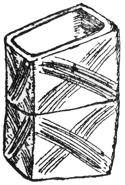
Fig. 4.
Arches and Vaults.—The arches in the City Wall, where it passed across the Walbrook, described by Roach Smith, were of no great span (3¼ ft.). They were constructed of ordinary tiles and were of a roughly-pointed shape. Arches of this form were not infrequently used in Roman works; they were not the result of inaccurate building. About a dozen years ago a well-built pointed arch of alternate tile and tufa, found at Naples, was described in Archæologia. The tiles, although thin, were sometimes made slightly wedge-shaped, and the city gates at Silchester seem to have had arches of such bricks.
The only London vault which I can find mentioned is one found exactly two hundred years since at St. Martin-in-the-Fields. A Minute of the Society of Antiquaries reads: “May 2, 1722: Mr. Stukely related that the Roman building in St. Martin’s Church was an arch built of Roman brick and at the bottom laid with a most strong cement of an unusual composition, of which he has got a lump. There was a square duct in each wall its whole length, of 9 in. breadth; there were several of these side by side: this building is below the springs on the gravel.” This building that was an arch, with its many flues, and cement floor—doubtless opus signinum—was obviously a Roman bath chamber, but probably it was quite small.
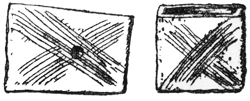
Fig. 5.
Evidence of the existence of fairly large vaults 18has been found at the Baths of Silchester, Wroxeter and Bath. These were all constructed in a most interesting and suggestive way of voussoirs made as hollow boxes in the tile material. Similar box voussoirs have been discovered at Chedworth and elsewhere.
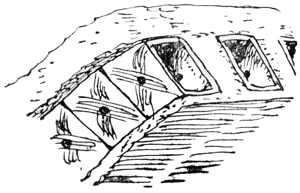
Fig. 6.

Fig. 7.
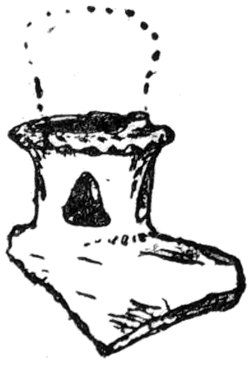
Fig. 8.
I have found two such box voussoirs in the Rochester Museum, each about 9 in. by 6 in. on the face and 5 in. on the soffit (Fig. 4). The surfaces are roughly scored across with parallel lines forming an Χ. These two tiles together show an obvious curvature; they came from a villa at Darenth. In the Guildhall Museum I have also found a box voussoir which is almost identical with those at Rochester. It is thus described: “74, Flue (?) tile, red brick, the front decorated with incised cross lines; in the centre both front and back is a circular perforation: 9½ in. long, 6¾ in. high, 6½ in. wide.” The longest dimension is not in the direction of the tube, and the height is greater at one end than the other, so that the wedge form is quite apparent. The small holes in both the larger sides were doubtless to give better hold to the mortar in which they were set (Fig. 5). Roach Smith recorded what must have been broken parts of similar voussoirs as found in Thames Street in 1848 (Journ. Brit. Archæol. Assoc., vol. iv.), but here they seem to have been used as waste material 19in building the little piers of hypocausts. Roman builders also constructed vaults of pipes and pots set in mortar concrete as were our box voussoirs, but I know of no British examples. Vaults of wide span seem to have covered large chambers in the Basilica at Verulam (see Victoria County History). The method of using the box voussoirs has been well explained from the Silchester examples by the late Mr. Fox in Archæologia (cf. Fig. 6). A fragment at Westminster Abbey is either part of a voussoir or of a short flue tile (Fig.7).
Some notes made at Bath further explain the interesting methods of building vaults with box voussoirs. There are several such voussoirs in the ruins of the Great Bath, 12 in. to 13 in. deep by 6 in. and 6½ in.; 6¾ in. and 7½ in.; 8¼ in. and 10 in.; 208 in. and 11 in. at the top and bottom. Fig. 9 is a sketch of the third; it is scored on the face. The notches cut in the sides take the place of the holes in the London examples, and doubtless were for the mortar to get a better key; Fig. 10 is from a vault of this construction which was further strengthened by a series of curved tiles set in the outer concrete mass, which was 6 in. thick; Fig. 11 shows the ridge of such a vault—this may be an imagination of my own. One of the fragments showed six or eight flat tiles set longitudinally crossing the lines of the box-tiles (Fig. 12). The ridge termination (Fig. 16) is also from Bath.
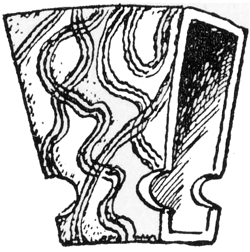
Fig. 9.

Fig. 10.
Some large voussoir box-tiles from Gaul are shown in the British Museum, No. 394, in the section of Greek and Roman life.

Fig. 11.
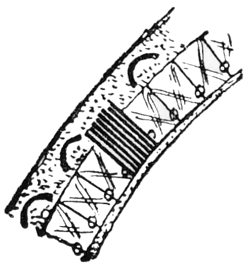
Fig. 12.
Well-constructed arched sewers have been found in the City (see Victoria County History).
Many socketed water-pipes are in our museums. Such pipes were occasionally used in Rome as down-pipes, and we might do worse than revert to the custom and get rid of the iron rust nuisance. In the British Museum there are some larger socketed pipes with small holes cut in them along a line. These must, I think, have been for draining surface water, for which purpose flue tiles were also used. Larger sewers were of brick or stone.
Carpentry.—In mediæval days the carpenter was the chief house builder, and much timber would have been used in Roman London. In 1901-2 remains of piling was found in the bed of the Walbrook at London Wall. These piles had served as supports for dwellings. “The large quantities of loose nails indicated that the superimposed dwellings were of timber” (Builder, December 13, 1902). Timber piling has also been found at St. Martin’s le Grand and other sites. There was clearly much soft wet ground in the City. The better-class dwelling in Bucklersbury, to which belonged the fine mosaic floor now at the Guildhall, seems to have been largely of timber. In December last (1921) Mr. Lambert described at the Society of Antiquaries a remarkable piece of wharfing on the river bank at Miles Lane. This was a solid wall of squared balks of timber about 2 ft. square, laid one over the other and having ties into the ground behind. The construction showed an interesting set of tenons, halvings and housings. A bored wood pipe was also found. In Thames Street a house found in 1848 had a well-made drain made with 2 in. planks forming bottom and 22sides, which is said to have been covered in with tiles.
Wattle and Daub.—It was ever a problem in London how to build without stone. Wood, gravel and mud were plentiful, and these were the common walling materials during the Middle Ages. As lately as the eighteenth century some of the suburban churches were described by Hatton as being of “boulder work,” that is, a concrete of coarse gravel; and the walls of the Temple Church, before the falsifying restorations, were of some sort of concreted rubble skinned over with plaster on the face. Hearne reports that Wren said that there were few masons in London when he was young. Mud walls are mentioned in mediæval records, and “daubers” were, I suppose, primarily those who did the filling in of post and pan work. The smaller houses of Londinium were largely of wattle and daub, and doubtless others were of crude brick. For the use of wattle and daub we have plentiful direct evidence. In the account of the excavations in and about Lombard Street in 1785 (Archæol. viii.) curious fragments were found which are thus described: “About this spot and in many other places large pieces of porous brick were met with of a very loose texture, seeming as if mixed with straw before they were burnt. They are commonly channelled on the surface; their size is quite uncertain, being mere fragments, their thickness about 1½ in. or 2 in.” Again, chalk-stone foundations and “channelled brick” are mentioned together. The “brick” fragments were of daubing, and the channels were the marks of laths, as has been shown by other finds. Similar remnants have recently been discovered on the Post 23Office site and in King William Street. “Débris of a wood and daub house which had been destroyed by fire.... In several cases the plaster was still adhering to the daub” (Archæol. lxvi.). Other fragments are preserved in the Silchester collection at Reading. The London fragments were found under conditions which showed that they had belonged to first-century dwellings. This method of building had been practised by the Celts, and we may imagine that the “populace” of Londinium was housed in small huts of wattle and clay roofed with reed thatch. In the country, old garden walls are occasionally found, I believe, built of mud daubing on both sides of wattle work, and sheep shelters of wattle-hurdles and dry fern are, I suppose, direct descendants of the old British manner of building.
Mr. Bushe-Fox has remarked that one of the earliest houses at Silchester and the earliest houses at Wroxeter were of wattle and daub construction. See also Mr. Lambert’s paper in Archæologia, December 1921.
Hypocausts and Flue Tiles and Wall Linings.—Several examples have been found in London of the Roman system of heating buildings by hypocausts. These were low under-floor spaces a foot or two high connected with an external stoke-hole in one direction and having a flue or flues in the other. When the hypocaust, as was frequently the case, occupied the whole space below a chamber the floor was supported on a large number of roughly-built little piers with a row or two of flat tiles above spanning the intervals, and over them a layer of concrete and a mosaic or other floor. The flues were usually box-tiles, and in the case of the hot 24chambers of a bath one side of a wall or even more might be lined with them. A hypocaust with its stoke-hole and flue or flues was really a kiln of low power, in which people were warmed on a similar principle to the baking of pottery. The box-tiles were much the shape of a modern brick, and about twice as big; they were hollow and usually had scorings or impressed patterns on the surface to make mortar or plaster adhere (Figs. 6 and 7). Frequently they had a hole or two holes in their narrow sides, so that the mortar might better hold them in place. In the British Museum there is a long and large pipe with ornamental scratchings on the surface which may possibly be a chimney.
The system of central heating by the hypocaust seems to have been an admirable contrivance. Lysons illustrated an example at Littlecote where flue tiles ran up in the angles of a room like Tobin tubes, being cased round only by the plaster. The two best known London hypocausts were found in Lower Thames Street and in Bucklersbury. The former extended under the floors of two adjoining apartments. The Bucklersbury example had channels under the floor spreading to several wall flues, each being of two box-tiles placed side by side. (See Price’s account and V.C.H.) Occasionally flue tiles had two smaller channels; there is a broken example of such a tile in the British Museum. Flue tiles were sometimes of a rounded form ∩, and in this case the wall itself must have served to enclose the flue. In the excavations in Lombard Street in 1785 (Archæol. viii.) a brick wall is described which had two flues, one being “semicircular.” A long and well-made ∩-shaped flue in the British Museum, with an impressed lozenge 25pattern on the surface, is described as a ridge-tile. There is also a fragment of still larger diameter at the Guildhall. Similar flues found at Woodchester were used as horizontal heating channels under the floor.
Here also one of the walls was found to be lined with flanged tiles, set thus, │__││__│, with the flanges against the walls. This may have been a provision against a damp wall. I have seen a similar wall in Rome—I believe subterranean—also another very similar where large flat tiles, having four projections at the back like short legs to a low stool, were used as linings. Each of the four studs was pierced for a nail. Fragments of tiles found at Newgate in 1877 were about 1½ ft. square and 1¼ in. thick, “with rough clay stubs for attachment”; they were scored over the surface with wavy lines, and were probably used internally. (In V.C.H. it is said that these may have been mediæval, but the examples just given show that they were Roman.) In the British Museum and at the Guildhall are some flat tiles, scored on one side to receive plastering, and with four notches in the sides to allow of nails being driven between two adjoining tiles. These, too, must have been for wall linings.
The impressed patterns on the surfaces of some of these flue tiles are quite neat and pretty, and they are interesting in the history of design as being “all-over patterns.” In some cases at least, they seem to have been produced by a roller having a unit of the design cut on it in the style of a butter print. A tile found in Kent, illustrated by Haverfield (Romanization, p. 33), has the inscription: “Cabriabanus made this wall-tile” (parietalam)—“The 26man who made the tiles apparently incised the legend on a wooden cylinder and rolled it over the tiles, producing a recurrent inscription.” The patterns superseded the scorings and seem to have been for the same purpose—to afford a better hold for the plaster than a plain face. Fig. 13 is of tiles found in Thames Street. Fig. 14 is a fragment illustrated in Roach Smith’s Catalogue.

Fig. 13.
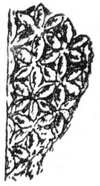
Fig. 14.
Inscriptions roughly scratched on tiles led the late Dr. Haverfield to the conclusion that ordinary workers in Britain wrote Latin. At the Guildhall a tile has a humorous note about a workman who went off “on his own” too often. In the British Museum a tile has Primus, and one from Silchester has Satis.
Floors.—The floors which have been found were most generally of concrete, tiles and mosaic. In Rochester Museum are some lumps of material from concrete floors. There were also floors of “rough stones” and of “chalk stones.” A better kind of concrete floor was that known as opus signinum, made of lime and broken pottery polished on the surface; this made an admirable floor. 27Another excellent and much used surface was obtained by coarse tesseræ of tile from 1 in. to 2 in. square; sometimes pieces of yellow, black and white were intermixed. In Rochester Museum is a tile fragment subdivided by indented lines imitating this coarse kind of mosaic, also a square of light buff tile. At the Guildhall is a tile a Roman foot square, having incised squares. Tiles were of various forms and sizes. In the Reading Museum are round and polygonal tiles, and a very pretty floor formed of such tiles with coarse tesseræ intermixed. Some small paving tiles have been found (not in London) with patterns impressed on the surface (Fowler’s engravings). In the British Museum is a tile 7 in. square, and a large tile about 18 by 14 in. is scored on the surface neatly, like the crosses of a Union Jack (cf. Fig. 7); it seems to be abraded on the surface, and may be a paving tile—if so, it must have made an excellent floor. Roach Smith mentions large tiles about 2 ft. square and 3 in. thick, and some of these are in the British Museum. Such tiles, as large as paving slabs, were useful in covering hypocausts, spanning the intervals between the little piers on which the corners rested.
In the British Museum and at the Guildhall are portions of paving of small tiles set on edge in a herring-bone pattern. The former is described as having been found at Bush Lane, the latter near Dowgate Hill on the Walbrook. “Near by was piling and the cill of a bridge which crossed the brook from E. to W.” This seems to be the same pavement as that described in The Builder, 1884, as being on the west bank facing the brook; there was a second landing-stage in Trinity Square Gardens, on “the edge of a haven,” with a pavement 28over oak piling. (The haven at the tidal inlet to Walbrook was doubtless the original port of London.) I have seen similar herring-bone pavement of tiles on edge in Rome. I doubt there having been a bridge here.
Plastering.—External walls would mostly have been plastered. C. Knight mentioned the discovery near the Bank of traces of a Roman building, and of what was “apparently the basis of a Roman pillar (circular?) built of large flat bricks incrusted with a very hard cement, in which the mouldings were formed exactly as is done in the present day.”
Rome itself must have been a city of plastered walls; the Pantheon, the great Basilica of Constantine in the Forum, and the splendid Baths were all, as may be seen to-day, plastered. The tile walls of the Basilica at Trèves were covered with red plastering. The Baths at Silchester were plastered externally. Of the great villa at Woodchester we are told the walls were “plastered on the outside and painted a dull red colour” (T. Wright). At Caerwent the Basilica was plastered a reddish-brown colour. The best description I have found of such plastering is that in Archæologia of a round temple or tomb building found at Holmwood Hill, which was covered outside with “a mixture of lime and gravel and coarse fragments of broken tile. On this was laid a coat of stucco composed of lime and tile more minutely broken, the latter being rendered very smooth was covered with a dark pigment ... a sort of ochre.” It is clear that external plastering was generally finished with a red surface.
Of internal plastering we have many fragments covered with painted decoration in the museums; 29it was generally very thick and smoothly finished on the surface; against the floor there was usually a projecting quarter-round fillet about 3 in. high, of hard cement. Such a skirting was found around the Bucklersbury mosaic pavement (Price). Sometimes a similar fillet ran up the angles of a room, as at a bath at Hartlip Villa, illustrated by T. Wright. I have seen a similar treatment in Rome, also a hollow curve.
Roofs, Windows, etc.—Roofs were generally covered with tiles, stone-slates, and doubtless thatch. Examples of the two former are in our museums. The flat tiles had turned-up edges; these were removed near the top for the next tile to lap over. The flanges were covered by half-round tiles, larger below than above, so that one lapped over the other. The flat tiles were frequently if not always of a key-stone shape, so that the bottom of the upper one set into the wider top of the lower one. (See one figured in Allen’s London.) Some have a single nail-hole near the top; but others, I suppose, can only have been nailed against the slanting sides. (See V. le Duc’s article “Tuille” for the Romanesque system.) In better work ante-fix tiles covered the terminations of the round tiles at the eaves. “Part of an ante-fix of red terra-cotta in the form of a lion’s mask” was found in the Strand (V.C.H.). There are several in Reading Museum and one in the British Museum from Chester. The slates were thick and of a pointed shape below, forming diagonal lines when laid. Both the stones and tiles were very heavy, and must have required strong roof timbering.
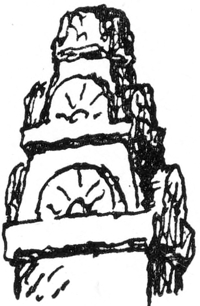
Fig. 15.
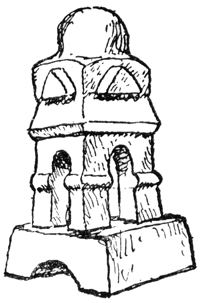
Fig. 16.
Ridges were of tile or stone. A fragment in 30the Reading Museum from Silchester has a knob rising from the saddle-back of a ridge-tile strangely mediæval in appearance (Fig. 8). Probably one came at each end of the ridge only (cf. V. le Duc’s “Faîtière”). Ridges were frequently terminated by stone gable knobs, which have been found in many places (see Ward’s Roman Buildings), and occasionally in such a position as to show that a gable end fronted a street. A ridge termination in Exeter Museum is shown upside down as if it were a corbel (Fig. 15 is a memory sketch, and compare Fig. 16 from Bath). These terminations are late derivations from acroteria and prototypes of gable crosses; they are links in a continuous chain from Greek to Gothic.
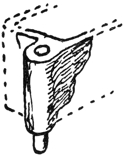
Fig. 17.
Little joiner’s work has survived to our day. Doors would not have been very different from our own, as is shown by many examples of framed panel work from foreign sites in museums. A 31bronze pivot in the Museum at Westminster Abbey must have been a hinge of a door (Fig. 17). Iron strap-hinges in the museums are very similar to our own. There are two in the British Museum (Fig. 18). The plane found at Silchester is evidence for joiner’s work. In Leicester Museum is a fragment of a lion’s head and leg from a piece of furniture—probably a table. Turning in a lathe was practised, as some wooden dishes at the Guildhall show. There are many excellent locks and keys and hinges and handles in our museums.
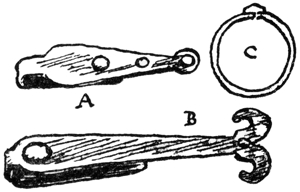
Fig. 18.
The use of window glass was very general. It was cast in small panes, as is shown by the large proportion of existing fragments which have edges and corners. Practically a whole pane, about 12 in. by 12 in., is in the Rochester Museum. Near Warrington, on a Roman site, was found a stone slab with a shallow recess 12 in. by 8 in., which Mr. May regarded as a mould for glass (Ward). The average size of panes would have been about one Roman foot long. Glassware seems to have been made in London, Silchester and elsewhere, doubtless from imported “metal.” Some windows, 32possibly unglazed, were protected by iron gratings. An iron star X in the Guildhall Museum came from such a window guard as is shown by a complete example I sketched many years ago in the Strasbourg Museum (see Arch. Rev., May 1913) (Fig. 19). It had been suggested that such X-pieces were “holdfasts,” to keep the glass panes in position (Ward); but this is not the case; moreover, the pane at Rochester shows that it was “cemented” into place.
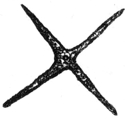
Fig. 19.
Lead must have been largely used; there are a dozen large “pigs” in the British Museum. Melted lead was found at Verulam in a position which suggested that it had been used on an important building. In the Guildhall Museum are some sections of lead water-pipes found in London, and at Westminster Abbey is a piece 4 in. in diameter, which must, I think, be Roman (Fig. 18, C).
A study of Roman building methods may suggest to us many points for our consideration and emulation. I would especially mention their excellent mortar made of crushed tile, opus signinum, and coarse tesseræ floors, cement skirtings, red external plastering, the tile-shaped brick, tile wall linings and down-pipes, hip and gable knobs, vaults of box-tiles and pipes, the hypocaust system of heating, turning of stonework, painted decorations, marble linings, cast leadwork. Some day I hope our sterile histories of “architectural styles” will make way for accounts of practical building methods.
BASILICA.—In 1880 the extensive foundations of an important building with massive walls were found on the site of Leadenhall Market, and a survey of the ruins made by Henry Hodge was published in Archæologia (vol. lxvi.). This great building was exceptional, not only in its scale but in its manner of workmanship. I know no other case where the walls of a building had wrought and coursed facings like the City Wall (Fig. 20).
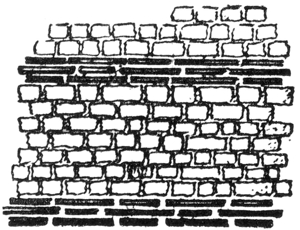
Fig. 20.
In 1881 Mr. E. P. L. Brock exhibited at a meeting of the British Archæological Association “plans of excavations recently carried out in Leadenhall Market, showing the foundations of an apse 33 ft. wide and indications of four different conflagrations. He also exhibited fragments of fresco painting with ornamental patterns.... The 34building appears to have had the form of a Basilica in some respects, with eastern apse, western nave, and two chambers like transepts on the south side” (Archæol. lxvi.). From the wording of this it appears that Brock meant that the building had a general resemblance to an early Christian church. Mr. Lambert in publishing Hodge’s drawings in Archæologia seems to have understood Brock to mean that it was the Civil Basilica of Londinium. This, indeed, I have no doubt it was, but at the time Brock wrote such buildings in Britain were hardly known.
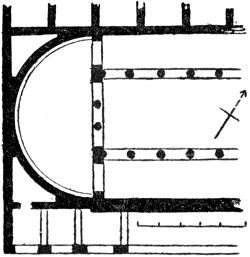
Fig. 21.
The Civil Basilica or Public Hall was generally the “complement of the Forum; it was, in fact, a covered Forum used for commerce, exchange, and administration, or simply as a promenade” (Daremberg and Saglio). At Silchester the Forum and Basilica filled an “island” site, about 315 ft. by 280 ft., at the centre of the city. The Forum was a quadrangle included within a single row of buildings on three sides, having a colonnaded walk on the inside, while the Basilica occupied the fourth side facing the central avenue of the town. It was 233 ft. long by 58 ft. wide, and was divided into a “nave” and “aisles,” the former being terminated at each end by a large apse. In the interior were two ranges of Corinthian columns about 3 ft. in diameter, some capitals from which 35are now in Reading Museum. Cirencester Basilica was still larger, being about 77 ft. wide, divided into nave and aisles by fine Corinthian columns; at one end a great Hemicycle embraced both nave and aisles. It must have been a noble building (Fig. 21 is a restored plan of one end). At Wroxeter the Basilica was 67 ft. wide, divided into nave and aisles by ranges of Corinthian columns.
The columns in the interior of the Basilica at Caerwent were also of Corinthian fashion: the shafts were 3 ft. in diameter and decorated with a leaf pattern. Under the floor were wide sleeper walls, one of which ran across the front of the Tribune. The exterior was covered with reddish-brown plastering, and the interior had painted decorations of large scale.
The Basilica at Verulam had a very long hall, 26 ft. wide and about 360 ft. in length. From it three great chambers opened at right angles. The central chamber was 40 ft. wide. The others were 34½ ft. wide, having apses at the farther ends included within square outer walls. There was evidence that these side chambers had been vaulted. Some painted wall plaster was found, and it was clear that the whole of the interior walls and vaults had been painted, mostly in floral designs, in dark olive green and other colours. Fragments of drapery indicated that there had been figures also. In front of the Basilica was a great quadrangle court, with a block of masonry on the central axis, which can hardly have been other than a pedestal for a statue (see V.C.H.).
The Basilica at Trèves is built wholly of tile-bricks, and was once covered with red plaster, of which some fragments remain in the window 36jambs. It is about 240 ft. long, the flank wall having six bays recessed between pilasters each containing an upper and a lower window. A large apse exists at one end, about 40 ft. wide. It has been restored to serve as a church, and is a noble building, big and bare. The British Basilicas, so far as they are now known, were of the following dimensions in width. The English measures may probably be equated with Roman feet as suggested: Silchester, 58 (60); Caerwent, 62 (65); Wroxeter, 67 (70); Cirencester, 78 (80); Chester, 76 (?).
The foundations discovered on the site of Leadenhall Market represented some very large and exceptional structures. The following account is condensed from Mr. Lambert’s description in Archæologia: “The plans show at the eastern end a quarter-circle of 27 ft. 7 in. radius, which seems to represent the eastern apse mentioned by Brock; and in continuation of its southern line, a wall about 150 ft. long, having the extraordinary breadth of 12 ft. 7 in., runs to the line of and apparently underneath Gracechurch Street.... From the south side at the east end, spring at right angles three walls, which doubtless enclosed the ‘two chambers like transepts’ mentioned by Brock.... It is probable that work of different periods is included in this plan.... The northern half of the great wall appears to be brick, the rest stone or rubble, as though one wall had been built along the face of another.... It is clear from the drawings that the bulk of the eastern portions of the remains is homogeneous in structure. The extra thickness of the great wall and the fragments of solid brick walls at either end of the site represent perhaps later additions.... These remains 37form the most extensive fragment of a Roman building recorded within the Walls of London.” From the thick mortar joints of the brick walls, Mr. Lambert concludes that they were probably built in the third or fourth century. The more or less alternating use of red and buff bricks, as I have already suggested, is also evidence that this part of the work should be assigned to the fourth century. Concrete, tessellated and herring-bone floors were found, also flue tiles (Price, Athen., 1881).
Some of the bricks used were of larger size than the ordinary, being 20 in. by 12½ in., and the drawings show that they were carefully laid with alternate headers and stretchers (Fig. 17). They were 1¾ in. thick, and four courses made 10-12 in.; the joints were thus about 1¼ in. thick. At the Guildhall is a fragment of brickwork from Leadenhall Market, with bricks and joints both 1½ in. thick. The stone walling was of concreted rubble, with facings on each side in small, roughly wrought but carefully-coursed stones; the layers of bonding tiles passed through the thickness of these walls (Fig. 20). A large drain ran parallel to the outer south wall about 4 ft. wide, including its brick sides.
The general plan shows a total length from the apse at the east to the broken wall at the west against Gracechurch Street of about 210 ft. About 44 ft. to the north of the Great Wall a parallel wall is shown on the plan, but no details are given, and it may not have been Roman.
The interior curve of the upper wall of the apse had a radius of about 22 ft., and the width of a central “nave” agreeing with this can hardly have been less than 50 ft.; the total internal width, supposing there were “aisles” in line with the 38“chambers” at the end, would have been about 110 ft. There were thick transverse walls across the front of the apse, and again about 20 ft. to the west. I give (Fig. 22) a plan adapted from Archæologia; the walls shown black were not necessarily all above the floor level, although they are thinner than the lowest foundations. (Note that in the plan in Archæologia the scale is given in divisions of 12 ft., and not of 10 ft. as usual.)
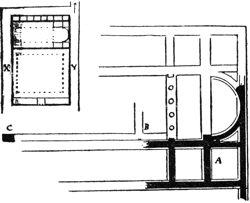
Fig. 22.
My plan is restored as a possible reading of the evidence; the most certain parts are those in black (A); the foundations (B) may be of a different age; at the left (C) is the brick pier or wall against Gracechurch Street.
A structure perhaps 110 ft. wide with a central avenue of 50 ft. would have been exceptional; on the other hand, a Basilica 220 ft. to 250 ft. long including the apse would have been rather short. One of the walls found to the west of Gracechurch 39Street was bent in its line as if it might have been against a stream. The nature of the site might have dictated a rather short and very wide building. It should be noticed that the line of Gracechurch Street is nearly or exactly at right angles to the great building. Hodge’s drawings show that the walls of Leadenhall Market were built directly on the Roman foundations, and hence square with them.
The Basilica would have had ranges of Corinthian columns and perhaps a transverse row on the foundation in front of the apse, as at the Basilica Ulpia in Rome and at Pompeii: compare also the transverse walls at the Basilicas of Cirencester and Caerwent. The roof would probably have had trusses of low pitch exposed to the interior, like those of the early Christian churches.
In 1908 a Roman wall, 3½ ft. wide, parallel to Gracechurch Street, was found at No. 85. In 1912 a fine Roman wall, 4½ ft. wide, running north and south, was found just south of Corbet’s Court; turning at right angles it passed under Gracechurch Street. It was of ragstone with double courses of tiles; the base was 27 ft. below the present level; a piece of thinner wall ran close and parallel with the roadway (Archæologia, lxiii.). Kelsey noted that in 1834 massive walls were found in Gracechurch Street from Corbet’s Court to the head of the street (Archæologia, lx.).
The discovery was announced in January 1922 of a wall 2¾ ft. thick of ragstone and bond tiles “in the centre of Gracechurch Street a little south of the Cornhill crossing (to the west or left of Fig. 22). A length of about 10 ft. has been disclosed following the central line of Gracechurch Street. The 40presence of this Roman building in the middle of the highway proves that the mediæval street did not follow the line of the Roman street. Close at hand is Leadenhall. When the present market was reconstructed, excavations disclosed remains of an important Roman building. It is probable that the remains now unearthed are associated with the same group of buildings.” Another wall, 4½ ft. thick, was found at right angles to the thinner wall; the finds were at a depth of about 13 ft. This building, which must have been part of the Basilica or adjacent to it and square with it, was thus as far west as the middle of the street, and doubtless farther, for the thinner wall in association with a thicker one would not have been an external wall. Other walls have recently been found under St. Peter’s, Cornhill, corresponding with those under Leadenhall Market. “All these finds seem to be part of a great building more than 400 ft. long, which crowned the eastern hill of London” (Antiquaries’ Journal, vol. ii. p. 260; see also p. 225, below).
The smaller inset plan on Fig. 22 is a very visionary reading of the possibilities. A street in line with Fish Street Hill and the Bridge, which I will call Axis Street, may not have pointed to the centre of this great building, but rather by its west end as suggested (X). If this is too far west for the Axis Street, then we must suppose that it was directed towards some point in the south front of the Forum. (It is desirable that all the walls found in this locality should be accurately laid down on a plan.) A parallel street to the east, which I will call North Gate Street (Y), would not be in continuation with Axis Street. The question whether Bishopsgate 41and Gracechurch Street represent a Roman street from the Bridge to the Gate has been much argued over (see Archæologia, 1906), and it seems to have been shown that the line was interrupted in some way. The southern part, however, must, I think, represent the Roman street from the Bridge, although it may later have been bent aside to tend more directly to Bishopsgate. The facts and the fault in the line may be reconciled in some such way as suggested. (Hodge’s drawings are in the old Gardner collection, and it would be interesting to know what other Roman records are included.)
Beyond the statement quoted from Brock no identification of the building is offered in Archæologia, and Mr. Bushe-Fox thought that if the walls were contemporary they could not belong to a Basilica. “If there were a nave with two aisles and an apse there would be no reason for the cross wall, nor for the excessive thickness of the side wall. The building had perhaps been a bath; the wall which ended abruptly at the west end was probably a flue for heating the apse, and the large drain would be accounted for” (Proceedings, 1914-5). That the building was indeed the civil Basilica of Londinium is proved to my mind by: A comparison of the plan with those of other British Basilicas—notice the way that the apse is within straight external walls, and compare Fig. 21; by the great scale of the work; by its central position in the City; by the scale and character of the construction; by the fact that the only possible alternative seems to be the supposition that it was the great Bath of the City, and for this neither the planning nor the situation seems suitable; by the exceptional wall decorations described below; by the fact that a 42tile bearing the official stamp PR-BRILON was found on the site (Price). It is a remarkable fact that Leadenhall was the market, and that the Crossing at Cornhill was the carfax of London during the Middle Ages.
We have seen above that Brock said that fragments of painting were found on the site. In the British Museum are four pieces of wall painting, given by Mr. Hilton Price—1 and 2 in 1882, and 3 and 4 in 1883; the first pair are said to be from Leadenhall, the second pair from Leadenhall Market. One and 3 are fragments of large-scale scrolls of ornamental foliage of a grey-green colour; 2 is a piece of large-scale drapery, and 4 is part of a life-sized foot. These four remarkable fragments evidently form one group and came from the Basilica. The large scale of the ornament and figure work differentiates these pieces of painted plaster from all others found in London. At Silchester and Cirencester fragments of marble wall linings have been found on the sites of the Basilicas, and some of the marble fragments in the British Museum may have come from our Basilica, which must have been a handsome, indeed splendid, civic centre. In the Forum would have been statues of Emperors, and in the Basilica some impersonation of Londinium itself (cf. the fragment of such a figure found at Silchester, now at Reading).

Fig. 23.
Houses.—In 1869 a mosaic pavement was discovered in Bucklersbury which is now at the Guildhall (Builder, May 15 and 29). It was fully described in a volume by Price. The floor was that of a small round-ended chamber, and belonged to a building on the western bank of the Walbrook, 43Around the apsidal end of the room which had the mosaic was a wall of stone and chalk, built upon piling; this wall contained the flues of the heating-system, and it terminated in piers at the ends of the semicircle. From the fact that no more walling was found and the evidence of an attached lobby which had a wooden sill around it, we may suppose that the rest of the house was of timber work (Fig. 23). The curved apse would be a strong form in which to build a mass of wall to contain the vertical wall flues; and it is an interesting example of building contrivance. We have already seen that timber and clay construction was frequent in Londinium. Near this building a well was found (built of square blocks of chalk, The Builder says). This building with the mosaic floor must have been a superior house on the bank of the Walbrook. To the west, as we shall see, seems to have been a street possibly of shops; we can thus imagine a little group of buildings and streets, 44and a bridge over the Walbrook at the end of Bucklersbury.
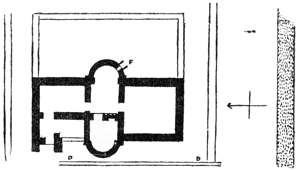
Fig. 24.
The well mentioned above is one of a great number which have been discovered; for instance, in excavating for Copthall Avenue “a pit or well, boarded, and filled with earthenware vessels,” etc., was found (Builder, October 5, 1889). Such wells with boarding like a long barrel have been excavated at Silchester. Again to the south of Aldgate High Street two wells were found (Builder, May 3, 1884).
The most complete Roman building which has been recovered and planned is one excavated in Lower Thames Street in 1848 and again in 1859 (Builder, February 5, 1848, and June 11, 1859). A restored plan was given in the Journal of the British Archæological Association, vol. xxiv. (see Fig. 21). The two apsed chambers had hypocausts beneath their floors, supported on little piers built of tiles 8½ in. square, and broken materials. Fig. 25 is reproduced from the illustration of the eastern chamber given in The Builder. Several sketches and some notes, by Fairholt, of this building are in the Victoria and Albert Museum. About 4 or 5 ft. of the walls remained in places, all of tiles with mortar joints nearly as thick as themselves.
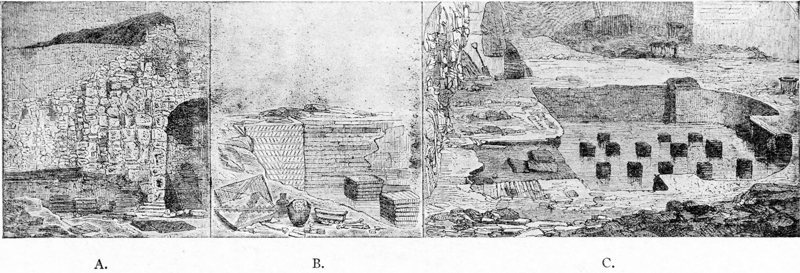
Fig. 25.—(A, old masonry; B, brickwork with a flue tile; C, foundations of chamber.)
Foundations discovered in Lower Thames Street in 1859.
46“The walls were of red and yellow brick in alternate layers composed of 18 in. tiles.” Outside the walls was “a drain of wooden planks, 18 in. deep by 10 wide, running towards the river” (see plan). The walls were erected on piles. The sketches show some of the box-flue tiles which had impressed patterns (see Fig. 25). Some additional information is given on a lithograph by A. J. Stothard (1848). The walls were 3 ft. thick. Above the floor of the south room, which was of coarse red and yellow tesseræ, was a second, about a foot higher in level; this was “a layer of red concrete 2½ in. thick, hard, and the upper surface almost glazed” (compare a floor found in Eastcheap, “concrete stuccoed over and painted red.”—V.C.H.). This building was doubtless a house; at the time it was found it was called a bath, but it seems too small to have been even a secondary public bath. As Thos. Wright says: “Many writers have concluded hastily that every house with a hypocaust was a public bath” (cf. the plan of a house at Lymne, The Roman, etc., p. 160). The stoke-hole of the hypocaust was at F, and there were flues up the middle wall and the western apse. The large room was 23 ft. square; some tiles of 2 ft. square were found here, also window glass and an iron key. The plan lay square with the south City Wall (Fig. 24), and the building can hardly be earlier than this wall. It may thus be accepted as a late fourth-century house, and we may further infer that box-tiles with impressed patterns were a characteristic of this century. On two sides of the house were lanes about 10 ft. wide. As in so many cases modern walls seem to have been laid out on the same alignment as the Roman building.
47The house just described had two apses, and the Bucklersbury house also had an apse. This was in agreement with general custom. As Thos. Wright remarked: “One peculiarity which is observed almost invariably in Roman houses in Britain is that one room has a semicircular alcove, and in some instances more than one room possesses this adjunct.” In the plan given in Archæologia of the Roman walls and floors found in and about Lombard Street in 1785 two apses seem to be indicated; thus we have evidence for five in the scanty records; altogether there must have been scores in the city.
Within the walls of the City were many large houses of the villa type as well as minor dwellings and streets of shops. Roach Smith speaks of such great houses about Crosby Square; he also describes a mosaic floor under Paternoster Row which extended 40 ft.; a second important floor on the site of India House, Leadenhall Street, was at least 22 ft. square, and may have been considerably more; a third large floor which was found under the Excise Office, Broad Street, was about 28 ft. square (probably 30 Roman ft.). All these must have been the floors of the chief central rooms of large houses of the villa type. Tite saw this of the Broad Street floor as his speaking of the “triclinium, other rooms, and the garden” shows. This Broad Street pavement was lying square with more modern walls surrounding it, and it may not be doubted that buildings continuously occupied the site.
The supposition that there were important houses of the villa type within the walls of the City has been fully confirmed by the excavations at Silchester, and I may here quote Dr. Haverfield’s 48general conclusions as to Roman towns in Britain. “Roman British towns were of fair size, Roman London, perhaps even Roman Cirencester were larger than Roman Cologne or Bordeaux. They possessed, too, the buildings proper to a Roman town—town hall, market-place, public baths, chess-board street-plan, all of Roman fashion; they had also shops and temples and here and there a hotel.... The dwelling-houses in them were not town houses fitted to stand side by side to form regular streets; they were country houses, dotted about like cottages in a village. But in one way or another and to a real amount, Britain shared in that expansion of town life which formed a special achievement of the Roman Empire.” The evidence as to the isolation of the houses is here a little overstated, but in the main the passage gives a true impression. Fragments of wall decorations and mosaics found in Southwark suggest that there were big houses on that side of the river, and doubtless others occupied sites along the Strand and Holborn.
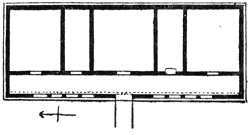
Fig. 26.
I give here a little sketch plan (Fig. 26) of a house found about a century since at Worplesdon, Surrey, from a survey at the Society of Antiquaries. This house is interesting as its unaltered plan gives an example of a simple “Corridor House.” It was 62 ft. long by 22½ ft. wide within the foundations, and faced west. The slight foundations of flint, not much more than a foot wide, show that the walls 49must have been of timbering or wattle work. The rooms and passage had floors of plain coarse tesseræ, except that the outer side of the passage had a simple twist border in mosaic. Possibly there had been some pattern in the central room as the floor was there missing, and a note reads: “Near this place was found the lozenge-shaped tessellated pavement.”
Baths, Temples, etc.—Remnants of important buildings have been found in Cannon Street from time to time, and London Stone is probably a fragment of one of them. Wren was of the opinion “by reason of its large foundations that it was some more considerable monument in the Forum; for in the adjoining ground to the south were discovered some tessellated pavements, and other extensive remains of Roman workmanship and buildings.” Under Cannon Street a building with one apartment 40 ft. by 50 ft., and many other chambers, is mentioned in V.C.H. At Dowgate Hill the foundations of large edifices are listed in V.C.H., and of Bush Lane it is remarked: “That there must have been extensive buildings here seems clear.” At Trinity Lane, Great Queen Street, “great portions of immense walls with bonding tiles” have been found (V.C.H.). There was a house on the south side of St. Paul’s known as Camera or Domus Dianæ which may have taken its name from some Roman monument. In a St. Paul’s deed of 1220 it appears as a messuage or inn, domum que fuit Diane.
In December 1921 Mr. Lambert described the foundations of a building by Miles Lane. The plan of this suggested a house of the corridor type facing east. The site seems to have been levelled 50up by timber walling or wharfing against the river and running back into the sloping ground.
One of the most important public buildings in the City would have been the Public Baths, as those of Silchester and Wroxeter show. At Trèves the great Baths cover acres of ground by the river. Bagford says that after the fire of London some Roman water-pipes were found in Creed Lane “which had been carried round a Bath that was built in a round form with niches at equal intervals for seats.” This suggests a part of important Baths, and Creed Lane does not seem an unlikely situation for the Public Baths. (In V.C.H. the site is said to have been in Ludgate Square.)
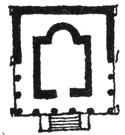
Fig. 27.
The only certain evidence we have for Temples are some inscriptions and sculptures. For the most part they would, like those found at Silchester and elsewhere, have been small square and polygonal structures set on a rather high podium approached by steps. Fig. 27 is a restored plan of the little Temple found at Caerwent. Doubtless here and in most cases, the roof of the cella ran on to cover the podium. At the foot of the steps an external altar would have stood. The column illustrated before (Fig. 1) seems suitable for a temple. Roach Smith, speaking of the group of Mother Goddesses found in Crutched Friars (see Builder, October 30, 1847), says: “It is the only instance with the exception of the discovery made in Nicholas Lane in which the site of a temple can with reason be identified” (Ill. Rom. Lon., p. 33). The find in Nicholas Lane was part of an important and early 51inscription which may have been on the chief temple in Londinium. Some sculptures found on the bank of the Walbrook suggest that a cell of Mithras occupied the site. In the fourth century a Christian church would, as at Silchester, have occupied an important site in the City.
A large Theatre or Amphitheatre, or both, would have been necessary in such a town. Roach Smith, who had a wonderful instinct of insight, thought that such a building probably occupied a site against the bank of the Fleet, called “Breakneck Steps.” Lately it has been suggested that the drawing-in of the line of the City Walls at the north-west angle was done to avoid an amphitheatre; more probably, I think, it was to avoid wet ground. There is evidence that gladiator contests and chariot races were popular. For gladiators, compare two small bone figures at the British Museum, evidently from one shop, with the fragment of a little statuette at the Guildhall. The bronze trident-head, also at the Guildhall, really does seem to be a gladiator’s weapon as suggested in the catalogue. For chariot races, see the fragments of glass bowls, which may have been made in London, in the British Museum. I have found an additional little point of evidence on chariot races. Amongst Fairholt’s sketches at the Victoria and Albert Museum, is one of an enigmatical little fragment of a Castor vase, found in Bishopsgate Street, which seems to represent four heads of dogs running neck and neck. Now there is a whole vase in the British Museum (found in Colchester) which was practically a replica of the other, and this shows that the four running animals of the fragment were chariot horses, and the whole 52represented a race. Above the horses of the fragment is scratched ITALVS, which, I suggest, must have been the name of some favourite “winner” in Londinium.
Streets.—In his account of the Bucklersbury pavement, Price describes also some walls which were found “about 30 yds. westerly from the pavement” (the position is shown on his plan). “Two Roman walls running nearly in line with Bucklersbury directly towards the Walbrook.” In the space between them had been laid a drain to fall towards the brook with a tile pavement above, and mortar fillets against the walls. The walls were 2¾ ft. thick, and built on three rows of piles, and the space between was 2¼ ft. The tiles are of the usual kind of red and yellow brick. Above these walls were others of chalk and stone 3 ft. apart, of later date. This is one of a great number of instances where we find that mediæval buildings were founded directly on Roman walls. The space Price suggested was “an open passage-way, or it may be of an alley between two buildings.” Comparison makes it certain that the walls were those of neighbouring houses in a street; similar conditions have been found at Caerwent, Silchester, etc. At the former “the shops along the main street were probably roofed with gables; this is substantiated by the finding of a finial in front of a house. The narrow space between the houses would serve to carry away the water which would drop from the eaves” (Archæol., 1906). The walls are shown in Fig. 28.
The Bucklersbury paved passage, only just wide enough for a man to get at it, with the underlying drain, is obviously a similar space. The tradition of 53dividing houses in streets from one another in this way lasted into the Middle Ages (see V. le Duc’s Dict., “Maison”) and, of course, occasionally to modern times. By this means party walls and difficult roof gutters are avoided. From the two parallel walls we are justified in inferring a row of houses—possibly shops—and a street running to the west of them; moreover, the example suggests to some extent what continuous streets of houses must have been like. In Southwark a passage-way between houses was found 3 ft. 8 in. wide. A wall with tile paving against the outside, found under the Mansion House, suggests a similar passage.
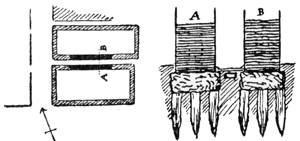
Fig. 28.
It has been mentioned above how in several cases, as is clear even from our imperfect records, that later walls were founded directly on Roman walls. Modern buildings were thus in direct and unbroken succession to Roman ones and maintained the same alignment. In the Archer collection at the British Museum is a drawing of “a Roman pavement and foundations, supposed to be remains of Tower Royal” in Cannon Street; this again was square with modern work. Roman remains have been found under several churches. Massive walls of chalk were found under St. Benet’s, Gracechurch. Roach Smith, speaking of a floor found at the corner 54of Clement’s Lane, says: “This adds another to the numerous instances of churches in London standing on foundations of Roman buildings.” In 1724 Roman foundations were found under St. Mary, Woolnoth, and “three foundations of churches in the same place” (Minutes Soc. Ant., June 17). Even Westminster Abbey and St. Martin’s in the Fields were built on Roman sites, and so probably was St. Andrew’s, Holborn.
This continuity of the buildings from the Roman Age is not only an interesting fact, but it is a strong argument for the general continuity of the street lines as well. The plan of the extensive finds in and about Lombard Street in 1785 shows the building to have conformed very much to lines parallel with, and at right angles to St. Swithin, Sherborne, Abchurch, Nicholas, Birchin and Clement’s Lanes, and I cannot doubt that these lanes are in some degree the successors of Roman streets. In “Lombard Street and Birchin Lane the discoveries are said to have indicated a row of houses” (V.C.H.). If all the evidence as to the “orientation” of buildings and walls was laid down on a plan, merely marking the direction of the minor ones with a cross, we might build up further results in regard to the direction of the streets. At the same time it would be vain to expect any large and simple scheme of lay-out of the chess-board type, the Walbrook and other streams, and probably the persistence of some earlier lines (Watling Street to St. Albans?) would have interfered with that. The Walbrook seems to have been crossed by two chief bridges, which must have been governing facts in the lay-out. One was at Bucklersbury, the other, Horseshoe Bridge farther south, is recorded from the thirteenth 55century. Cannon Street, I cannot doubt, represents one east to west street. Thames Street must have been formed when the south City Wall was built. I have spoken of the north-south lines above. Saint Benet “Gerschereche” is mentioned in a charter of 1053 (Athen., February 3, 1906).
Wren found a “causeway” made up of stones and tiles by Bow Church (under the present tower). It is suggested in V.C.H. that this was an embankment, but causeway was one of the regular names for a Roman road. At Rochester one 5 ft. or 6 ft. thick of hard stuff has been found crossing some soft ground.
The best way now to see again the old Roman City of London is to go to the foot of the hill below St. Magnus the Martyr and then, turning away from the riverside quays of the seaport, to walk up the street which still retains something of the look of a High Street in an old market town. Behind it we may still discern the ghost of the Roman Axis Street. Right and left are narrow streets with red plastered houses separated by little “drangways.” Here at a corner is a small temple with a dedication to the deified emperor. There is the great City Bath. Farther on is the civic centre, the market-place and hall; one, a square piazza containing imperial statues in gilt bronze, and the other a big building having internal ranks of tall Corinthian columns, a wide apse, and an open timber roof—sombre but noble. Round about are many isolated and widespreading mansions, one doubtless being the palace of the Governor of the province. Beyond are the walls and gates which will be next described, and in the background rise the northern heaths 56and wooded hills now called Hampstead and Highgate.
“Gem of all Joy and Jasper of Jocundity, Strong be thy walls that about thee stand; London, thou art the flower of cities all.”
THE walls, gates and bastions of the City may be traced by the record of early maps such as that of Braun and Hogenberg. The bastions of the east side are particularly shown on a plan of Holy Trinity Priory made in the sixteenth century; the west side from Ludgate to Cripplegate plainly appears in Hollar’s plan after the fire, 1667. There were two bastions between Ludgate and Newgate, then an angle bastion to the north; three more on the straight length to Aldersgate, then one beyond that gate at the angle where the wall turned north again; two bastions occurred between this angle and the bastion at the corner where the wall again turned east, which now exists in Cripplegate Churchyard.
Several of the gates stood until 1760. In an old MS. book of notes I find under the heading “Remarkable Transactions in ye Mayoralty of Sir J. Chitty.”—“In July, ye gates of Aldgate, Cripplegate and Ludgate were sold by public auction in ye council chamber, Guildhall, and were accordingly taken down without obstructing 58either ye foot or cartway, and their sites laid into ye streets. Aldgate for £157, 10s.; Cripplegate, £93; and Ludgate for £148.” Many old drawings of parts of the wall are preserved in the Crace, the Archer and other collections. The exact line of the wall and positions of the bastions has been verified by modern excavations and discoveries. For full description and a plan, see the Victoria County History and Archæologia, lxii. (1912). A good description of what was visible in 1855 is given in The Builder for that year.
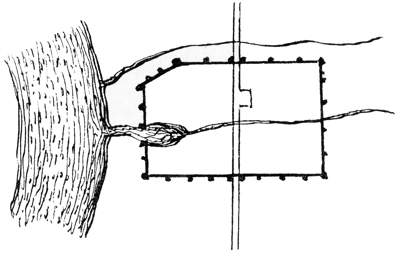
Fig. 29. See p. 61.
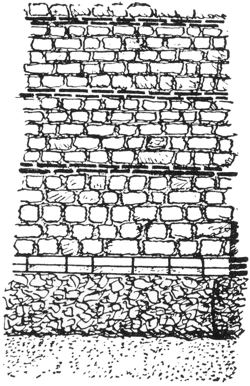
Fig. 30.
In September 1903 an important section of the Roman wall was found in excavating the site of Newgate Prison; in some parts it was about a dozen feet high. I saw it in October and noted—“The wall is about 8½ ft. wide. On the outside and inside one or two courses of facing stones were first raised and the core of rubble was then filled in to that height; first there was a thick couch of mortar, then a layer of rubble stones, then 59another liberal supply of mortar running down between the stones as grout; there were two or three such levellings-up in the heights between the tile bonding courses.” The wall had a rough rubble foundation, then a course of plinth stones on the outside, with three tile courses corresponding to it on the inside of the wall, then followed five courses of the fairly square facing stones on both sides of the wall, then two rows of tile, five courses more stone and two rows of tile, then five more stone courses; above this level the wall had been destroyed. The stones and tiles were set in mortar, and the latter, except for the three courses at the bottom on the inside, which served as a plinth, were carried right through the thickness of the wall; the “tiles” were Roman bricks about 18 in. by 12 in. and 1½ in. thick, laid in what we call Flemish bond. The stone facing courses were a little higher at the bottom than upwards, but all were comparatively small and square; there was a clear distinction between the wrought facings and the rubble filling, which was practically concrete. The “facings” were hard skins adhering 60to the filling and required by the method of building as described above (Fig. 30).
The mode of construction of the wall is likely to be misunderstood when we speak as we almost necessarily do of facings and filling and of bond tiles. The “facing” stones were small, roughly wrought, and set in much mortar; they formed outer skins to the concreted mass into which they tailed back. The whole was homogeneous. The method was analogous to the facing of concrete with triangular bricks notching back into the core.
The tile courses in the City Wall were doubtless bonds, but they also divided the wall into strata locking up the moisture of the mortar from too rapid absorption and evaporation. I have little doubt that the wall was carried up a stratum at a time over long lengths; it would thus have been available as a defence from an early stage, and scaffolding would not have been required. The building of this wall and casting the ditch about it required a great constructive effort. A strip of ground some 100 feet wide must have been cleared as a preliminary. Then the immense quantity of stone required would have been brought by ships and barges. It is often said that old material was not re-used in the wall, but I can hardly think that two miles of chamfered plinth had to be provided out of new stone at the very beginning of the work. And material from destroyed monuments was doubtless broken up for the small facing stones. The lime-burning, brick-making, stone-cutting, as well as the actual building, called for much labour. It would be interesting to have the quantities taken out and an estimate prepared.
The south wall along the river front is well 61described in V.C.H. Roach Smith, in an article in vol. i. of the Archæological Journal, recorded the fact that it had “alternate layers of red and yellow plain and curve-edged (i.e. flanged) tiles”; the rest being of ragstone and flint. It was founded on piles. In The Builder (January 19, 1912) it is recorded that in digging for a foundation at No. 125 Lower Thames Street, between Fish Street Hill and Pudding Lane, there was found the base of the Roman wall resting upon long and thick timber balks laid crosswise, with piles beneath them; there were three courses of rough rag and sandstone capped with two courses of yellow bonding tiles, all in reddish mortar; what remained was about 3 ft. high and 10 ft. wide, and was at 24 ft. below the existing pavement. Full evidence of the course of the City Wall along the river front has been found (Archæol. xliii.). It may be noticed that in mediæval regulations foreign sailors might not go beyond Thames Street; that is, pass where the wall had been, into the City proper. This south wall, like the bastions, contained remnants of Roman monuments.
The south wall would have been interrupted at the outlet of the Walbrook, which must have been a tidal creek. This was doubtless the original harbour, and there would have been quays within the line of the wall. Daremberg and Saglio’s plan of Bordeaux shows a remarkable parallel to Londinium, standing on the bank of a great river, flanked by a little stream and with a port within the walls (Fig. 29). It seems probable that the strong wall which Roach Smith reports as having been found on the east side of the Walbrook may have been a quay wall. The Thames has been 62much encroached on where it passes the City. In making the approach to new London Bridge three successive embankments were found, one being of squared trunks of trees. A similar timber wall has just been found in Miles Lane. In Lower Thames Street the Roman house found on its north side was built on piles, “probably on the river bank” (Athen., 1848), and the south City Wall was wholly built on timbering. In earlier Londinium, Cannon Street must have been the southern thoroughfare.
Bastions.—In July 1909, when the angle bastion near Giltspur Street was excavated, I noted that close to it the City Wall was badly fractured, and inclined outwards; there had evidently been a serious settlement here, which was sufficiently accounted for by the nature of the ground—wet clay on the bank of a stream. The wall was taken lower than the ordinary level here, and the bastion was founded at a lower level still. The bastion was not bonded to the City Wall, but merely built against it with a straight joint; it was of horseshoe shape on plan and projected about 27 ft., the masonry was rubble in thin courses, and the whole looked mediæval to me. In the careful report in Archæologia it was said that some evidence for Roman date was discovered in the foundation. The facts suggested to me not only that the bastion had been built against the wall, but that it was probably built at a point of failure in the original wall. It is agreed that the bastions were built later than the wall, and with a straight joint between them and it, and I would suggest that they were built to cover cracks and form buttresses as well as for their additional defensive value, and this 63may very well have been the general procedure. It would have been impossible to build a wall measured by miles on inferior foundations without bad settlements; the Egyptians provided for them by building such walls in sections with inclined straight joints at intervals.
M. Blanchet, writing of the walls of the cities of Gaul, says: “Often the curtains are not bonded with the towers. This independence reminds one of a precept of Philo’s, which advises that the method should be followed so as to prevent the consequences of unequal settlement between the two. But there is a more simple explanation—the town under immediate danger ensures itself first with the curtain and adds the towers after. Most of the fortifications are those which the Romans built on the approach of the Barbarian invasions. To this period belong the walls of Rome and those of the cities of Gaul.” Choisy again has an interesting account of the towers of the walls of Constantinople, with a diagram of arches in the sides of the towers at the ground level, which were built so that the effective part of their foundations should be kept clear of the wall. Now, the foundations of the London bastions provide evidence of a similar way of thinking.
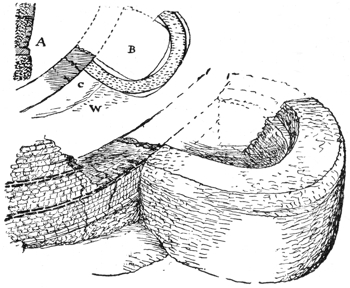
Fig. 31.
In Fig. 31 I give a sketch of this angle bastion made on July 5, 1909. Here is seen the City Wall curving round from the north to the west, and against it the bastion. The Roman wall was badly cracked and leaning outward (A); in the corner by the bastion the plinth and the foundation are seen, and below a sloping bank of wet clay (C), and farther out water (W). The bastion was built of rubble, and was hollow to the base; the form was 64different below and above (see B). In the sketch the tile courses are seen going through the thickness of the wall.
The bastions which have been most carefully examined are those on the site of the General Post Office, described in Archæologia, lxiii. (1912). One is said to have been built in “the usual manner of random rubble”; it was separate from the City Wall, and the foundation was deeper than that of the wall. A second was built in a very soft spot. “Why it should have been selected is not easy to see, as at a little distance either way the builders could have found firm soil.” Its site was an old stream bed, and the conditions might well be the cause of a settlement at the point. This, as suggested 65above, may have been the reason the bastion was erected just here. (For the bastion by Giltspur Street, see S. A. Proceedings, 2 S. xxii. 476.)

Fig. 32.
Nothing very definitely Roman was found in these bastions, but one at All Hallows was certainly Roman. This is described as (I condense) “built of stonework which, like the rest, so far as they have been observed, is of random rubble, built principally of irregular pieces and ragstone with portions of Roman tile (none complete) and other material; much of it appears to have done duty in some previous building. A base was formed of large square stones a uniform height of 2 ft.; they had been employed in some former building; several had lewis holes. This base rested on a table of large flat stones 9 in. thick. Most of these seem to have been portions of a cornice. Roman origin was shown by red mortar in which the joints had been set.” The foundation was about 3 ft. below that of the City Wall, and projected into the original Roman ditch. What is called the “table” above was a square-fronted lower base; the back of this base was set in advance of the City Wall; indeed, it was 3 ft. in front of it on the eastern side and “the gravel in this intervening space was undisturbed.” This gap is specially to be noted. The description of the masonry as random rubble must apply mainly to the core of the work, for the illustrations show an approximation to courses on the face; indeed, on the east side, thirteen courses may be counted in the photograph up to a line which seems to be the top of a sloping plinth; these courses averaged about 4½ in. high. The full significance of this account is only brought out on comparing it with Price’s description of what was found in excavating the 66Camomile Street bastion. This bastion was founded on two deep courses of heavy stones taken from Roman buildings, many sculptured, and having lewis holes in them. These masonry courses were set 1½ ft. in advance of the City Wall, one over the other, forming a straight joint, and leaving a gap “separated from the wall by an intervening space filled with rubble” (Price) which was filled with small stones. This curious and carefully-arranged construction in both bastions was clearly with the object of making the foundations of the bastions take their bearings away from the wall so that they would tend to lean inwards against the wall; it is analogous to the arches of the Constantinople towers. This bastion had a batter or slope at the bottom of about 4 ft. high. Price describes the masonry as “rag rubble walling faced with random courses. The size of the blocks of which the facing was composed varied from 3 in. to 8½ in. thick [high] and from 5 in. to 14 in. long.” This account is supported by the carefully-executed illustrations which show coursed facings of small stones which seem almost identical with the facings of the City Wall. Such masonry of small facing “blocks” with concreted rubble behind is certainly Roman. The masonry at the All Hallows bastion seems to have approximated to the same character; there it may be noticed the courses became narrower upwards. This was certainly not so regular as the masonry of the City Wall, but it may be said to have resembled it (Fig. 32).
67At the Guildhall Museum is “a group of architectural remains and fragments of sculptured stones from tombs, public buildings, etc., found in a bastion of London Wall, Duke Street, Aldgate, 1881.” This find is best described in The Athenæum for that year. Mr. Watkins, while excavating in Houndsditch and Duke Street, found the City Wall and a mass of masonry extending 18 ft. outward from the wall; the stones were dressed and weighed from 1 cwt. to 1½ tons. “In the structure he observed a channel 15 in. deep by 18 in. wide, which showed signs of use as a watercourse. It had been filled with concrete composed of chalk and flints. The site was the foundation of one of the bastions composed of sculptured stones in character similar to those previously recorded, upwards of twenty in number.” This was the second bastion east of Bishopsgate. The channel filled with concrete suggests a gap dividing the bastion from the City Wall as already described; but see also account in V.C.H.
In 1887 Mr. Loftus Brock reported to the British Archæological Association the removal of part of the City Wall on the east side of Wormwood Street. Nearly opposite Bevis Marks Synagogue the foundation of a circular-fronted bastion was found of worked freestones and not bonded into the main wall (The Builder, May 28, 1887). A paper by J. E. Price in 1884 (London and Middlesex Archæol. Soc.) referred to the discovery of a bastion containing several sculptured stones in St. Mary Axe (The Builder, November 22, 1884, and compare V.C.H.).

Fig. 33.
In 1852 an excavation was made against the outside of the City Wall on Tower Hill, and a 68number of large wrought and carved stones were found (The Builder, September 4, 1852) (Fig. 33). In an account given in the Journal of the British Archæological Association the workmen are said to have discovered a “complete quarry of stones cut in various forms and evidently belonging to some important building ... 125 making 40 cart loads.” Fairholt made an etching of the place while the work was in progress, which shows that the 69“quarry” was heaped against the external face of the wall like the bases of the other bastions, and that, in fact, it was a ruined bastion Fig. 34 from Roach Smith’s Roman London, slightly modified). Another account is given in the Antiquarian Etching Club by A. H. Burkitt, with a plate: “These interesting remains were discovered during the excavations in June 1852, which laid bare the wall to its base. The various portions of stone, which amounted to about forty cart loads, bear evidence of having belonged to an important building. The inscription and band of laurel leaves, which probably formed an ornament above it, indicate a monument of considerable magnitude to the memory of a commander of the Roman Navy. There were found at the same time fragments of frescoes with inscriptions.” (In Fig. 33 the fragment with laurel leaves is represented upside down.)
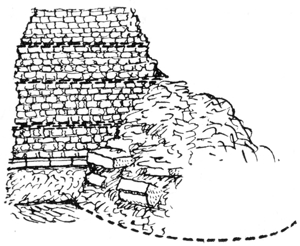
Fig. 34.
The two stones specially mentioned are now in the British Museum. It appears from the accounts and illustrations that this bastion was 70built against the wall without being bonded to it in the lower part, that its foundation was formed of large carved and moulded stones, and was at a lower level than that of the wall. (The part below the plinth in Fig. 34 on the left is rough foundation.)
We thus have clear record that several of the bastions on the east and north sides of the City were constructed in a similar way. Those farther west near the Post Office were probably rebuilt in mediæval times. These were hollow at the base, not solid like the others.
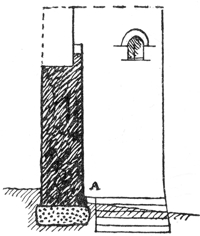
Fig. 35.
The towers of the city wall of Carcassone, described by Viollet le Duc (Dict., vol. i.), were so similar in construction that it is plain our bastions were constructed according to general custom. In the illustration we see big stones at the base of the bastion only; large window-like openings closed with woodwork above; and an upper storey rising higher than the wall top. Fig. 35 is a suggested restoration of one of the London bastions, showing the foundation gap A, and an upper storey overlapping the City Wall.
It is probable that most, or all, of the bastions from Tower Hill to Cripplegate were built in the same way as those just described, and there is evidence to suggest that the western bastions were also similar. In 1806 fragments of Roman monuments were found near Ludgate; “these may have 71come from a later Roman gate or from the adjoining bastion” (V.C.H.). Allen says: “At the back of the London Coffee-house, Ludgate Hill, a circular tower and staircase was discovered; and about 3 ft. below the pavement some remains of Roman art were found.” An etching of the stones published by T. Fisher in 1807 describes them as “dug out of the foundations of the wall of the City, a few yards north of Ludgate.” Archer, speaking of an inscribed pedestal, says it was found “in extending the premises at the back of the London Coffee-house. It appeared in a bastion of the City Wall, and was built in with the masonry near some remains of a circular staircase” (Illust. Family Jour., c. 1850). Now, Horwood’s plan of 1799 shows the back of the Coffee-house adjoining the line of the old wall and extending a long way north—apparently much more than sufficient to overlap the bastion numbered 55 on Mr. Reader’s plan. The Post Office excavations recently made down Ludgate Hill show that the natural ground is here only about 10 ft. below the modern level.
The Camomile Street and All Hallows bastions were about 20 ft. wide and projected about 16 ft. In mediæval days the bastions rose above the parapet walk on the main wall, and each formed a round-ended chamber having loopholes. This is well shown on the Survey of Holy Trinity, Aldgate, 1592, which I published about 1900 in Middlesex Notes and Queries. (Several round-fronted bastions are planned as well as Aldgate itself.) The mediæval arrangement, I have no doubt, followed the Roman scheme. The openings in the original bastions would, we may suppose, have been wider than mediæval loops, and have had semicircular arches 72of brick over them. (See Viollet le Duc’s Dictionary, vol. i. p. 333.) The walls and bastions which still exist at Le Mans and Senlis more closely resemble those of Londinium than any others I have seen. At Le Mans a long portion fronting, but some way back from the river Sarthe, has three bastions 60 yds. to 70 yds. apart, round on the front about 20 ft. wide, and 15 in. or 16 in. projection. The curtain is about 30 ft. high, and the bastions rise higher—say, to 45 ft.; they rise sloping for some way from the ground (Fig. 36). The bastions at Senlis are very similar, but some of these have two storeys of large openings, three in each.

Fig. 36.
For a long time it was argued that the bastions of the Wall of London were mediæval; then very considerable difference of construction from the City Wall has been alleged. It has been said that their masonry was unlike the other, and that there were no tile bands. We only know with any 73certainty the lower parts of the bastions now recognised as Roman, and there is no reason for asserting that there were no tile bands in the upper parts. The bastion illustrated by Roach Smith from a sketch by Gough had bands of brick, but in the illustration this bastion appears as square, and this is unlikely (see Archæol. lxiii.). It is possible, however, that the form is a misreading of a rough sketch. This, I think, is more likely than the suggestion in V.C.H. that it was mediæval. An illustration of a round-fronted bastion near Falcon Square given by Thornbury (Old and New London), shows two bands of tile. This seems to be bastion 40 of V.C.H., which was about 40 ft. high; “in the upper part was a row of tile-brick, probably due to later patching.” There are also some other references to tiles in bastions, and on the whole I conclude that they probably had tile bands more or less like the wall. Both the bastion just mentioned and that of Gough’s sketch had openings below the upper storey, showing that in these bastions there were chambers below the level of the parapet. So there must have been at Le Mans (Fig. 36) and Senlis. Compare also V. le Duc’s Dictionary, vol. i. p. 333.
In an article on the City Walls in the Journal of the London Society (November 1922), Dr. Norman says: “Last summer the remains of another bastion were laid bare not far from the west end of the Church of St. Anne and St. Agnes.” This was “the inner angle bastion” near Aldersgate.
It is not exactly known when the City was protected by walls. Stow says: “It seemeth not to have been walled in the year of our Lord 296, because in that year the Franks easily entered 74London.” He accepted the legend that “Helen, the mother of Constantine, first enwalled this City.” Camden held the same view, and has a note: “Coins of Helena often found under the walls.”
It is now agreed that the walls were built around a late and extended city, for rubbish pits and burials have been found within the walls. A belt of the former occupied the site of St. Paul’s and the Post Office. It was Roach Smith’s impression that the walls were probably built “after the recovery of the province by Constantine, or even later, when Theodosius restored the towns” (Archæol. Jour., 1844).
Mr. Lambert, from planning the find-spots of Roman coins, comes to the conclusion that the wall was not in its later position until the fourth century. The type of walling is especially characteristic of the fourth century. Haverfield has pointed out some earlier cases of the use of bonding tiles, but these seem to be exceptional. (See also what is said of Colchester in J.R.S., 1919.) Daremberg and Saglio give 309 as the date of the earliest wall of our kind in Rome. (They illustrate an example from Timgad, in North Africa, which closely resembles the wall of London.) I suggest that a point of evidence may be found in the Constantinian coin, which has a city gate or fortification for device, and the inscription PROVIDENTIAE CAESS, with the mint mark of London (Fig. 37). This device was not invented for London, but I cannot think that at such a time it could have been adopted if Londinium still remained an open city—it would have invited too obvious irony after what had happened in 296. This coin was issued 75between 320 and 324, and I suggest that it may be accepted as a record of the walling of the City, or, perhaps more probably, the beginning of the works. The coins of Helen mentioned by Camden were issued about this time. In the later half of the fourth-century London acquired the title of Augusta, and this change of style probably followed on the change of status of its having then been completely walled. (I find that Mr. Reg. Smith has already made this same suggestion in V.C.H.) Sir Arthur Evans has recently called attention to a silver coin of Valentinian the Elder as having in an abbreviated form the monetary stamp of Londinensis Augusta. “A group of coins shows that the Mint at London, which had been closed since the time of Constantine, was restored by Valentinian in A.D. 368” (Proceedings, S. A., 1915, p. 105). I suggest that this is a probable date for the completion of the river wall. Several of the cities of Gaul were protected by walls at a still later time.
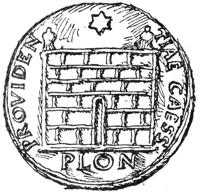
Fig. 37.
Many of the carved fragments found in the bastions can be little earlier than the year A.D. 300. The important monuments of which remnants have been found must have been destroyed when the long, wide strip required for the original wall and its ditch was cleared, for the bastions themselves did not go beyond this ground. It seems possible that the big stones were reserved for founding 76bastions; this is more likely than that distant monuments were destroyed to provide foundation stones.
“To put an end to incessant pillage the Gallo-Roman towns sacrificed their faubourgs, and, retrenching their extent, surrounded themselves with strong walls, which were very often supported on sculptured blocks taken from destroyed edifices. Le Mans, like the towns of Senlis, Tours, Autun, Bourges, Fréjus, etc., girded itself with ramparts flanked with round-fronted towers, of which important remains still exist, especially along the river Sarthe. The enceinte of Le Mans enclosed an area about 500 by 200 metres” (A. Ledru, 1900).

Fig. 38.
Gates.—The excavations of 1903 at the Old Bailey revealed some remnants of the Roman gate on the site of Newgate. The most significant of these was a portion of plinth on the City side, with a return at the south end. This, as shown in Archæologia, lix., by Dr. P. Norman, when linked up with earlier discoveries made in 1875, allowed of the recovery of the plan of the gate (Fig. 38). The plinth had been removed from its place before I saw it, but the stones were certainly shaped in Roman days; they had a chamfer 8 in. wide, with a square face of similar width below, and they had been strongly cramped together; one had a “return end,” and clearly came from a corner (A and B). A portion of the western plinth was discovered in 1909 (Archæol. lxiii.). The gate, with its towers on either side, had a frontage of about 96 ft.—probably 100 Roman feet, as a Roman 77foot was about 11·60 in. The space between the towers appears to have been about 35 ft., which is not more than sufficient for two large archways. The great gate at Colchester, which was about 107 ft. wide, had two carriage-ways 17 ft. wide, and two small side openings 6 ft. wide as well (see J.R.S., 1919). Enough of the walling was found in 1875 to show that the London gate was of stone bonded with tiles; it was erected on a thick platform of “clay and ragstone,” which raised the plinth about 5 ft. above the plinth of the adjoining City Wall. Fig. 39 is a restoration of the front.

Fig. 39.
Several years ago a mass of masonry with a face to the south was found under Bishopsgate Street a little within the line of the wall; underlying it was “puddling of flint and clay” over a wide area. It was suggested at the time (Archæeol. lx. p. 58) that this masonry and foundation might have belonged to Roman Bishopsgate, and the finding of what seems to have been a similar platform at Newgate strengthens the hypothesis. It had long ago been pointed out by T. Wright that the gate at Lymne was raised on a platform of big stones. At Lymne and Pevensey entrance gates had round-fronted towers, and the great gate at Colchester had quadrants.
Mediæval Aldgate had two round-fronted towers; these are shown in the Survey of Holy Trinity Priory mentioned above, and they are so similar to the bastions of the wall that I was led to suggest that the double gateway and towers were 78probably substantially Roman work (Fig. 40). Some confirmation of this is given in V.C.H., but compare Archæologia, xliii. Fitzstephen, writing at the end of the twelfth century, says that London had “double gates,” and this was doubtless so from Roman days.

Fig. 40.
The Roman ditch outside Aldersgate, with a foundation for a bridge pointing towards the gate, was found about thirty years ago, and this is evidence for a Roman gate on this site (Archæol. lii.). Ludgate is guaranteed as Roman by the antiquity of the Strand and Fleet Street. Stow says that in 1595 he observed on the north side of Fleet Street from Chancery Lane to St. Dunstan’s Church, 4 ft. below the surface, “a pavement of hard stone, more sufficient than the first, under which they found in the made ground piles of timber almost close together, the same being black as pitch and rotten, which proved that the ground there, as sundry other places of the City, had been a marsh.” Close piling was such a common Roman procedure that it may not be doubted that what Stow observed was the Roman road to Ludgate.
Mediæval Aldgate can be restored very fully by comparing the plan mentioned above with the view of the City given by Braun and Hogenberg (c. 1550). The gate is so accurately represented that two stair turrets appear over the positions where stairs are 79shown in the plan. If this gate is so accurately drawn, then the other indications may be accepted. In the Pepys collection, Cambridge, is an engraved view of a gate dated 1688; in the list of contents this is described as Cripplegate, but I believe it is rather Bishopsgate. It was an unaltered mediæval structure, with corbelled battlements and three statues in niches, one on each of the towers and one in the centre. Newgate is also represented in a woodcut view of about the same time, and in an engraving of considerable accuracy, from a book entitled Herba Parietis; here even Whittington’s coat-of-arms plainly appears. For a possible view of the Bridge gate, c. 1416, see an article by Mr. Weale in the Burlington Magazine, 1904.
A Roman road on piles has recently been found in Southwark (Archæol. lxiii.). Adding the Bridge gate, we now have evidence for the existence in Roman days of the six chief gates of Londinium. It has been suggested that there may have been an earth bank inside the walls, as at Silchester, but the different relation of the fronts of the gates to the walls in London are contrary arguments.
Ditches.—When the site of Newgate was excavated I saw the slope of the ditch clearly defined by the blacker earth lying above the clean yellow gravel. The latest and clearest account of the ditches is in Archæologia, lxiii. There was first a narrow V-shaped ditch dug when the wall was first built. A second wider ditch was excavated outside the other, which was at least partly filled when the bastions were built. There were similar double ditches at Silchester, and it has been pointed out that there the earlier V-shaped ditch probably supplied the gravel for building the wall; possibly 80this was the case at London too. The wide ditch was probably further expanded in front of the gates; it was about 75 ft. wide at the top of the bank outside Aldersgate.
The Original Port of London and the Bridge.—The space within the completed walls has been computed to have been about 330 acres by Dr. Philip Norman. Dr. Haverfield says: “At London, Silchester, Trier, Cologne, the walls seem to have enclosed the town at near its largest” (Romanization). Roach Smith first remarked that from the position of burials within the area of the City we might infer the position of an earlier Londinium. Loftus Brock also, following Woodward, in pointing out that the northern cemetery had come within the space enclosed by the City Wall at Bishopsgate, used the same argument. Mr. Reginald Smith plotted all the known burials on a plan. Mr. Lambert has also laid down the find spots of coins of different dates. In his recent paper in Archæology he suggests that a stratum of charred material between London Bridge and the Walbrook represents the early Londinium destroyed by Boadicea. A large number of rubbish pits have been found within the walls. Putting these facts together it is evident that the original site of Londinium must have been by the inlet of the Walbrook, and it is probable that this little tidal creek was the first port of London—the seaport of Celtic Verulam, to which an old road led by Aldersgate and Islington. It is likely that before the Roman walls were built some defensive bank would have been thrown up between the Fleet and the Walbrook; compare the earth banks at Colchester. Can Barbican represent such a defence?
81London Bridge is mentioned in the tenth century. Stow tells us that it was first of timber. Then in 1067 a charter speaks of “Botolph’s Gate, with a wharf which was at the head of London Bridge.” He goes on: “About the year 1176 the stone bridge was begun near unto the bridge of timber, but towards the west, for Botolph’s wharf was, in the Conqueror’s time, at the head of London Bridge.”
Nothing was known of a Roman bridge until last century. Then when the old stone bridge was destroyed evidence was found which convinced observers of the time that a Roman bridge had preceded it on the same line. Recently some writers, while accepting the Roman bridge as proved, have preferred to put it back to Stow’s line. Haverfield says: “No traces of a Roman bridge have yet been found (Archæologia, lx.): the oldest mediæval bridge (eleventh century) is said by Stow to have been near Botolph’s wharf (see plan).” This plan shows the bridge “temp. William the Conqueror” far to the east of Fish Street Hill (see also V.C.H.). Exactly what Haverfield meant by saying that no traces of the bridge had been found is hard to say; it seems to have been as loose a statement as the one which seems to imply that the earliest mediæval bridge was of the eleventh century.
Roach Smith, a cautious observer, was entirely convinced by the evidence that the mediæval bridge followed the course of the Roman bridge. “Throughout the line of the old bridge many thousands of Roman coins, with abundance of Roman pottery, were discovered, and beneath some of the central piles brass medallions of Aurelius, Faustina and Commodus. The enormous quantity 82of Roman coins may be accounted for by the practice of the Romans ... they may have been deposited upon the building or repairs of the bridge, as well as upon the accession of a new emperor.... The beautiful works of art which were discovered alongside the foundations, the colossal bronze head of Hadrian, the bronze images of Apollo, Mercury, Atys ... and other relics were possibly thrown into the river by early Christians” (Archæol. Jour., vol. i.). This seems substantial evidence. The charter cited by Stow only speaks of a wharf as being at the head of London Bridge; it does not tell us that the bridge ran into the middle of the wharf. The Roman bridge was linked up with an approach from the south over a raised causeway; the bridge-ends would have required much consolidation, and the foundations in the great tidal river must have been extremely difficult to construct. We should need very clear demonstration before we could believe that the early Saxons did more than patch up the work of skilled Roman engineers. Altering of the bridge to the Gracechurch Street line on the City side in 1176 would have meant replanning on a big scale. The ancient line of approach on the south side is guaranteed by the area of Roman finds (see V.C.H. plan). Gracechurch Street is known to have existed before the Conquest, and the positions of the ancient churches of St. Magnus’s and St. Olaf’s at each end of the bridge are significant: the bridge, I believe, was in the parishes of these two churches.
Much more might be said, but I cannot think it is necessary. I conclude that the Roman bridge followed the line between the “Borough” and 83Gracechurch Street, and that the phrase in the charter was nothing more than a general indication of the position of the wharf.
After the building of the Roman bridge, Billingsgate may have succeeded the Walbrook creek as the chief port of London.
One of the sights of Londinium which may best be imagined is the approach over the bridge. Or we may think of the ring of turreted walls of the City by the river as seen from the northern heights. Or, again, we may think of the sights from the walk on the City Walls; the Kent hills beyond the Thames estuary, with ships coming up to make fast at Dowgate; then, turning to look inward over the City, we may imagine the narrow streets and plastered, red-tiled, houses. It must have been grim and grey when the roofs were covered with snow, and we may wonder what dwellers from the south thought of our fogs. Yet Londinium was a romantic city, a little Rome in the west, and we want some good story about it which shall bring it out of archæology into the minds of the citizens and the hearts of the children.
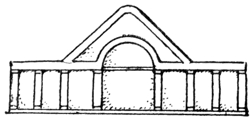
From a Carving on an Altar at Risingham.
“O more than mortal man that did this town begin, Whose knowledge found the plot so fit to set it in. Built on a rising bank within a vale to stand, And for thy healthful soil chose gravel mixed with sand.”
THE site of London by a noble tidal river, or rather at the head of a long estuary, on clean gravel ground intersected with streams, was well chosen. The ground was open heath with scrubby vegetation, except for woods here and there where the soil was suitable. Sir Thomas More planned his “Utopia” on a site similar to that of London. The buildings of London have spoilt an excellent golf course! The walled city set down in the fair land must have been beautiful indeed, as seen from the Hampstead or Surrey hills. On approaching the turreted walls by the straight and narrow roads, the traveller would have had to pass through a wide belt of cemeteries. Around Londinium in its later state, the gardens of the dead would have come right up to the city ditch, just as at Constantinople the beautiful Turkish cemeteries, with their noble cypresses, lie close beside the walls of the city.
“Around Rome was a great belt of cemeteries; the sides of the main roads issuing from the gates 85were especially favoured sites; the chief region of all was that crossed by the Via Appia and Via Latina” (Lanciani).
“An immense field of the dead had extended all along the north-eastern quarter of ancient London, from Wapping Marsh to the fen beyond Moorfields” (C. Knight).
Goodman’s Fields, Moorfields, Spitalfields, were all cemeteries, and it is curious that they all have in common the name of fields. In the valley of the Fleet River by Ludgate and Blackfriars on the west were also cemeteries; and others lay beyond Southwark (Battersea Fields and St. George’s Fields?). The city of the dead must have been impressive on account of its extent and the number of its population, and doubtless it was beautiful. The harsh horror of modern cemeteries is a new thing on the earth. In antiquity, cemeteries had beauty, poetry, history.
The monuments of Londinium would have been of many kinds, small and big—columns, sculptures, mausolea, altar-tombs, tomb-houses, and steles or slabs. These tombs were not cold and pale, but profusely carved, and, doubtless, in most cases, coloured. The monuments in the museum at Trèves show many traces of colour—red, green and yellow, if I remember aright. Dr. Ashby recently described a huge Roman necropolis at Syracuse in words which might apply to Londinium. “Fragments of memorials were found, varying from simple steles and columns to the chapel with rich architectural forms, the decorative portions being in soft limestone with considerable traces of polychromy.” Painting over coarse soft stone was a general tradition, and bright colour liberally applied would greatly 86change the aspect of rather crude carvings. At Bath an inscription mentions the repair and repainting of a building. This might be internal painting, but it was an external inscription and probably included outside work. The Corinthian temple at Bath was decorated with colour on the exterior. Mr. Irvine says of a piece of the cornice: “Considerable portions of the red paint with which it had been covered remained among the carving.”
Finds of burials are still not infrequent in London; as specimen cases I quote two recent newspaper clippings: “A workman excavating in Cannon Street Road, Stepney, has unearthed an urn containing bones at a depth of 2 ft. below the road level; Sir C. H. Read observed that it provided a link in the track of the Roman road eastward, as the custom was to deposit these urns at the sides of the roads” (December 19, 1919). “The discovery of two Roman urns in Mansell Street, Goodman’s Fields, is of considerable importance. The urns were found about 10 ft. below the garden of a house. Both contained inner cinerary urns with calcined remains. The perfect one resembles an ordinary jar with a cover; the outer urn is perfectly round, and has handles on each side by the mouth. It is believed that the site was that of a Roman villa; bricks and tiles having been discovered in other parts of the site” (1913). The urns are now in the London Museum.
The actual monuments once on the east of the City are represented by the fragments found in the Tower Hill bastion; those to the north, by the stones found in the Camomile Street and other bastions; those on the west, by the soldier’s monument found at Ludgate Hill by Wren, by later 87discoveries near Ludgate Hill, in 1806, and the fragment of the monument of Celsus found on the Blackfriars site.
Steles.—A memorial slab in the Guildhall Museum is particularly interesting, as it is obviously in the tradition of Hellenistic art. It is a true stele of the usual small scale, about 2 ft. wide and 2½ ft. high; it bears a relief sculpture of a soldier in a panel bordered by pilasters and finished with a pedimental top (Fig. 41). This broken slab is in the reserve collection and is not usually visible, nor is it in the catalogue; the supposition is that it was found in one of the bastions with so many other remnants of tombs. It must, I think, be one of the earliest Roman monuments discovered in London.
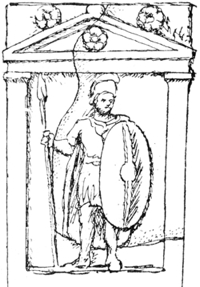
Fig. 41.
At the Guildhall is shown a sculptured slab thus described: “Monumental tablet, marble, bearing in relief the figure of a man armed with a trident and sword (?), and having a shield-like protection to the upper portion of his left arm; above is a fragmentary inscription; Greek; 21¾ × 15½ × 3½ in.: Tottenham Court Road.” It was illustrated in an early volume of Archæologia (xi. p. 48). On the original drawing at the Society of Antiquaries is written: “This white marble slab was found by Mr. Miller among the ruins of a 88house at Islington. It is now fixed up on the front of a warehouse in High Timber Street, near Labour-in-Vain Hill.” (This was south of Thames Street in the City.) The inscription is given by Hübner. With the writer in V.C.H., we may doubt whether this slab is not an importation like the Arundel Marbles; but other works in white marble will be described in this section, and gladiators were well known in Londinium (Fig. 42).
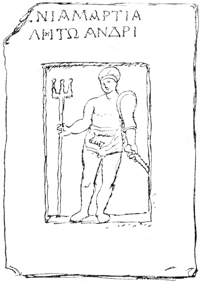
Fig. 42.
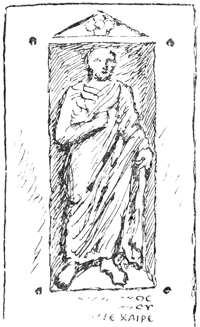
Fig. 43.
In the British Museum is a small stele with a well-carved relief of a man heavily draped in a dignified pose and classical taste, and also having a Greek inscription. This stone slab is little more than 1 ft. wide by about 2½ ft. high (Fig. 43). It was obtained in 1911, but it was drawn by Archer about eighty 89years ago. It was found in White’s Conduit Fields, that is, near Lamb’s Conduit Street. This, too, has a Greek inscription of which I can only make out the last word and a few other letters:
The last word is Farewell. I have felt some doubt as to this really pretty little work being a London antiquity. My sketch is given from Archer’s drawing. Although he may have restored it to some degree, it is probable that it has suffered from decay since he drew it. Other Greek inscriptions have been found in Britain.
There is another stele at the Guildhall which is so similar in several respects to the one just described that it might have been carved in the same shop. It is described in the catalogue as a “Monumental slab, limestone, on which is represented a figure of a man and child; the former is clothed in a toga, the folds of which he is holding in his left hand; 26 × 13½ × 2¼ in.” That two slabs so much alike should be discovered in one city, is a strong argument in favour of their having originated there. Notice, further, how the little pediment over the British Museum slab resembles that of the slab of the soldier first described. Again, the wide, plain margins are like those of the Gladiator slab. The evidence seems to be in favour of our accepting all the four slabs described as truly London works.
In the British Museum (the Roman corridor) is a tall inscribed slab of the headstone type, about 906½ ft. high (Fig. 44). We may see clearly that it is a descendant of the steles by noting a few little points. It has the side pilasters and a pediment on which some lumps carry on the tradition of acroteria. An inscription occupies the field where the steles have sculptured reliefs, and a lower space is occupied by a festoon. From the inscription, NA ATIENI, it seems that it commemorated a man born in Athens. This slab is especially like a large stele at Cirencester which had two panels, the upper one having a relief and the lower an inscription. Proportions, pilasters, pediment are all like our London slab. Haverfield assigned the Cirencester slab to the end of the first century, and the London one can only be a little later. The inscription terminates with the early formula: H[IC] S[ITUS] EST.
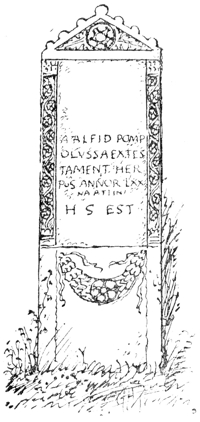
Fig. 44.
This slab is much weathered and it stands at the Museum in a bad light, where it is difficult to make out the details. Running stems, with flowers on the pilasters, are quite pretty (Fig. 45), and, indeed, the whole thing has dignity. The lettering was free and doubtless more elegant than the painted forms now suggest.
91Several larger memorial slabs have been found in London which had big reliefs of soldiers. One at the Guildhall and another at Oxford will be described under sculpture. There are two fragments in the British Museum which may stand for the type and be discussed here. One is a head a little less than life-size, part of a standing figure in a round-topped recess. Above is an inscription naming Celsus a speculator; it was found at Blackfriars in 1876 (The Builder). This much-injured fragment appears very rude, but the others of this class were competent works of sculpture. The second is only a head now in the upper gallery at the Museum; both were probably works of the first half of the second century. Four known examples of this type must represent many—perhaps dozens which once existed.
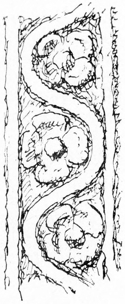
Fig. 45.
At the Guildhall is a fragment of sepulchral sculpture, which may have been part of a larger monument rather than of a stele, but I will speak of it here. Just enough remains to allow of the restoration of the 92scheme. A winged Cupid at the end of a panel which doubtless bore an inscription, would have been one of a pair. The Cupid holds an ivy-leaf, symbol of the grave, and above is a festoon with a bird perched on it (Fig. 46). Two or three grave slabs at Chester with reliefs of sepulchral banquets have similar festoons and birds which must have had symbolic reference to an after-life.

Fig. 46.
A much-battered fragment of relief sculpture at the Guildhall may, I think, be a remnant of a sepulchral banquet; it shows the upper part of a man in a recess with the point of what looks like the arm of the usual sofa-like bench behind him.
Chests and Coffins.—In earlier Roman Britain bodies were cremated and the ashes disposed in urns, lead boxes, and in other ways. There is in the British Museum a truly magnificent urn of hard porphyry-like stone which was found in Warwick Square. At the Guildhall is part of a sarcophagus-like chest about 2 ft. by 2½ ft. (Fig. 47). Its discovery was recorded by Price thus: “A coped stone of a marble tomb has been discovered near to the west door of St. Helen’s Church, Bishopsgate; associated with it was a coin of Constantine Junior, A.D. 317-340” (London and Middlesex Archæol. Soc. Trans., vol. v. 413). The material has shining particles, and seems to be white marble. 93In this respect it should be compared with the gladiator relief already described, and the fine Clapton sarcophagus mentioned below. The association with the coin must have been accidental, for this chest cannot, I think, be later than the second century. It would have contained an urn holding burnt bones; compare a rude stone cist from Harpenden in the British Museum.

Fig. 47.
An excellent account of London graves is given in V.C.H. Stow described the finds in Spitalfields in his day thus: “Divers coffins of stone, and the bones of men without coffins, and great nails of iron were found a quarter of a yard long. I beheld the bones of a man lying, his head north, and round about some such nails, wherefore I considered them to be the nails of his coffin.” Many plain coffins of stone have been found in the City and suburbs. In an old MSS. collection which I have, is the note: “About Dec. 1717, was taken up out of ye ground near ye new church of Rotherhithe, a stone coffin of prodigious size in which was ye skeleton of a man 10 foot long” (!). A Minute of the Society of Antiquaries (July 28, 1725) reads: “An ancient glass vase of bell-shape found in a stone coffin, 14 ft. under the ground by the portico of St. Martin’s Church [in the Fields]; ’tis now in Sir Hans Sloan’s collection.” The “vase” was doubtless one of the little ⊥-shaped bottles. Price described a stone coffin found in Fleet Lane nearly 8 ft. long, containing a skeleton in lime.
The wooden coffins must have been still more common. Conyers, about 1670, recorded the finding of one in an excavation at Fleet ditch. “About ye middle of the new ditch as low as ye bottom of ye old wall there were found an oak coffin turned 94black, of boards with bands, a man’s length from ye old ditch wall, upon the old wharfing, or, as I suppose, natural ground wharfed upon. In this coffin was a glass vial in ye fashion ⊥ [an expanded base with long neck], and brass like a hinge, these lay amongst the bones, the glass I have by me” (Conyer’s MS.). This was evidently one of the chests described by Mr. Ward: “Wooden coffins or chests were in common use, as the presence of iron nails, iron or bronze bindings, hinges, and other mountings prove.” An oak coffin was found in Moorfields in 1873, the objects from which are now in the British Museum.
Two stone coffins are preserved in the Guildhall collection. Two containing lead coffins were found at Pie Corner, St. Bartholomew’s, in 1877 (London and Middlesex Archæol. Soc. Trans., vol. v.). Lead coffins were usually ornamented, and will be further considered. It is probable that some of the coffins of wood and of stone were Christian burials.
The coffins of stone described were roughly wrought, and they were buried in the ground. Others, however, have been found which are handsome pieces of workmanship, and bear inscriptions.
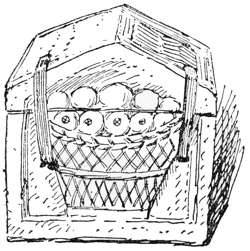
Fig. 48.
Three well-decorated stone sarcophagi found in London are at the Guildhall, the British Museum and Westminster Abbey. The sarcophagus at the Abbey is the earliest in style. It was found under the green at the angle between the north transept and the nave in 1869, and now rests by the entry to the Chapter House. On the cover is a large cross which seems to have been cut on the old stone in the twelfth century. Yet the evidence seems to have been against reuse in Christian times. It was the opinion, however, of the discoverers that it had been 95moved from its original site, but it was found close to the presumed Roman road to the river bank. The front has a panel with an inscription in excellent lettering, giving the name of Valerius, a superventor in the army, and beginning MEMORIAE. This form is found in two or three other British inscriptions, and was frequently used on tombs at Lyons. The Westminster inscription and the panel in which it is placed are of comparatively early style, and it is difficult to think that such work can be later than about A.D. 200. On the other hand, it is said that the new mode of burial at full length in a sarcophagus was not adopted in Britain until about A.D. 250. I do not suppose that our example is so late as this. The front may be compared with a slab in Edinburgh Museum, c. A.D. 160 (J.R.S., ii. p. 128). The Lyons inscriptions of a similar type are also of the age of the Antonines. Altogether, I cannot think that the Westminster tomb is later than A.D. 200. It is possible that it may first have contained cinerated remains and not have been a sarcophagus proper.
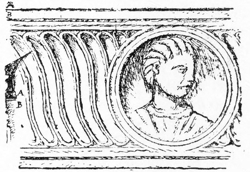
Fig. 49.
The sarcophagus at the British Museum was found in Haydon Square, Minories, the site of a part of a cemetery where in 1797 “many curious fragments of Roman pottery as well as glass vessels were discovered, and two complete urns with bone ashes, etc., were taken up.” This stone sarcophagus contained a lead coffin, now also in the British Museum. At the Society of Antiquaries is an accurate drawing of both made at the time of the discovery. The cover was securely clamped down with iron (Fig. 48). At the centre of the front is a simple medallion portrait head, the rest is filled with flutes (Fig. 49). The outer face of the cover, 96which slants up to a ridge, is carved with acanthus leaves (Fig. 50), the inner slanting side is plain, and this shows that it stood in a building or against a wall. At the two ends are carved baskets of fruits, and these must be symbolical (Fig. 48). This tomb had no inscription; it belonged to a time when inscriptions were few. Whether itself the tomb of a Christian or not, it is of a Christian type, and I should date it about A.D. 340.
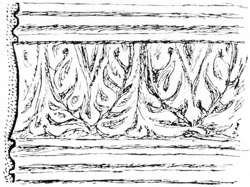
Fig. 50.
The sarcophagus now at the Guildhall was found at Clapton in 1867; it resembles that last described, and must be very nearly of the same date. It lay east and west, “the Christian orientation,” as Mr. Reginald Smith notes. The cover was attached to the lower part by strong iron straps (cf. Fig. 48). It is described as white marble or oolitic limestone, and there are many sparkling particles in the material. The front, which is 80 in. long, has a portrait bust at the centre in a circle, above a panel in which is the inscription, and the rest is filled with vertical flutings (Fig. 51).
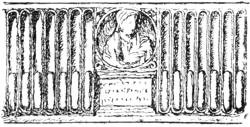
Fig. 51.
The cover is lost, the back and ends are plain, and it probably stood in a building. The portrait relief is curiously early Christian in character. The fluting is exceptionally refined and effective. This is a truly beautiful work, and doubtless if it were in an Italian museum it would be much better known to Englishmen than it is. A full and excellent account of it is given by Price (London and Middlesex Archæol. Soc. Proceed., vol. iii.), in which he compared it with some tombs in the Lateran Museum, showing that it is in the style of early Christian monuments c. 340-50. (The same paper contains descriptions of several plain stone coffins.)
The inscription on the Clapton tomb was very short, hardly more than names, and it does not seem to have contained any expression of faith. The Haydon Square tomb had no inscription. This reticence is characteristic. “The historical inscriptions of this age can be counted on the fingers of one hand.... It is curious to find a noteworthy lack of ordinary sepulchral inscriptions of private persons in the fourth century; there are very few Christian tombs, but it is much more surprising to find a lack of those of the ordinary heathen type. Conceivably fourth-century tombs were handiest for the Saxon invader” (Sir C. Oman, England before the Norman Conquest). Christian inscriptions are very few in France also; there are not, I believe, half a dozen of the fourth century existing.
This tomb and the other are good examples of the skilful way in which forms were obtained in a block of stone without cutting to waste; observe how the mouldings in Figs. 49 and 50 lie just on the surfaces. This is a lesson for our own days.
I have felt that this able work in fine material could 99hardly have had its origin in Britain, but further consideration suggests that the balance of evidence is in our favour. We have seen that other works are in white marble; there are in the British Museum two or three fragments of white marble slabs, while in the London Museum there is a complete one. Several fragments of dado linings are also known. In the heyday of the mosaic pavements there must have been some “firm” of marble importers in London. The general resemblance of the Clapton sarcophagus to that found at Haydon Square is strongly in favour of their common origin. The cover was attached to the receptacle in a similar way with iron straps in both; in each case the flutes are separated by a sunk line. The man’s bust is very similar to the upper parts of the figures on the third and fourth steles above described. Altogether, I could suppose that both sarcophagi came from one shop, and that they were both the resting-places of Christians.

Fig. 52.
A number of tablets which have been found must have been fixed in buildings or against walls. At the British Museum is a small fragment with a part of an animal incised, probably one of a pair facing a central object. (Compare the griffins on the enamelled plate found in London, in the British Museum.) Some of these tablets are of Purbeck and other native marbles, and this shows that we had competent marble masons settled here—probably the same as the mosaic workers.
A small tablet, found in Goodman’s Fields, about 12 in. by 15 in., now at the Society of Antiquaries, was described by Roach Smith as of native green marble; and a fragment in the British Museum, found in Philpot Lane, is of green marble. 100The former (Fig. 52), judging by the wording of the inscription and style of the lettering, may be dated about A.D. 100.
On the whole, these Roman tombs had dignity and beauty, and a study of picked examples throughout Britain would be worth making. The lettering is admirable, and the inscriptions often have a quite human sound which is touching. The portrait reliefs are competent common work. We should now have to go to an R.A. for such things, and come away again without getting them. Some of the symbolic decoration speaks a universal language; the flowering scroll border and festoon of the slab, and the baskets of fruits on the sarcophagus, both in the British Museum, are more than ornaments. A stele at Colchester having a relief of a seated woman putting away her spinning into her work-box is really poetical. The sculpture is crude, but the idea is as fresh and beautiful as any tomb in the world can show.
“The Cemetery had for years been overcrowded with burned and unburned burials; rains had caused the mounds to settle and the ground had resumed its even surface.... I beg you to see that the earth is raised to a mound again, and to have a smooth slab placed upon it.”
A FEW of the more important sepulchral monuments have been reserved for special consideration. First among these I wish to discuss the fragments of what I suppose to have been examples of Jove and Giant columns, a class of monument frequently found on the Continent. These columns, it has been thought, were not naturalised in Britain. In Archæologia, lxix., Professor Haverfield, calling attention to an inscription at Cirencester, which seems to have formed part of a small column of the kind, said that except for this inscription no other evidence had been found in Britain for the existence of such columns. Again, in another place, after speaking of figures of the Mother Goddesses, he added, “We may ascribe to another immigrant the Colonne au géant found at Cirencester” (Romanization). A large number of these monuments has been found in north-east Gaul. The main element was a decorated column the capital of which supported a sculptured group of 102“Juppiter and a fallen barbarian giant.” Such a column usually stood on a pedestal having an inscription to the god; around the pedestal were relief sculptures of several figures, and there were four busts on the capital. Professor Haverfield, whose description I have been condensing, agreed with a suggestion made by Mrs. Strong that a fine Corinthian capital at Cirencester, which has four busts set among the acanthus leafage, may have belonged to the Jove and Giant pillar. This, however, is negatived by the scale of the capital as compared with the inscribed stone, which is only about 1½ ft. square. Further, as he himself allowed, a second capital similar to the other exists, except for its upper part. Both the complete capital and the fragment were found on the site of the Basilica, and we may hardly doubt that both belonged to that building.
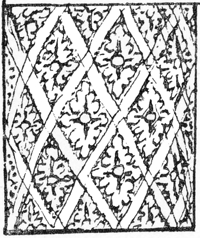
Fig. 53.
Jove and Giant pillars, as I have called them, have been exhaustively treated in a German work (Hertlein, 1910). Espèrandieu, in his volumes on Roman sculptures in Gaul, very fully illustrates two of these monuments, one at Cussy-la-Colonne, near Autun (2032), and another at Merten (4425), also a large number of fragments. He describes the Cussy column as having been about 44 ft. high (including the sculptured group) and 2 ft. in diameter; the bottom of the pillar was carved in a trellis pattern (Fig. 53). The column at Merten was about 48 ft. high with a diameter of 2¼ ft. Under the number 4130, Espèrandieu says of a 103square sculptured stone: “It is generally agreed that these ‘four-god stones’ are not altars but pedestals. They supported a second stone, usually of octagonal form, with representations of the Gods of the Week upon it. From this rose a column and capital, and, crowning all, a god riding and crushing under the hoofs of his steed a giant who terminates in two snakes.” Such columns had a religious significance, and “their frequency, above all on the banks of the Rhine, is surprising” (No. 4425). A good résumé of what had been said of these monuments was given by Mrs. Strong in 1911 (J.R.S.); the general conclusion was that the Jove of the pillar was a sun and thunder divinity, “A Romanised sun-god”; the columns embodied “a whole allegory of times and seasons.” “Hertlein interprets the columns as Irmin-säulen, symbols of the universe; columns such as, according to Teutonic mythology, supported the heavens, here typified by Juppiter as lord of the skies.” Some writers had preferred to see a Roman emperor riding over a barbarian.
In the British Museum there is a carved fragment of a highly decorated column which, I have little doubt, belonged to a Jove and Giant column. This stone was found built into the lower part of the City Wall along the river bank. Roach Smith, in whose collection it was, described it first in 1844 (Archæol. Jour., vol. i.) as: “A portion of a decorated stone which appears to have formed part of an altar.” Later he visited the Jove and Giant column near Autun, and in describing it in Collectanea Antiqua (vol. vi.) he refers to our stone. Subsequently in the Catalogue of his collection he spoke of the stone as: “Fragment in green sandstone, 104with a trellis pattern with leaves and fruit. It appears to have formed part of a sepulchral monument, and was taken from the foundations of a Roman wall in Thames Street.” In saying this he doubtless had the Cussy monument in his mind, for that was understood to be a sepulchral monument. Our fragment is from a circular shaft which must have been about 2½ ft. in diameter. The surface is carved over with a pattern like a trellis of laths, in the interspaces of which appear leaves and bunches of grapes Fig. 54 is restored from the fragment).
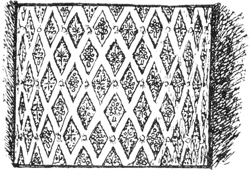
Fig. 54.

Fig. 55.
There is another stone in the British Museum which also probably formed part of a Jove and Giant column (Fig. 55). This was found at Great Chesterford, an important Roman site in Essex. It is described as a “Basin with bas-reliefs of the Roman deities.” These figures have long ago been identified as four of the seven gods of the days of the week (Thos. Wright). The fragment was made into a basin in modern times; it is really half of an octagon, and on the top surface appear the sinkings for two big cramps which linked this to an adjoining similar stone (Fig. 56). For what is known of it, see Roach Smith’s account in Collectanea Antiqua and the 105Journal of the Archæological Association, vol. iii. In the latter it is said that it is irregular and not semi-octagonal; but the breaking down of the upper part into the recesses which contain the reliefs gives the appearance of irregularity—that is all. The octagon was 3¾ ft. in diameter. One of the sides was blank. One-half of this blank side remains, and also half of the opposite side, which retains enough of the sculpture to show that the figure carried a spear over the right shoulder. The next figure, going clockwise, was Mercury; he had a mantle over his left shoulder and carried his wand; points remaining by his hair show that his cap was winged. The third figure was Jove, a mature figure with broad breast, bearded head, and long hair. The fourth figure, who carried a hand-mirror, was Venus. These figures agree very closely with a set of the planets arranged in similar order on a mosaic floor found at Bramdean, and by this comparison it is evident that the one with a spear was Mars. The eighth, or blank, side followed the figure of Venus, so that the series must have begun with Saturn, in the Roman way. We may now say that the eight sides contained figures of the Deities of the Days in proper order: Saturn, Sol, Luna, Mars, Mercury, Jupiter, Venus.
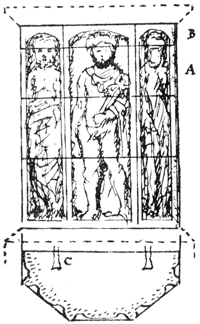
Fig. 56.
106Espèrandieu illustrates two stones from a very similar monument found in France at D’Yzeures (iv. p. 136). These are the halves of an octagon about 3 ft. 7 in. across which was built up in courses. One of the stones comes from a lower course, the other from an upper. The vertical joints ran from an angle to an angle so that they should not cut through the sculptures on the sides. These reliefs were “possibly the Divinities of the Days of the Week.” We have also in England remnants of a similar sculptured octagon which was built up in courses. These are in Northampton Museum, and are illustrated in V.C.H. One of two stones shows the tops of the heads of a series of figures, the other stone has their feet. They are described as “Two fragments of an octagonal monument having figures in shallow niches, possibly the Deities of the Days of the Week” (Haverfield, vol. i. p. 181). Both these stones were of little height, the upper one only contained the crowns of the heads of the figures and flat curves forming the tops of the niches (compare Fig. 56).
We are now in a position to restore the Chesterford octagon (Fig. 56). The heads of the figures on the stone in the British Museum are not complete, for a bed joint runs just over the eyes, and the crowns of the heads must have been on another stone, as at Northampton. Two other courses, at least, beneath what is represented by the existing fragment, would have been required to complete the figures, and indeed their feet were possibly on a narrow base-course, as at Northampton. The Chesterford stone and the fragments at Northampton must represent important Jove and Giant pillars. The size of the former, it should be observed, 107seems most suitable for a column shaft of about 2½ ft. in diameter, the size of the lattice column represented by the fragment in the British Museum (Fig. 54), which probably, as said above, was itself part of a Jove and Giant column. There is thus high probability that there were important Jove and Giant columns, having pedestals sculptured with the Deities of the Days, at London, Chesterford and Northampton. If this is so, such columns must have been frequently erected in Britain, and we may look for evidences for the existence of others.
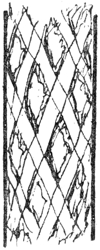
Fig. 57.
In vol. iii. of Collectanea Roach Smith illustrated a small highly decorated column found at Wroxeter, 13 in. in diameter. It was similar to the Cussy column in having a lattice pattern below and a scale pattern above. Here and there were little relief subjects—a Cupid and a youthful Bacchus with grapes. This was probably part of another Jove and Giant column, or at least of a single sepulchral column; there would hardly have been more than one so decorated.
Several pieces of small highly decorated columns have been found in London, which must, I think, have belonged to memorial pillars and not to edifices. One of these found in the Houndsditch bastion, only 9 in. in diameter, was decorated with a simple lattice pattern (Fig. 57). Another is in the London Museum, which, in the part preserved, has a scale pattern (Fig. 58). A third fragment, at the Guildhall, has again both lattice and scale patterns (Fig. 59).
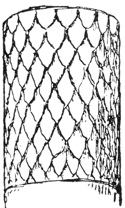
Fig. 58.
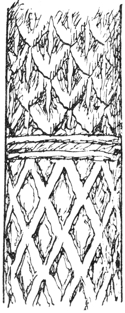
Fig. 59.
Jove and Giant columns were doubtless sepulchral, but they were also religiously significant. They were intended to suggest ideas of the conquest of evil powers and of renewal. Dr. Haverfield was, I think, mistaken in the passage quoted above in speaking of the giant as a barbarian; he was rather a power of darkness, and this is brought out by a piece of British evidence. Figures of four such creatures, each terminating in two serpents, fill the corners of a mosaic floor found at Horkstow; they support a large circle divided into two rings and a centre; in the outer ring are Nereids and swimming creatures, in the inner one little genii with baskets of flowers, etc. The rings are divided into four parts by radial bands, and the general suggestion must be of the seasons and the cosmic order. The snake-legged creatures in the corners are the Aloadæ, the giants who attempted to scale Olympus by putting Pelion on Ossa. They are here in their proper places in the chaos outside the circle of the ordered world, “the wheel of nature.” This pavement helps to explain the general idea which led to the erection of Jove and Giant pillars, and shows that these ideas were current in Britain. The column is the world-axis 109set round by planets and seasons; above, the power of light and order hurls back the giant of gloom and strife (see Daremberg and Saglio, Aloadæ). In the foreign examples of the sculptured groups which rested on the capitals of the columns Jove sometimes had a wheel as his weapon, and wheels have been found carved in Roman altars in Britain. “The sides of two large altars to Jupiter at Walton House bear the thunderbolt for Jupiter and a wheel, which possibly equates the Jupiter of these altars with the Gaulish ‘wheel-god’” (Ward). An altar at Housesteads invokes the sun-god. The Jove and Giant pillars are evidence of a time when the old mythological names had been refitted to express ideas of good and evil, cosmic forces, and supposed planetary influences. The mosaic floors, as we shall see, provide further evidence of what was “higher thought” in third-century Roman Britain.
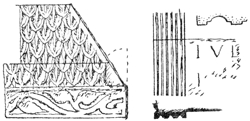
Fig. 60.
Mausolea.—When the bastion of the City Wall in Camomile Street was destroyed, many sculptured stones from small but very richly decorated edifices were found. Price recognised that some of them must have belonged to an important sepulchral monument comparable with the Igel monument near Trèves. I saw, in 1912, some stones at Trèves which had a scale pattern cut on a roof-like slope, and soon after my return I noticed a stone of the same sort in the Guildhall Museum. Without having Price’s words in my mind I came to the conclusion that in the cemeteries of Londinium there must have been mausoleum-like monuments of the kind which the Museum at Trèves had shown me were common in the neighbourhood of that city. Several of these mausolea are now 110illustrated in Espèrandieu’s great work on the Roman sculptures of Gaul. In 1913 I offered a tentative restoration of a London monument of this type in the Architectural Review.
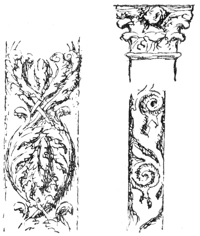
Fig. 61.
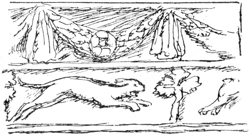
Fig. 62.
In Fig. 60 I have roughly sketched two stones at the Guildhall which evidently came from a mausoleum of the Trèves type, also a course from a fluted angle pilaster, showing part of an inscription. Compare No. 5153 in Espèrandieu’s work, where we find a similar scale pattern, angle pilasters bonded in courses with masonry, and the lettering of an inscription coming close up to the pilaster. Another stone at the Guildhall has a capital of a small angle pilaster on a similar course. This capital has heads set amongst the leaves almost exactly like the capitals of the Igel mausoleum at Trèves (see Fig. 61). Another stone at the Guildhall is part of a frieze in two bands, the upper one of festoons and the lower one of 111trees, and dogs coursing hares (Fig. 62). Similar hunting subjects are found on foreign monuments; the festoons and the scale of the work are also appropriate for a structure of the mausoleum kind, and these five stones may very well have belonged to the same monument (Fig. 63). On another stone at the Guildhall is part of an inscription in widely-spaced lines containing the letters ... R LXX, doubtless part of ANNOR LXX, which actually occurs on the tall headstone in the British Museum. At least two mausolea are probably represented by the stones at the Guildhall. Like the Igel monument, they were probably the tombs of rich merchants. There must have been a large number of tombs of this type in Britain. Bruce and Roach Smith illustrated and described foundations of three tombs by the Roman road near High Rochester, one circular and two square; the first was possibly big enough to have been a tomb-house. At Bath, some years ago, I noticed a stone which could only have been part of a square monument (Fig. 64). This had the tops of the niches cut like shells.
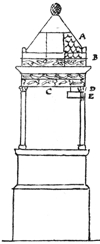
Fig. 63.
Another stone at the Guildhall, found like the others in the Camomile Street bastion, has a short 112length of a decorated angle column recessed as a “nook-shaft” and about a foot in diameter (Fig. 65). This, I think, must have formed part of a similar monument. (This stone is not, I think, given by Price, but it appears in an illustration in J.B.A.A.)
The mausolea of Londinium must have been very similar to the monuments at Trèves, and it may not be doubted that they would have been coloured as some of those were coloured. (I have a note that sculpture, as well as the decorative carving, was coloured.) The braided work of Early Saxon monuments would have been “picked out” in colour in a similar way, and I believe that fragments which have been found prove this.
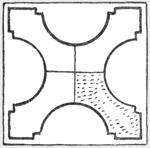
Fig. 64.

Fig. 65.
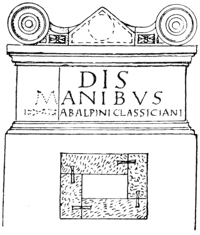
Fig. 66.
Another type of tomb, of which many examples exist in the Museum at Trèves, is an altar-like structure having a square body surmounted by a slab ending in two big bolster-like rolls covered with scale or leaf ornament (see Espèrandieu). Tombs of this type have been found in Pompeii. We have in the British Museum parts of a very fine monument of this class. One of two stones is a great roll, and another has an inscription in handsome letters. These were found together in the foundations of one of the bastions of the City Wall 113at Tower Hill, as described in The Builder, September 4, 1852. In the illustration which was reproduced before (Fig. 33), a pile of other stones is shown, one of which, a moulding with a return, may have been the base of the same monument. The inscribed stone in the British Museum shows that the body of the monument was made up of four stones arranged as in the plan (Fig. 66), and cramped together; the size of this part was probably 7 by 5 Roman feet. It was not a sarcophagus, as the form seems to suggest, but a chest in which an urn containing ashes was placed. The examples at Trèves show that it was lifted on a high base. The covering part of our monument was made up of three stones of which one of the two end-pieces is in the Museum. The two end-pieces had large volute-like rolls similar to those on altars—for example, the little altar of Diana at Goldsmiths’ Hall. On these altars the central part usually 114rises again between the rolls into a gable-like shape, and that this type was followed in our tomb is shown by several examples at Trèves, as well as by the existing end stone which was evidently one of three; the little relief decoration on the remaining edge is suitable to have followed from relief carving in the central stone (Figs. 66 and 67). This tomb was a work of high quality, but it is badly shown; the two stones could be set up together so as to show the size and importance of the monument. If this were done and the Haydon Square and Clapton sarcophagi were shown with it, we should obtain a better understanding of the monuments of Londinium.
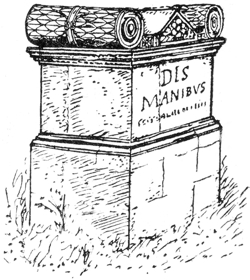
Fig. 67.
Other memorials had sculptured figures. The hexagonal base of one of these found at Ludgate in 1806 (see before p. 71), and now at the Guildhall, bears an inscription in memory of Claudia Martina, aged nineteen years. A much-injured 115female head found with it is accepted as having belonged to the same monument, and a dowel hole on the pedestal confirms the idea that it supported a figure which was probably a portrait statue. It may be observed that the capping of the pedestal is cut with rolls in the tradition of the altar-tombs. The good form of the letters, and the formula beginning D.M. and ending H.S.E., date this monument about A.D. 100. I give in Fig. 68 a sketch from a careful etching published by Thos. Fisher in 1807. The ornamentation of the altar-like top can hardly be made out now, and even the inscription cannot be read in the imperfect light of the Guildhall Museum. A careful copy based on a rubbing should be put on record, for the 116surfaces of such stones are all the time falling away in dust.

Fig. 68.
Several large half-round coping stones have from time to time been found in the bastions of the City Wall; they cannot have been taken from the wall itself, and so probably formed parts of monuments. Espèrandieu shows such a coping to a dwarf wall surrounding a statue, and in the little sketch (Fig. 69) I suggest such an arrangement. Many half-round copings from monuments have been found at Chester.
Several small inscribed memorial tablets suggest that there were some buildings of the “Columbarium” type where the ashes of the dead might be placed. When after about A.D. 250 burial in coffins superseded the older way of burial, individual or family tomb-houses were erected to contain the sarcophagi, and several such would doubtless have been found outside the walls of Londinium. Tomb-houses were not uncommon in Britain; they were usually square or circular 117(T. Ward, Roman Era, p. 139). At Holmwood Hill, Kent, a circular buttressed building 30 ft. in diameter (Archæol. xxi., p. 336) seems to have been such a tomb-house. Of the stone sarcophagus from Haydon Square it has been observed that “as the back is quite plain it evidently stood against a wall, perhaps the back of a small tomb-house” (J. Ward). Even the back slope of the cover was left plain; and the back of the Clapton sarcophagus is also plain.
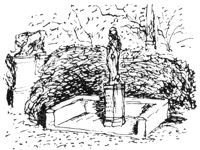
Fig. 69.
Some of the sculptured fragments found in the Camomile Street bastion, while doubtless parts of sepulchral monuments, as Price thought, are of too large a scale to have belonged to mausolea of the Igel type. Two of the stones evidently came from angle pilasters of considerable scale. As Price said: “The size and weight of the stones indicate that the edifice was of proportions to bear comparison with the sepulchres in the vicinity of Rome: such monuments were placed near the city gates.” One of the fragments just mentioned has a nude boy or Cupid carved against a background of foliage on one face, while the return of the same stone contains similar ornament without the boy. Probably on the front face there were several little figures one over the other. This treatment for a pilaster is found on the monuments of Trèves. The boy on the stone at the Guildhall carries an object which Price thought might be a trident, but it is rather a torch; amorini and torches had a sepulchral significance. These big stones must have formed part of the angle pilasters of a large square tomb-house. They are more than 1¾ ft. wide, and one is over 3 ft. high, and contains two units of the fine carved pattern of very similar character to the carving on the Haydon Square sarcophagus. I 118should doubt if it is much earlier, say, c. A.D. 300 (Fig. 70). The pattern is evidently a simplification of the scheme shown in Fig. 61 from a tomb sculpture at Trèves, illustrated by Espèrandieu.
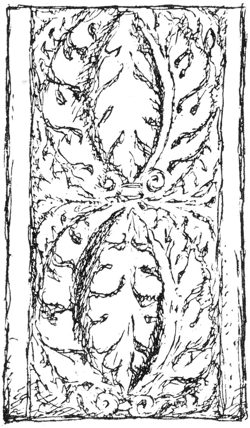
Fig. 70.
At the Guildhall is a niche-head cut out of one stone into an arch form (Fig. 71). It came from the Camomile Street bastion and very possibly formed part of a monument—perhaps a built-up niche surrounded a larger scale figure than the usual reliefs of the steles. Price associated this niche-head with the stele now at the Guildhall, but that was rather all in one stone (see my restoration in Arch. Rev., 1913). A man’s head of larger size than that of the stele and separate from any background was found at the same time as the niche fragments, and the figure to which it belonged may have stood in the niche. Possibly, however, the stone formed the head of a small doorway. Another monument at the Guildhall is a crude and late sculpture of a 119lion seizing some other animal. Many similar groups have been found in Britain and abroad. It would have had some symbolical significance. “Mythological” figures, such as Hercules and Atys, seem also to have been used for tombs.
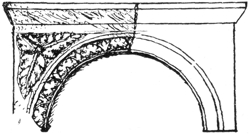
Fig. 71.
This examination of the few broken remnants of monuments that have been accidentally preserved, which obviously represent but a small percentage of those once existing in the cemeteries of Londinium, brings out a new criterion for an estimate of the dignity and opulence of the Roman city. To this evidence we may add the extent of the walls and the importance of the port, and the fact that the city was the key of the road system of the country. It was probably a seat of the Governor; in the Constantinian age it became a bishopric and a mint town. Then we have the quantity and costly nature of the imports which are known to us from objects in our museums—an immense quantity of Samian pottery, decorated glassware, silver, fine bronzes, etc. We also see how closely the monuments of London resembled those of Trèves, the later capital of Western Europe. Altogether I get the impression that Londinium must have been one of the most important commercial cities in the West. In the rote education of our schools, the great facts of our history are too much buried under an avalanche of minor details, and mere dates and names. If we can get a story written about Roman London, one scene must be set among the Tombs.
“Fantastic and even grotesque, it possesses a wholly unclassical fierceness and vigour, and not a few observers have remarked that it recalls not the Roman world, but the Middle Ages.”

Fig. 72.
A FEW broken fragments only remain to us, but they are sufficient to suggest to our imaginations the sculptures of Londinium. The finest work of sculpture found in London is the magnificent head from a bronze statue of the Emperor Hadrian, which was taken from the river near London Bridge in 1834. The head, with the neck, is 16½ in. high. It is really a masterly work of art, of Hellenistic character, and may, I think, be Alexandrian. The treatment of the head and beard is surprisingly like that of the marble Hadrian from Cyrene in the British Museum. Here we have the close-clipped beard and moustache; also the double row of curly locks of hair over the forehead from ear to ear, and the hair close cut behind, an arrangement suitable for the support of a wreath. The beard is again similar on a bronze head of a man found at Cyrene, in the British Museum. The projecting ears of the head of Hadrian are like the ears of the bronze head of Augustus in the 121British Museum, found in Egypt. That the bronze head of Hadrian represents a statue and an erect figure is shown by the facts that one shoulder is higher than the other and the axis of the head and neck is bent. The figure must, I think, have had the left arm uplifted. The statue must have been a splendid object in some public place—possibly the square of the Forum, or on the bridge. In a cast, when seen close by, it looks lumpy and even dull, but the original bronze as set up in the Museum is not only powerful but vivid; notice the sharp eyebrows, the way the nose is set into the brow, the line on the forehead, and the strong 122expressive mouth (Fig. 72, from Roach Smith). There is also in the British Museum a bronze hand, found in Thames Street, which seems similar to the head in scale and excellence of workmanship; moreover, faults in the casting have been repaired in a similar way on the neck and the wrist. Roach Smith seems to have thought that the head and the hand did not belong to the same statue. Speaking of the head he said: “It belonged to a colossal statue, two of which we may probably reckon among the public embellishments of London, for excavations in Thames Street, near the Tower, brought to light a colossal bronze hand 13 in. in length, which has been broken from a statue of about the same magnitude, and, apparently, judging from the attitude, from a statue of Hadrian also. The posture is similar to that of the marble statue in the British Museum.” Dr. Haverfield says of the head: “It appears to have belonged to a colossal statue of the emperor; the forehead is too short; the ears set out too obliquely; and the back of the head projects too strongly; the beard, too, is more closely cut than Hadrian usually wore it.” In another place he speaks of it as “a life-size head of the emperor Hadrian; whether it belonged to a colossal statue of the emperor I do not know, nor does it much matter”(!). In one aspect, Dr. Haverfield was a champion of things Roman in Britain; in another, he, as will be seen in regard to the mosaics, generally spoke slightingly of their quality.
I may now sum up my conclusions. The head belonged to a standing statue. The hand, found separately, may have belonged to the same statue; it probably drooped and held a roll. The head 123has the characteristics of Hellenistic art. The expression is alert and eagle-like; the close-cropped beard already appears on the head of Mausolus in the British Museum, and seems to have been maintained as an Alexandrian tradition. The statue was doubtless imported and may well have been brought from Alexandria, a chief centre of bronze casting. Notice that repairs are executed in an exactly similar way on the head of “Aphrodite,” brought from Armenia and probably an Alexandrian work, c. 200 B.C. A little silver image of Harpocrates, also found in the Thames, is, I think, certainly an Alexandrian work. The bronze statue would have been set up as a memorial of the Emperor’s visit to Britain in 121. A “big brass” was struck in honour of the same event, inscribed Adventus Augusti Britanniæ, and the profile portrait on the coin is very like our head. It has the clipped beard and bears a laurel wreath. Hadrian was the first of the emperors to wear a beard, and we may take our bronze as evidence that he began with the clipped fashion. Not much attention has been given to this head as an early portrait of the emperor, but it is important from that point of view. Compare it with a small bronze bust of a later time found at Winchester and also in the British Museum.
Other remnants of large bronze statues have been found in London. Two fragments at the Guildhall are thus described: “(19) Arm of a bronze statue broken off below the elbow, 19 in. long; (21) Left hand of a statue, bronze, of heroic size, with traces of gilding, 9½ in. long. Found in a well to the east of Seething Lane.” From a notice in The Builder (May 3, 1884), it appears that the latter was found with coins of Nero and 124Vespasian during the construction of the Metropolitan Railway. An article in the Journal of the Archæological Association (vol. xxiv.) discusses other fragments of bronze statues. There must be evidence for the existence of four or five large bronze statues in Londinium. A bronze leg of a horse at the Society of Antiquaries, found in Lincoln, shows that equestrian figures—probably of emperors—were also known in Britain (cf. the Marcus Aurelius in Rome).
Other Portraits.—In the Guildhall is a tomb with a relief of a soldier, larger and in higher relief than usual, which was found in the Camomile Street bastion, and probably occupied a place in the cemetery by Bishopsgate. This figure of a signifer is a little battered, and this accentuates a certain grimness of expression, but it is really a masterly work of unflattered portraiture. There cannot be many existing presentments of a Roman man more real; this has the face of a functionary, and the details of the costume are made out with careful accuracy. The mantle, or cape, partly stitched together in front, was like a chasuble. It was the pænula on which there is an excursus at the end of Becker’s Gallus. The sword had one of the ivory or bone hilts of which there is an example in the British Museum—every detail was evidently carefully studied from fact. Soldiers on the Trajan Column bear similar swords. It is probably an early second-century work. (The Colchester centurion (c. 100) has a similar sword-hilt.[1]) When we learn to value and make due use of our antiquities a copy of this relief should be set up to stand for the fact of Roman rule in Londinium. I gave a 125restoration of the whole slab in the Architectural Review, 1913; it has been wrongly restored in Price’s volume on the Camomile Street bastion.
1. Cf. Daremberg and Saglio, Gladius.
The relief of the Colchester centurion, Favonius Facilis, is really a fine work, one of the most perfect representations of a centurion which exist (cf. Daremberg and Saglio). The niche in which the figure stood had a shell represented on its rounded top; only the hinge-end of the bivalve appears at the apex, and the rest may have been indicated by painting.
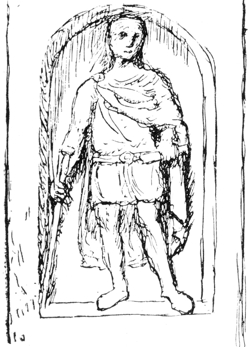
Fig. 73.
At Oxford there is a soldier’s memorial stone with a sculptured relief of a similar kind to the centurion of Colchester and the signifer just described. It was found at Ludgate Hill when Wren rebuilt St. Martin’s Church (Fig. 73). According to V.C.H. the soldier carries a dagger in his right hand. This object is so long that Pennant called it “a sword of vast length like the claymore.” In fact, it is a rod held exactly as the Colchester centurion holds his stick, and I suppose it was a rod of office of some kind. The scroll the man carries in his left hand also suggests that he was more than a “private”; so also does the monument itself, which must have been costly. Roach Smith properly speaks of “stick and roll.” 126There is a good drawing of this monument in the Archer collection at the British Museum. I give here a sketch made from the original at Oxford. The figure is injured, but it was skilfully cut and gracefully posed. I should date it in the first half of the second century. At the Guildhall is a head larger than life-size found in the Camomile Street bastion, which, although battered, shows character (Fig. 74). The discovery of a marble bust of a girl, near Walbrook, was recorded in The Builder of March 12, 1887.
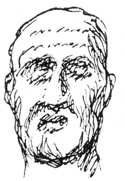
Fig. 74.
Roman Gods and Impersonations.—It is hardly brought out in the history books that the inhabitants of Britain possessed a great classical inheritance. I would say possess, but we do not seem to have determined whether we are British or only English. For a thousand years before the Teutonic invasions of the fifth century A.D. Britain had been in touch with Greek and Roman cultures, and for centuries before that again some overflow from Mediterranean lands had reached this island, and the Celts themselves were a great European race. During five centuries from 100 B.C. to A.D. 400 Britain became fully Romanised. After that time it was probably only some small balance of forces which gave us a Teutonic language, while France under somewhat similar circumstances retained a Latin tongue. Greek gods and, doubtless, Greek stories were known here long before the Roman occupation, as the British coins (the most beautiful money ever coined in these islands) show. Already when Ptolemy wrote his geography, Hartland Point, in Devonshire, was the promontory of 127Herakles, and this is evidence which, together with figures of Hercules on the British coins, strongly suggests that some Hercules story became localised in Britain. Possibly, as the seas beyond the Gibraltar Straits became better known, the “Pillars of Hercules” were shifted to the headland facing the Atlantic. Hercules rescuing Hesione appears as a subject on Castor pottery. “This, and the corresponding scene of Perseus and Andromeda, were popular in Britain and Gaul,” says Dr. Haverfield, and adds: “Whether the scenes conveyed any symbolic meaning in these lands I should greatly doubt.” I incline the other way. It is to be remarked that several altars dedicated to Hercules have been found in Britain: one at Corbridge is inscribed in Greek to the Syrian Hercules—that is, the same who had the famous temple at Gades.
During the Roman rule, the Olympian gods and minor classical genii were, of course, fully adopted, and the monuments show interesting transitions of thought. Jove became a single supreme deity, while the most of the other chief gods were associated with the planets and the days of the week—1 Sol, 2 Luna, 3 Mars, 4 Mercury, 5 Jupiter, 6 Venus, 7 Saturn. This stage of thought is represented by the Jove and Giant Pillars before described.
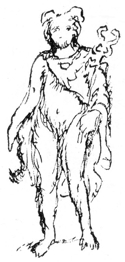
Fig. 75.
On the fragment from Chesterford at the British Museum we have Mercury with his wand, Jupiter with bearded face, and Venus with a mirror. These figures can be completed by comparison with others. There is a relief of Mercury at Gloucester. Another, illustrated by Espèrandieu, is of the same sort; he seems always to have carried a pouch in his right hand (Fig. 75). At the Goldsmiths’ 128Hall is a little altar having a relief of Diana on the front, a group of sacrificial utensils on the back, and simple reliefs of two trees on the returns. The figure is charming, graceful and well proportioned. The pose and setting in the panel are very similar to the soldier relief at Colchester, and I should date it about the same time, A.D. 100-150. The figure is very like a small bronze found near St. Paul’s, of which Allen gave an illustration; that also held a bow, and with the lifted right hand took an arrow from the quiver behind her shoulder. The objects carved on the back of the altar are a table of offerings (compare the leg of a piece of furniture in Leicester Museum), a jug and probably a dipper (Fig. 76). Archer, who published etchings of the reliefs, thought he saw a hare here, but this was a misreading of the obscure forms. This altar must have belonged to some temple or shrine. As Dr. Haverfield says of a somewhat similar relief of Diana found near Bath: “We need not doubt that passers-by worshipped Diana of the Romans.”
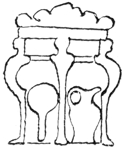
Fig. 76.
At the Guildhall is the upper part of a terra-cotta image of Ceres, and fragments of a Hercules, perhaps from a tomb, were found at Ludgate in 1806. There are many small bronze figures in our museums—altogether quite a Pantheon could be made up of images found in Britain, and these, I feel, belong to us in a special way.
129In the form of impersonations of the days, the seven gods might still be available in a modern art language if we had sufficient sense to construct such an Esperanto.[2]
2. I may say here that I have made some collections for a sort of Art-language Dictionary, attempting to register such forms and symbols as might be available for modern use, but I suppose nothing will come of it.
The Roman impersonations of places and ideas are nearer to us than the gods, and they indeed belong to universal poetry. Chief of these is Britannia, the “Sacred Britain” of the inscriptions. This impersonation was “revived” (we may truly say so in this case, for it had life and reality in it) for our coins in the seventeenth century. It is astonishing evidence of the paralysis of modern architectural thought how little use has been made of this noble imagination which ultimately derives from the gold and ivory Athene of Phidias, and yet is our very own. A seated variant of the standing Athene was made to represent the goddess Rome, and this in turn was the source of our Britannia. Next in importance were the impersonations of cities, and every city and station had a representative figure which stood for its spirit, its genius, itself. Our French friends, in their images of the City of Paris or of Strasbourg, still make use of the idea, but we have ceased to know that a city is more than a congested area where landlords hire out what they call houses. I wonder if London were given an image whether it might not acquire a new sense of soul.
In the London Museum is a pretty and well-sculptured figure which is, I think, a city impersonation and may be Londinium. It is one of two 130sculptures in marble which seem to have been found about 1887, together with a Mithraic relief, on the bank of the Walbrook. It was at first identified as Fortune, but Dr. Haverfield objected that Fortune would have been a female figure, and he suggested “Bonus Eventus, or a genius”; at the London Museum it is entitled Bonus Eventus. It would be hardly possible to bring forward any nearly similar figure with such a designation; on the other hand, a genius of Rome having a striking resemblance to our figure is one of the commonest types of the later coinage. Our figure, a graceful youth, holds a great cornucopia against his left shoulder and pours with his right hand a libation on an altar from a patera; a serpent rising from the altar winds around his wrist; by his left leg is the prow of a ship. He has two wreaths or collars around his neck and is partially draped; his mantle seems to have fallen from his head like a veil, and this suggests that he wore a mural crown or a modius. Now the genius of the Roman people on the coins was represented with a modius on his head, a horn of abundance in his left hand, and a patera from which he pours, in his right. Such a figure occurs on several coins which bear the Mint mark of London and the legend Genio Populi Romani. It is quite possible that our statue may be the genius of Londinium itself. It is known that our British Roman towns had impersonations wearing mural crowns—a fragment of such a figure has been found at Silchester. Our figure is clearly of the nature of Fortune, and the impersonations of towns were their Fortunes. The ship and the horn of plenty, piled up with fruits, corn and articles of commerce, are especially appropriate for a busy port. I 131suggest that this figure might, and should be, adopted as the impersonation and image of the City of London.
I had already written this when I found a figure illustrated in Bruce’s book on the Roman Wall, which is a close parallel to our figure. It was found at Netherby, and is described thus: “The best piece of sculpture belonging to this station represents the Genius of the Castrum wearing the mural crown and engaged in the grateful task of pouring an offering to the superior powers” (Fig. 77). The resemblance of this figure to that in the London Museum proves, I think, that that is the genius of a place, as does also the serpent which rises from the altar. An altar “To the Genius Loci,” found at Chester, represented the genius holding a cornucopia. Compare two altars figured by Lysons (Reliq., pl. lviii.) of similar figures apparently male, each with patera, altar, snake and cornucopia. Fig. 78 is one of those in the British Museum.)
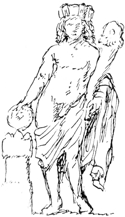
Fig. 77.
Wren, in an early design for the Monument, proposed that it should be surmounted by a civic impersonation.
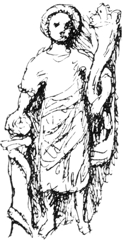
Fig. 78.
In Roman days every place and almost every field had its genius loci—an idea which we still timidly preserve as a “figure of speech.” Many British inscriptions and sculptures relate to Silvanus, Rivers and Fountains; to the Deities of the Fields of Britain (think of that now!), to Nymphs of the Springs (think again of ours choked with tins and old shoes), and to the God of Ways and Paths (perhaps such an image would do some good at Liverpool Street and King’s Cross).

Fig. 79.
The other marble sculpture found with the Genius is the torso of a river god of a well-known type—and very well carved. The figure reclined supported by his left arm; the right hand carried a long water reed which rested against his right shoulder (Fig. 79). The head, with long curling hair and beard, is in a tradition which derives from the Zeus of Phidias, and the body had its prototype in the reclining figures of the Parthenon pediments. Some reliefs of similar river gods occupy the spandrels of the Arch of Constantine. Bruce illustrated a 133very similar figure which represented the North Tyne (Fig. 80). We have every right to assume that the torso in the London Museum may be called the Thames. There is some reason, from the conditions of discovery, to think that this figure and the Genius before described occupied places in a Mithraic cell by the Walbrook. That a river impersonation and a genius of locality should be so found together strengthens the evidence that they represented London and Father Thames. Modern figures of the Thames and other rivers existed in seventeenth-century London.
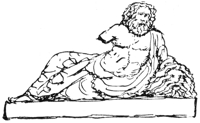
Fig. 80.
Mithras, etc.—At the London Museum is a Mithraic relief, rough and small, but a valuable document. In the centre is Mithras and the bull, surrounded by the circle of the Zodiac. “Outside in one upper corner the Sun drives up his four-horse chariot, and in the other the Moon is driving her car downwards. Beneath are two winged heads, probably symbolising the Winds” (Haverfield). These heads are very well carved and quite pretty; so are the Zodiac signs. This is one of many cases of the similarity of monuments in London and at Trèves. On the celebrated Igel monument is found another Zodiac, the signs of which (so far as they exist) are practically identical with those on our stone. In the spandrels are “heads of wind-gods, emblematic of the four cardinal points.” These heads are winged like those on the London stone, and the comparison allows us to be sure of the interpretation of the latter: the rising Sun is East, the setting Moon is West, the bearded head is North, and the youthful one South.
A small figure found in Bevis Marks, and now in 134the British Museum, is usually identified as Atys. I have some doubt whether it was not rather Silvanus; but it may be a grave monument, and for such a purpose a figure of Atys would be appropriate. A small figure of Hercules at the Guildhall was also probably, as before said, a tomb sculpture.
In the London Museum is another small sculpture, this time in relief, of a figure seemingly in countryman’s costume, standing in a roughly-formed niche or rock recess. By his side is some implement like a yoke, but I cannot suggest any explanation. It has “character,” and I should like to know what it means. It was found in Drury Lane.
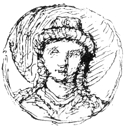
Fig. 81.
Bagford, in his letter to Hearne (1714), mentions a Janus head dug up at St. Thomas Watering on the Dover Road by Bermondsey, also a glass urn at Peckham, and several other Roman things at Blackheath. The Janus head was about a foot and a half high, and seemed to have been fixed to a square column or terminus. It was illustrated by Horsley. One of the two faces was Jupiter Ammon with ram’s horns, the other was female.
I cannot here do more than mention the dozens of small bronzes, some of high excellence, which have been found in London; doubtless most or all of these were imported. Mr. Chaffers saw a beautiful bronze of an archer with inlaid eyes of silver taken out of the mud in Queen Street, Cheapside, in 1842. A pretty bronze relief of Hope was found in Thames Street in 1840 (V.C.H.). I must just refer to a delightful little bronze Genius, 135found at Brandon, and now in the British Museum, which holds a double horn of plenty. This, again, is probably a locality genius. Many of the small clay lamps found in London have pretty reliefs on them, such as a figure of Victory, a head of Luna (Fig. 81), a bird, or an animal. Altogether we have quite a large gallery of classical imagery of our own.

Fig. 82.
Ornament.—Carved decorations were for the most part rude and rapidly cut, but they show some fresh thought and are very different from the defunct details which now pass for “classic.” At the Guildhall is part of a frieze of small scale (Fig. 62) which has running animals alternating with trees. This suggestion of the forest was a popular motive of the time, and is found frequently on our native-made Castor pottery. Haverfield suggested that it might be a Celtic motive, but it is found on Samian pottery, and Espèrandieu illustrates a similar frieze of higher quality found at Mainz. All the Roman architectural carvings found in Britain, it may again be said, very closely resemble works found in Gaul, and especially at Trèves.
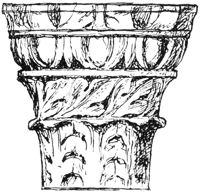
Fig. 83.

Fig. 84.
The wide pilaster at the Guildhall (Fig. 70), also mentioned before, has a boldly designed relief of foliage arranged in a series of oval forms, one over the other. The interior of each unit is filled by the leafage being bent downwards. The same scheme occurs on a mosaic floor found in Dorsetshire, now in the British Museum (Fig. 82). Fine Corinthian capitals have been found at Cirencester and Bath; even in these we find the spirit of experiment 136constantly at work. An example sketched at Angers in France is given in Fig. 83. The most elegant piece of architectural decoration executed in Britain, which is known to me, is a frieze found at Bath, which is somewhat singular in bold freshness of treatment (Fig. 84). Again, this can be explained by comparison with a mosaic pattern. At first sight it seems an ordinary piece of scroll work, but examination reveals that the alternate elements were complete circles. This frieze is broken at a point which might seem to leave room for a little doubt as to this, and my figure is slightly restored; but the border of a mosaic floor found at Frampton furnishes us with a complete example of the same 137treatment, and this excludes any doubt (Fig. 85). Fig. 86 represents a more ordinary scroll frieze from Chester, but even this is brightened by the little birds set in the corner spaces. Fig. 87 is the soffit of a corona member from Bath, also alive and inventive.

Fig. 85.
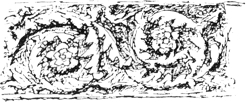
Fig. 86.
All this is very different from the “Roman style” of books and the commentaries on Vitruvius. We may see in such provincial Roman works an early stage of Romanesque art and even the beginnings of Gothic. Again, the fragment of a column at the British Museum, carved over with a lattice pattern having foliage in the interspaces, is particularly interesting as an example of an “all-over” diaper pattern, and a prototype of Romanesque carved shafts. At Trèves there are many examples of much more elaborate diaper patterns of the same type. Such continuous surface decorations speak rather of what was to be in the romance ages than of 138the past of classical art. Even the series of acanthus leaves arranged like tiles on the “roof” of the sarcophagus found at Haydon Square shows adaptive invention and pleasure (that is what it comes to) in the doing (Fig. 50).
If ever we awake to make use of our inheritance and set about civilising London, we might yet gain something of value from the Roman sculptures which have been discussed. A replica of the splendid head of Hadrian might be joined on to a bronze cast from one of the figures of the emperor in the British Museum and re-erected, resurrected, as a visible symbol of the Roman age in Britain and London. Set on a tall pedestal, it would make a noble monument. Copies of the Ludgate Hill Soldier and of the “Signifer” at the Guildhall, we might place against each side, and the reclining River God—the Thames—in front, with an enlargement of the Genius Loci at the London Museum above it. Such a monument would be something to tell the children about, and it might even move the business men to occasional thoughts outside the fluctuations of stock.

Fig. 87.
Symbolism.—Romano-British sculpture was certainly not over-refined; indeed, much of it was just the opposite. But ideas were embodied, and many of the things had simple and poetic meanings. The power of making impersonations is specially to be noted, whereby an image stood for a thing as definitely as its name—Sun, Moon and Planets, Seasons, Winds and Waters, Countries, Cities and localities, events and wishes. Fragments 139of a set of reliefs of seasons found at Bath, represented by nude boys carrying flowers, a reaping-hook, etc.; the winged heads of Winds; and the rising and setting Sun of the Mithraic panel at the London Museum talk a universal language.
Some study of the sepulchral monuments of Roman Britain gives many indications of the thought of the time. The coming in of the coffin, and then of the double coffin of lead and stone, suggests some concern as to an awaking after the sleep of death. The lack of late funeral inscriptions is another indication of transition. The old mythology was softened and the characters were allegorised and reinterpreted in harmony with the mystery cults. We have seen that the Jove and Giant columns suggested triumph over evil. Mrs. Strong has dealt with this subject in regard to continental monuments (J.R.S., 1911): “There is frequent preoccupation as to survival on these tombstones.” The cult of Atys was revived under Mithraism, as appears from “countless gravestones ... an expression of hope, of resurrection; so, too, his pine-cone must be symbolical of the belief; there are numerous examples in Britannia.” In the Roman corridor at the British Museum is a fragment from the North of England, described as the upper part of a niche, which can hardly be other than the top of a grave slab; on it are two peacocks between three pine-cones. Peacocks were symbols of immortality. The baskets of fruit carved on the Haydon Square tomb could only have one meaning. Compare a Gaulish tomb illustrated by Espèrandieu (iii., No. 1789), on which is carved a peacock pecking at the fruit from such a basket, which is upset towards it. The sepulchral banquet symbolises 140some sort of paradise. In examples of these at Chester, we find birds perched on festoons above the main subject, and we have found an example of birds and festoons in London.
The group before mentioned of a lion seizing another animal was in some way “apotropaic”—that is, it warded off evil influences like a horseshoe on a door. At Colchester is a group of a sphinx having a skull between its paws, which is much finer in style (compare Espèrandieu, No. 4675). Probably there were similar tombs in London; in the British Museum is a pretty little bone carving of such a sphinx.
A grave slab at Cirencester has a sphinx and two lions carved on it as acroteria. A somewhat similar slab, found in the north by the Roman wall, has two lions with skulls. A lead coffin of specially fine workmanship, found at Sittingbourne, but doubtless made in London, now shown at the British Museum, has pairs of lions guarding a vase (compare Espèrandieu, 4715), and little medallions of the Gorgon’s head on it (Fig. 152). The most important example of apotropaic sculpture in Britain is the great Gorgon’s head in the pediment of the small Corinthian temple found at Bath.
The apotropaic nature of this sculpture has not, I think, been brought out. It has been explained as a symbol of Minerva, and the building has been called the Temple of Minerva; but for this there is no evidence. (I may say here that Lysons assigned to this building a fragment of an inscription which mentions repairs, but I do not think that this fragment should be separated from another which clearly belonged to a second building. Since writing this, I find that Mr. Irvine had already made a 141similar observation. Wonder has been expressed that this head should be bearded, but this appears to be the Italian tradition.)
In any story of life in Roman London, some of the atmosphere of mixed faiths and symbols suggested in Kingsley’s Hypatia should appear.
“Here is grandeur of form, dignity of character, and great breadth of treatment which reminds me of the best Greek schools. Were I a painter I should venture to enlarge upon the quality and distribution of colour.”
SOME screen appears to be set up between us and our Roman works of art. Even the mosaics, which we might have supposed would have been interesting—even fascinating—seem to be regarded as mere museum objects and subjects for antiquarian tracts. So far as I know there is only one book which considers them as a whole (Morgan’s Romano-British Mosaics), and this is rather a full index than a discussion of their artistic qualities. An excellent chapter in Ward’s Roman Buildings should be mentioned. Even professional scholars apologise for them. Dr. Haverfield wrote: “They have the look of work imitated from patterns rather than of designs sketched by artists.”... “We admire them mainly, I think, because they are old and expensive. Few Romano-British mosaics are real works of art.”
Against such a judgment I will call three witnesses—Westmacott, the sculptor, as above, William Morris, the master pattern designer, and Mr. Alfred Powell. Morris says: “This splendid Roman scrollwork, though not very beautiful in 143itself, is the parent of very beautiful things. It is perhaps in the noble craft of mosaic that the foreshadowings of the new art are best seen. There is a sign in them of the coming wave of the great change which was to turn late Roman art, the last of the old, into Byzantine art, the first of the new.” Mr. Powell, who repaired the Orpheus Pavement at the Barton, Cirencester, and became thoroughly acquainted with the powerfully-drawn animals on it, says: “These creatures of the forest have been set out here in the tiny scraps of coloured stone with an ease and mastery that is remarkable. There is grace in their gesture that has seldom been reached in the art of even the highest period of the life of a nation.” The Woodchester Orpheus Pavement, which, judging from points of resemblance in design and details (a horned and bearded griffin, for instance), must have been by the same master, was a magnificent work, as, indeed, the fragment of its splendid border in the British Museum is enough to show.
Completer lists of London mosaics than I can attempt here have been given in other places (see Morgan’s Romano-British Mosaics, C. Roach Smith’s Roman London, and V.C.H.). Here and there all over the city at depths of from about 8 ft. to 20 ft. pavements have been found submerged by the rising levels of the ground. Scores have been noted, many must have been destroyed without a record, and doubtless some yet lie hidden to-day. In an old MS. Common-place Book I have is the following note: “On Wed., Aug. 15, 1733, some bricklayers digging foundations in Little St. Helen’s, Bishopsgate, discovered a Roman pavement, which by ye inscription [?] had been laid 144about 1700 years ago. It appeared a very beautiful prospect, being in mosaic working, the tiles not above an inch square.”

Fig. 88.
My purpose is to record a few fresh observations, to bring out by grouping and comparison some general inferences and indications of date, to evoke, if I could, some clear idea of the buildings to which such things belonged, and to prepare the way for a full study of these remarkable works.
The Bacchus Mosaic.—The central panel and 145fragments of borders of this mosaic are in the British Museum. A careful original drawing of the whole is at the Society of Antiquaries, and an admirable engraving by Fisher was published in 1804 (Fig. 88). It was found in 1803 under East India House, Leadenhall Street. The patterned part of the pavement occupied a square of about 11 ft., “the whole was environed by a margin consisting of coarse red tesseræ an inch square traced to the extent of 5½ ft. on the N.W. side—[note that it and the building it occupied was diagonal to the points of the compass]—but could not be followed further. The room could not have been less than 22 ft. square; but was in all probability considerably larger.”
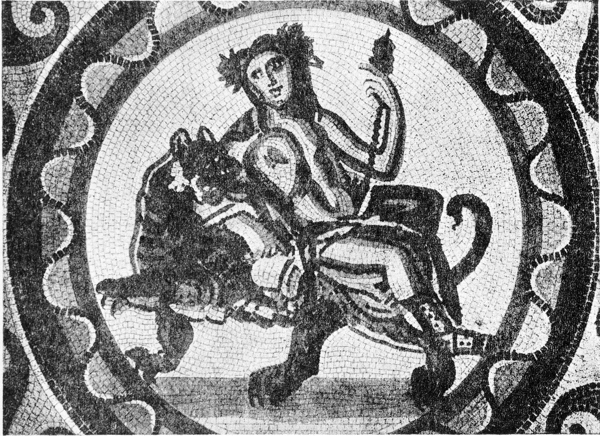
Fig. 89.
146The central panel of Bacchus reclining on a Tiger, at the Museum, has been restored and repolished. It may not now seem very attractive, but it is most competent in the balance of the forms and the strong, even fierce, drawing of the tiger; its bold eye, gleaming teeth, powerful paws, and the baggy skin of the legs are wonderfully truthful (Fig. 89). Notice that Bacchus carries a wine cup; this is the essential part of the design of the mosaic which doubtless was the floor of the central hall of an important house. The brighter coloured tesseræ are of coloured glass.

Fig. 90.
The Bacchante Mosaic.—One of the finest of the London mosaics was found under the old Excise Office, Broad Street. I have an original drawing of it by Fairholt, dated March 1, 1854 (Fig. 90). The best authorities are two large original coloured drawings, one by Archer in the British Museum and the other at the Society of Antiquaries. The central panel had a white ground and black border; the Nymph had reddish flesh and a light greenish 147scarf; the Panther seems to have been a grey-buff spotted black. There was much black and white in the pattern work, and some of the fillings were of black and white triangles.
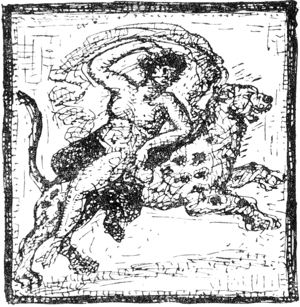
Fig. 91.
It was described at the time of finding as having formed a square of 28 ft.; it was diagonally about north and south and 15 ft. below the surface. The central subject was “Ariadne or a Bacchante reclining on a panther.” In V.C.H. it was said to be “Europa on the Bull,” but the drawings agree with the former description. The composition is very similar to the Bacchus, and doubtless a wine cup was held by the Bacchante also. Notice that vases appear elsewhere in the design. The panel was about 2½ ft. square. This fine floor was taken to the Crystal Palace, where it seems to have disappeared. From its size and subject we may suppose that it was the floor of the central dining-hall of some big house. The drawing and balanced design of the central group is wonderfully skilful as space filling. Fig. 91 is based on original drawings of the floor at the Society of Antiquaries and the British Museum and a sketch in the Wollaston Collection at South Kensington. This mosaic should be compared with a floor found at Bignor, which is very similar in its details, and probably, I think, by the same artist. There the centre is occupied by Jove’s eagle and Ganymede, the cupbearer to the gods.
148Vase-Panel Mosaic.—In his account of discoveries at Bucklersbury, Price describes a floor found in St. Mildred’s Court which must have been one of the finer kind. “A square enclosed a circle containing a vase in brown, red and white with the addition of bright green glass. Around the vase there appeared portions of a tree with foliage; also an object resembling an archway with embattled figures and other objects, the meaning of which is difficult to describe without an illustration. Around the whole were two simple bands of black tesseræ separating the circle from an elaborate scroll of foliage and flowers, analogous to that on one of the pavements at Bignor. At each corner was a flower showing eight petals of varied colours. From the centre of each sprang two branches, which united in a leaf in form like that within the scroll. The entire design is bordered by the guilloche in seven intertwining bands of black, red, brown and white tesseræ. A drawing of this interesting floor was in the possession of Mr. G. Plucknett.” The central panel must have been a formal landscape—a large wine krater backed by a tree and an arcade with figures on the parapet. In another place Price names it again amongst mosaics which had glass tesseræ; probably the tree was of green glass. This pavement also doubtless occupied a dining-hall. In an earlier account (London and Middlesex Archæol. Soc. Proceed. iii.) Price says: “When perfect it was of some extent, resembling those discovered at East India House and the Excise Office. In the centre was a vase similar to those at the Excise Office, and around it a scroll of foliage beautifully arranged. The fragments were packed in 149cases and sent to the workshops of Messrs. Cubitt.”
An Orpheus Mosaic (?).—Roach Smith reported the existence, below Paternoster Row, of what must have been an exceptionally fine pavement, which was broken up before any proper record of it could be made. This “superb pavement extended at least 40 ft.; towards the centre were compartments in which in variegated colours were birds and beasts surrounded by a rich guilloche border.” The wording suggests a square room, and the two former examples show that large square rooms existed in London. In the villa at Woodchester the chief central room was nearly 50 ft. square; the pavement had “a central circular compartment; within the border was a wide circular band containing representations of animals, inside was a smaller band containing birds; on the southern side was a figure of Orpheus.” The description of the London mosaic suggests that it, too, had for subject Orpheus charming the beasts. It was found about 1840 at a depth of 12 ft. In 1843 part of a mosaic floor, “with birds and beasts within a guilloche border,” was found at a depth of 12½ ft. below the offices of the Religious Tract Society at the corner of Cannon Row (V.C.H.). Is it not probable that this was another part of the pavement described by Roach Smith?
Inscribed Floor.—A mosaic pavement found in Pudding Lane as lately as 1886, and bearing an important inscription, was destroyed before any sufficient record of it was made. A printed version of the lettering was given in the Archæological Journal of the same year by Dr. Haverfield, with some comments. (Also see S.A. Proceedings, xiv. 6, 150and V.C.H.) In the collections of the Society of Antiquaries I find a sketch of it by Henry Hodge, a careful draughtsman of the time. This drawing is said to have been made “from a sketch by I. W. Jolly and fragments,” so that its strict accuracy is questionable. It appears that it was complete on the right but imperfect on the left-hand side. On the right some parts of the pattern covering the rest of the floor and a border are shown and some dimensions are given. It looks as if the panel was about 5 ft. across and was the centre of a strip 7 ft. or 8 ft. wide. The letters were about 3 in. high, black on a white ground; the last four seem to have been D. S. P. D.—de sua pecunia dedit—and this would imply that the mosaic belonged to a temple. The destruction of these mosaics is a sad witness to the nineteenth-century type of intelligence. Of all of them only the fragments of the Bacchus pavement are now known to exist. I should like to find out what became of the Bacchante pavement sent to the Crystal Palace, and whether the vase mosaic is still in packing cases at Messrs. Cubitt’s. I wonder, too, what became of Mr. G. Plucknett’s drawing, and wish I could get tidings of it. The great pavement in Paternoster Row seems to have been destroyed without even a drawing being made; while the sketch taken by Mr. Jolly of the inscribed floor has, so far as I know, been burnt. And this was the high age of university education!
Bucklersbury.—The most perfect of the existing mosaics is the complete and restored pavement with an apsidal end found in Bucklersbury. A good account of it while yet in its place is given in The Builder (1869): “It lies fresh and bright as when it was first put down.... It is to be hoped that 151some pains will be taken to trace the remaining walls of the building to which this speaking pavement belongs.” Here, again, although the apartment was not large and the ornamental mosaic was more than a central panel, there was a broad border of the coarse tesseræ. Besides having been a saving, the contrast of the plain red with the variegated central area seems to have been liked. The interlacing squares of this pavement resemble those of the Excise Office floor, and its central rose is like a panel in the same floor. An angle-filling is similar to a quarter of the central pattern filling the centre of the small India Office pavement, which, again, had interlacing squares. A single cross-like pattern filling a panel in the British Museum is again like that of the India House mosaic. Many such references could be carried much further, not only in regard to London pavements, but including the country ones also. I reach the conclusion that they are for the most part nearly of the same date, and that many were by the same artists.
Fenchurch Street.—A fragment of what must have been a fine floor was found in 1859 and is now in the British Museum. It is part of a panel which contained a vase and two birds. An illustration given in Price’s Bucklersbury shows that there was a margin of coarse tesseræ beyond, and that the panel must have been one of a series making up a handsome border. A fragment of a floor with a wide border divided into panels has lately been found at Colchester. Roach Smith described the former as “what would seem to have been an extensive pavement,” and he calls the bird a peacock. A good coloured drawing, in the Archer collection, of the fragment 152shows the bird’s neck a bright blue; the blue tesseræ were of glass. Fig. 92 is from Price, but I have dotted in on the top right-hand corner the line of a more modern building from Roach Smith’s illustration. This is one example of many cases in which more recent walls have been carried up from the Roman level and square with a Roman building. (A in fig., and compare Fig. 90.)

Fig. 92.
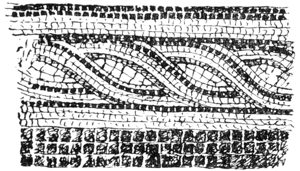
Fig. 93.
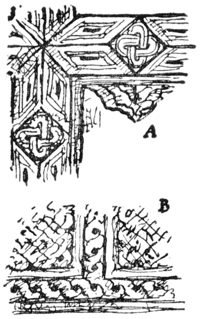
Fig. 94.

Fig. 95.
Birchin Lane, etc.—In 1785 a small piece was discovered here of “a fine tesselated pavement of very small bricks and stones; of this, only one corner appeared, which is composed of black, green, and white stones and brick, forming a beautiful border.” Another account says that “the tesseræ measured about one-quarter of an inch and were of various colours.” I am particular about this, for the bright colours were doubtless of glass. I find a contemporary drawing of this fragment in the Guildhall Library, from which it appears that 153there was a fair blue besides the colours mentioned. (Fig. 93; compare Fig. 92 and a border illustrated by Mr. Ward.) Outside it were big red “brick” tesseræ. There is in the Guildhall Museum a fragment of another mosaic found in Birchin Lane. It is part of a star-shaped all-over pattern of a well-known type (the Barton Cirencester, etc.). Fig. 94 A shows the fragment, and Fig. 95 is a diagram of the complete pattern. Another piece at the 154Guildhall has a sea-monster of small scale but most skilful execution. The place of finding is not noted, but it is probably a fragment discovered in Birchin Lane in 1857, described in V.C.H. as part of a pavement “representing a sea-horse.” Two other small pieces in the same museum are very similar in colour and quality, and may have come from the same source. One of these seems to have belonged to a pavement of square panels of knot-work framed in scroll bands (Fig. 94, B), or it may have been part of a panelled border similar to Fig. 92. Morsels of painted plaster were also found in Birchin Lane, where there must have been a good house.
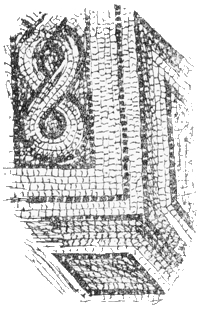
Fig. 96.
A fragment of mosaic at the London Museum comes from another all-over star-pattern similar to that at the Guildhall, but this piece was next to the outer border of the pavement. This fragment is of particularly beautiful colouring—quite a purple floor. I give a sketch of the fragment in Fig. 96; it must have come next the border of a pattern like Fig. 95.
Threadneedle Street.—Several pieces of London mosaic are shown in the Roman corridor at the British Museum, but not very effectively. Two are exhibited as given by Mr. E. Moxhay, but it is not added that they were found in Threadneedle Street in 1841. One is part of a passage and the other is a square from the centre of a room. (See illustrations in Roach Smith’s Roman London, from which Fig. 97 is taken.) Another piece found at East India House, Leadenhall Street, is not set 155up rightly. The pattern is of two interlacing squares; the margin should not be parallel to either of these, but it should touch two of the points of the star form. (Fig. 98. See Sir W. Tite’s illustration in Archæologia; compare also the Bucklersbury pavement at the Guildhall.) This floor came from the same level as the Bacchus mosaic and not far away from its position; probably the small chamber to which it belonged was part of the building which contained the large square hall of the Bacchus mosaic.

FRAGMENT OF ROMAN TESSELLATED PAVEMENT DISCOVERED AT THE DEPTH OF 14 FEET UNDER THE FRENCH PROTESTANT CHURCH IN THREADNEEDLE STREET. APRIL 1841.
Fig. 97.
156The Bank.—A fourth piece in the Museum is a square panel from Lothbury. Allen describes it as “An ornamental centre, measuring 4 ft. each way, of an apartment 11 ft. square; beyond this were tiles of an inch square extending to the sides of the room.” It is another example of the plan of having a comparatively small central panel liberally framed in much plain red work. The device in the centre is a cruciform pattern. I can hardly think that from, say, 250 A.D. it would not have been recognised as a cross indeed. Compare the small cruciform centres of two squares of mosaic exhibited close by.
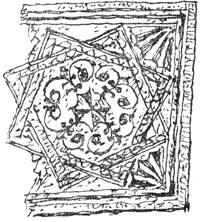
Fig. 98.
The floor mosaics at the British Museum are dispersed in two galleries and a staircase, and even so each one is badly presented. Fragments of the Bacchus floor are shown without any key-plan of the whole. Of five on the north wall of the Roman gallery, the place where only one was found is told. The interesting little Orpheus mosaic discovered at Withington is shown by three single fragments, although an excellent restored engraving was published in Archæologia when it was found. I wish space could be found for setting them in their due relation and completing the composition in outline. The surface requires careful cleaning and some repolishing. The floor from Thruxton on the north staircase has lost its centre since it was engraved. The engraving itself is shown in the gallery a 157hundred yards away, without any reference from one to the other. In this case, I think, the centre should be painted in on the plaster filling of the original.
These mosaics must have been drawn out on the levelled beds prepared to receive them by the master artist and filled in by him and his assistants. The preparation for such a floor is made clear in the description of a London mosaic found in 1785: “This pavement, as well as most of the rest, was laid in three distinct beds; the lowest very coarse, about 3 in. thick, and mixed with large pebbles; the second of fine mortar, very hard and reddish in colour, from having been mixed with powdered brick; this was about 1 in. in thickness, and upon it the bricks [tesseræ] were embedded in fine white cement” (Archæol., vol. viii.). The Bacchus pavement described before “was bedded on a layer of brickdust and lime of about an inch.” Powdered brick (tile) and lime made a strong cement which would finish perfectly smoothly and provide an inviting surface to draw and work upon.
Several mosaics while not quite plain were simpler in design and perhaps coarser in execution than those already described. A star-shaped fragment found in Bishopsgate Street, illustrated by Roach Smith, was of black and white tesseræ. It was probably the central panel of a floor, as Roach Smith said. A mosaic found at Lincoln had a similar star-shaped panel at the centre. About 1840 a tessellated pavement was found in Bishopsgate-Within “of black and white tesseræ in squares and diamonds” (V.C.H.). In Bush Lane “a pavement of white tesseræ” is recorded. On the site of the Guildhall “irregular cubes of 158dark-grey slate and white marble” were found (Journal B.A.A. xix.).
Another pavement, found in Lombard Street in 1785, was “composed of pieces of black and white stone one-third of an inch square, probably deposited in regular order” (Archæol. viii.). These black and white mosaics were doubtless like the counter-changed patterns found at Wroxeter, Silchester, etc. At the latter the Christian church had a square space for the altar paved in this way. Several years ago I drew a fragment of an identical design at Lincoln. This was probably a fourth-century fashion. The others may be a little earlier generally, but they overlapped into the Christian period.
Many floors have been found in London which were wholly of coarse tesseræ of red, or of a few simple colours accidentally distributed. One of these is described as of irregular tesseræ about 2 in. by 1½ in., mostly red, but some black and white. A room 17½ ft. by 14 ft., in Leadenhall Street, had coarse tesseræ red, black and white, 1¼ in. square, and a similar floor “of red bricks about an inch square with a few black ones and white stones” was found in Lombard Street. Some floors found at Silchester had circular and polygonal tiles used with mosaic cubes filling up the interspaces. At Bath, if I recollect aright, there are fragments of pleasant floors in which larger irregular pieces of marble are set here and there in a floor mainly of large red tesseræ.
At Silchester a polishing tool is said to have been found, being a lump of marble with an iron socket for the attachment of a handle (Middleton’s Rome).
A general comparison of the British mosaics 159brings out the resemblances between the members of certain groups. The similarity of the Cirencester and Woodchester Orpheus pavements has already been mentioned. The London floor found at the Excise Office was very like the mosaics at Bignor in both the patterns and figure work. The same pavements resemble others found at Silchester, and also the Cirencester and Woodchester mosaics. A pavement found at Stonesfield, near Woodstock, had a wreath of foliage springing from a head similar to that of Woodchester. It is obvious that elaborate works in isolated villas cannot have been home-made, and it is likely that this group at least was the work of craftsmen established in some central city. No centre is so likely as Londinium, a wealthy town, the most conveniently placed for the importation of materials. We think of these works as “decadent,” but really there was a new life in them. The centre of origin of the later type seems to have been Alexandria, and similar works to our own are found in Asia Minor, North Africa and Gaul. The use of glass in these mosaics is likely to have been an Alexandrian innovation. Price gives a list of five London mosaics in which glass was used, and I may add the fragment at Birchin Lane described above. Glass was also used at Cirencester and Woodchester: the purple tesseræ in the fine border of the latter in the British Museum must be glass.
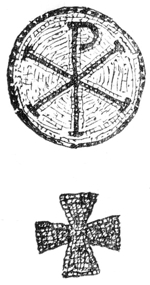
Fig. 99.

Fig. 100.
Taking into consideration the great similarity of mosaics found in the East—those from Halicarnassus, for instance, now in the British Museum—to those found in the West, the character of the patterns, the mystical nature of some of the figure designs, and the swift ability of the workmanship, 160I am drawn to the conclusion that the craftsmen are likely to have been Greeks. Some confirmation of this is to be found in the fact noticed by Wright, that the Greek H sometimes appears for E in the few mosaic inscriptions which exist. Mosaics must, I think, have been works of the prosperous Constantinian age. The floor at Frampton had a XP monogram on it (Fig. 99); the Orpheus pavement at Horkstow, accepted as Christian by Cabrol, had crosses (Fig. 99); and a second one at Winterton has a red cross by one of the animals; the pavement at Thruxton, in the British Museum, has crosses set in the border in what seems to be a significant way (Fig. 100). The other details on this figure also have a Christian look; the top one is from Bignor, the bottom one from Frampton. Fig. 101 is from the Orpheus mosaic at Withington. If the Orpheus pavement at Frampton was Christian, the others are likely to have been so too. At least, they symbolise the Harmony of the 161Universe; they are not “mythological.” These pavements are evidence of the cosmopolitan nature of Romano-British culture.

Fig. 101.

Fig. 102.

Fig. 103.
Any idea of thought in decoration is difficult for us to apprehend. The records of the pavements which have been found in Britain deserve study from this point of view. The whole art of the time witnesses not only to the professional skill of artists, but to the thoughts and desires of the provincial Romans—and natives too, doubtless—who demanded such works. They speak of a time when the old beliefs had been for a large part allegorised and fitted into a sort of poetic cosmogony; the designs often dealt with the order of Nature. Many interesting details are to be found in these mosaics; Fig. 102 is a sundial which appears with a celestial sphere on the pavement at Bramdean. The fragment of inscription (Fig. 103) is from Thruxton. Large square mosaics which seem to have been the floors of central halls have been mentioned. In two cases, such floors found in Britain had sunk water basins at their centres. At Woodchester four columns were placed about the central space, and there was doubtless an opening in the roof above. Such a central hall would have been an Atrium, and this helps to explain the planning of Roman houses in Britain.
BY putting together, in our imagination, the mosaic floors, the fragments of wall paintings, and the marble linings, we can gain a fairly certain knowledge of what the finer Roman interiors in Londinium were like, and we may further add to the impression by remembering the many precious objects in silver, bronze, pottery and glass, which are in our museums. Broken remnants of wall paintings have been found in large quantities, and pieces are preserved at the British, the Guildhall, and the London Museums, also at the Society of Antiquaries. Some account of several of them was given by Roach Smith in his Illustrations of Roman London, from which Fig. 104 is reduced. The fragment (5, Fig. 104), now with the others in the British Museum, is part of a pilaster-like strip about 8 in. wide, of foliage springing symmetrically on each side of a central vertical stem; it is on a dark ground, and marginal lines divide it off from a red space which covered the main surfaces of the wall. This “pilaster” was doubtless one of several. The morsels (6 and 7, Fig. 104) evidently belonged together; the one-sided nature of the design suggests that it was next the angle of a room; and the loop in the upper part of 7 looks like the end of a 164festoon; 9 is somewhat similar; and the others may all have belonged to “pilaster” strips.
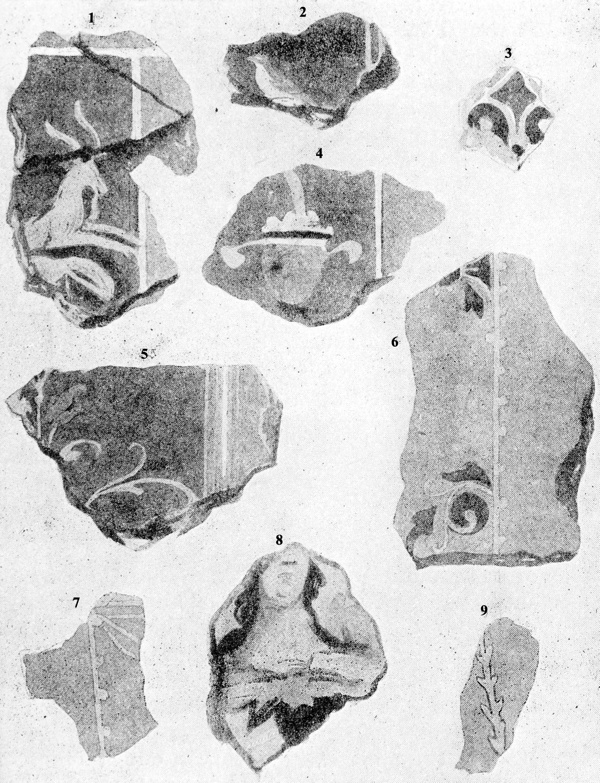
Fig. 104.
The method of dividing up the wall space with strips of plain colour or with “pilasters” was very general. A simpler scheme was to have marginal borders only, and these were frequently of considerable width, made up of many bands and lines of colour. Dadoes were very general, sometimes only a plain band of colour or a horizontal bar running into the margins; at other times they were fully decorated: two examples lately illustrated in Archæologia, from Caerwent and Silchester, are really fine work. The latter had a row of “panels,” alternating square and round, set with leaves and ears of corn, on a red ground between dark top and bottom bands.
Stripes and Margins.—A piece of wall of considerable height was found at Bignor, having a quadrant skirting at the bottom, a plain dark band as a low dado, and the space above divided into panels. At Cirencester a fragment was found which showed a band of fair yellow, edged with margins of white separating spaces of a cool grey-green. At the Society of Antiquaries is a piece of plaster showing fine red and green spaces, divided by a white band and a black line—very simple, but beautiful colour (Fig. 105).

Fig. 105.
Of a great number of fragments in our museums
one cannot determine if they only represent margins
or whether they may have come from vertical strips.
A piece of plaster from Silchester shows a broad
band of red, then two white lines separated by one
165of black, and then a surface of grey, except for other
thin black lines. A piece of plaster at the Guildhall
had a dark green band, probably 3 in. or 4 in. wide,
then a strip of rather transparent crimson 1½ in.
wide, finished against a yellow line, then an interval
of white 1 in. wide, followed by the green again
1¼ in. wide and a yellow line, then 2 in. of white
and a single yellow line followed by a white area.
This was certainly a margin, and here we get an
example of a method of gradating the border into
the general field. In 1785 “some large pieces of
painted stucco” were found in Lombard Street
(Archæol. viii.). Drawings made at the time are in
the Guildhall library. A piece was banded green
and black, with the addition of thin marginal lines.
Two of the pieces were from borders having lines
with additional touches. One had merely groups
of comma-like hooks springing from the
line
![]() ,
and the other, little fleur-de-lis forms on a white
band edging a bright blue space. These were, I
think, coarser variants of the treatment shown in
6, Fig. 104. The margins were sometimes “shaded”
like mouldings; there are one or two examples
of this treatment at Silchester.
,
and the other, little fleur-de-lis forms on a white
band edging a bright blue space. These were, I
think, coarser variants of the treatment shown in
6, Fig. 104. The margins were sometimes “shaded”
like mouldings; there are one or two examples
of this treatment at Silchester.
Pilasters.—In some cases the ornamental vertical strips may not have been contained within pilaster-like forms. A fragment in the British Museum, which has an umbrella-like calyx to a number of springing stalks, may be one of these (Fig. 106). It is on a brown-red ground, and there are some other small fragments with leaves on a similar colour. The cast-shadows make me think that it was independent of a pilaster. The colour and workmanship appear very similar to the festoon of foliage from Southwark, described below; probably such uprights usually 166upheld festoons. The head rising from a calyx illustrated by Roach Smith came from another similar vertical composition (8, Fig. 104). Two small pieces at the Guildhall represent a similar upright (Fig. 107). Again, in the British Museum is a very simple vertical upright, something like a prolonged ear of corn (9, Fig. 104).

Fig. 106.

Fig. 107.
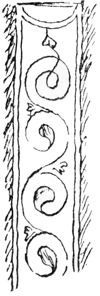
Fig. 108.
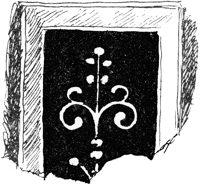
Fig. 109.

Fig. 110.
Figs. 108, 109, 110, at the British Museum, are 167from pilasters. Fig. 110 is a restoration of 3, Fig. 104. Fig. 111 is a small fragment at the Society of Antiquaries; this, too, probably came from a vertical stem or a pilaster. Sometimes the pilasters imitated marble.
Dadoes.—A sketch at the Society of Antiquaries shows the walls of a plain little room found in Leadenhall Street, which had pink margin bands along the skirting and up the angles, and another pink stripe about 2 ft. above the floor. The general surface was white.
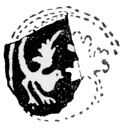
Fig. 111.
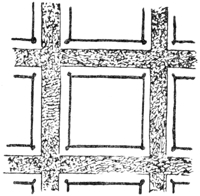
Fig. 112.
Other dadoes seem to have been divided up into small plain “panels” or diagonal lattices. At Silchester there is a fragment with a green band, about 1¼ in. wide, crossing another at right angles, having a red line parallel with the green band with a “blob” at the angle. This seems to have represented a dado treatment (Fig. 112). At the British Museum are pieces of plaster painted with narrow red bands on a green ground, apparently parts of a plain lattice pattern. At the Guildhall is a small piece of plaster having a blue band edged by a white line and with a yellow line beyond the red ground, and another at right angles (Fig. 113). This is probably part of a dado; there may have 168been little subjects or sprigs in the square spaces. This is a notable example of adding “pearling” to the edges of bands or the lines, a favourite method of the painters of Londinium, as several of the other sketches show.
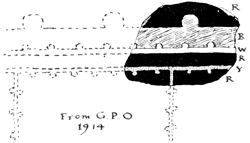
Fig. 113.
A large fragment of decoration at the British Museum imitates marble. A circle of green speckled “porphyry” has a margin of red “porphyry,” with figured “marble” of pink-yellow beyond. The circle is defined by scratched lines drawn on the plaster by a compass as a guide for the decorator. This was doubtless part of a dado for which the size of the circle is entirely suitable. Further, fragments of a similar dado were found at Cirencester in position at the foot of a wall. This is described by Buckmann and Newmarch, but they did not recognise the marbling as such. One square panel contained a circle speckled “dark pink and black”; the panels on either band were yellow with wavy markings. Here, again, porphyry and marble were imitated. At Silchester, fragments of marbling have been found, and in the Rochester Museum are many other pieces. Most of these would have been from dadoes. A wall was discovered in January 1922, in the centre of Gracechurch 169Street, the plaster of which “still retained the lower part of square panels painted in black outline, with a simple ornamentation around, and the painted plaster gave the impression that it had been coloured in imitation of marble.”
Two fragments at the British Museum, which were illustrated by Roach Smith and Wright, are covered with a diaper arranged thus,
with little flowers and figures in the intervals. These must, I think, have come from a dado. The little figure on one of the pieces is now broken, but a sketch by Fairholt in the Victoria and Albert Museum shows it complete with a level band at the top. It is so engraved by Thomas Wright, and I think that part must have been broken off since it was drawn rather than that the drawing was restored. Wright says that these fragments were from a large building near Crosby Square. This pattern is on a fine red ground.
At the Guildhall Museum is a piece which is fortunately larger than ordinary, and allows for the pattern to be restored (Fig. 114). The ground was covered with circles, small and great, the latter containing sprigs of flowers, all on a dark ground. This, I suppose, was also from a dado. The larger outer circle is made up of curious forms, which comparison shows were rose-petals. A fragment found in the Lombard Street excavations of 1785, of which there is a drawing in the Guildhall Library, shows segment of two circles, one within the other, red on bright blue, and apparently part of a powdering of small double circles. In the cloister of Lincoln Cathedral there used to be preserved, or at least kept, a large piece of a dado having a big 170rhombus with Amazon-shield forms at the ends, set within a long rectangular panel; this was of good workmanship and possibly of the second century.
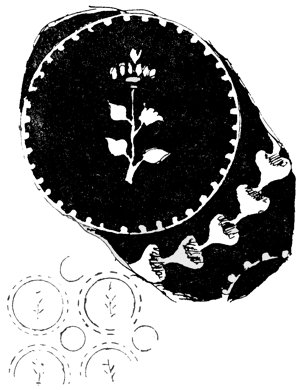
Fig. 114.
Foliage.—In the London Museum is a morsel of pilaster, about as big as an open hand, having small leafage painted on a brown-red ground. The leaves are sharp and struck in in a masterly way; it is really beautiful (Fig. 115). The leaves spread from a central stem or line, and it is a part of a suspended festoon, I think, rather than of a growth of foliage. This must be the fragment found in Southwark. “The débris of Roman villas, with pavements, ornamental bowls, and pieces of painted plaster have been found. One of these last, in Mr. Syers Cuming’s museum, has on it a slender stem with green leaves on a dull red field” (Mrs. E. 171Boger, Southwark, 1895. Mr. Cuming was a well-known antiquary).
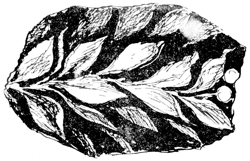
Fig. 115.
In the British Museum are, as said above, two fragments of a scheme of decoration, which seems to have consisted of festoons hanging from slender uprights (6 and 7, Fig. 104). Fig. 116, from the Guildhall, is, I suppose, a variety of vertical stem, but it may be part of a festoon.
Figures.—Some walls had figures in panels or set singly on the general ground. At the Guildhall is a morsel of plaster containing parts of two small dancing figures, which occupied a panel not more than 8 or 9 in. high (Fig. 117). From the composition it appears that there would have been three figures altogether, filling a square panel (Fig. 118). The central figure is of a darker hue than the others, and apparently the face is male; probably it is a faun with two nymphs. The painting of this is of high competence, and in full Pompeian tradition. The little panel, one of a series, would have been set at the centre of a wall division. Roach Smith illustrated the head of a figure of Mercury on a red ground; this was probably a single figure painted 172on a general ground and not included in a panel. Evidences for figures of full size have also been found.

Fig. 116.
A good foot on a blue ground and a piece of drapery of large scale of fine execution are in the British Museum: these are said to have come from Leadenhall Street (The Basilica?). Wright describes some fragments found at Great Chesterford, Essex. “A considerable variety of rather elegant patterns, among which were some representing portions of the human figure. The most remarkable of the latter was the foot of a female, as large as life, with drapery flowing round it. In one of the larger rooms of the villa at Combe End, in Gloucestershire, the lower part of the wall remained covered with fresco painting, on which were a row of feet, also as large as life, which had belonged to some grand paintings.”
Parts of inscriptions have also been discovered. A morsel was found on Tower Hill of “white wall painting with the letters [large capitals] S V P in reddish colour.” At Woodchester, some fragments “were painted with large capital letters which had formed part of inscriptions” (Wright, p. 195).
Cast-Shadows.—It was the practice in figure and foliage painting to boldly reinforce the forms with cast-shadows (see a fragment of a figure in Roach Smith’s Illustrations, pl. 14). A piece of a foliage tendril or festoon in the Rochester Museum, from the villa at Darenth, has cast-shadows. This is of 173long, delicate, grey-green olive leaves on a red ground, and the sharp shadow below forces it into prominence. Several of the ornamental patterns found in London were reinforced by shadows. A striking example is the large scroll foliage pattern from Leadenhall Market, where separate shadow lines and touches are laid almost like a secondary pattern. This, I think, from the scale of the work, must have been part of the decorations of the Civil Basilica described in Chapter II.
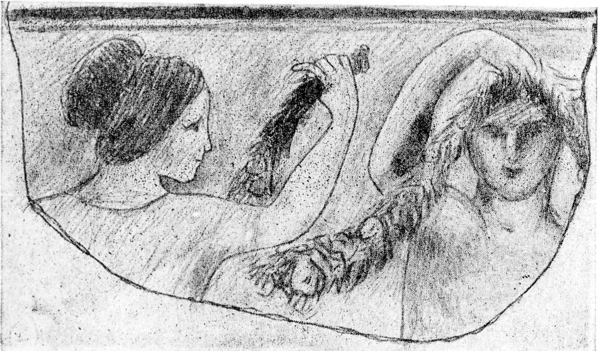
Fig. 117.
Provincial Roman painting is not fine as compared with the great things in either Greek or Gothic art, but we must remember, in comparing it with anything we can obtain to-day, that it was the ordinary journeyman decorator’s work of the time. It is certainly far beyond the standard of common work which we reach to-day; and Roman London, on the testimony of the arts, must have been quite a civilised place. A full study of the fragments in 174country museums ought to make an interesting subject for a student who is prepared to take up a definite piece of research on the history of art in Britain. Further, suggestions for enlarging the scope of work undertaken by present-day “painters and decorators” might be gathered from these ancient paintings. Our workmen are capable of much better work than is ordinarily demanded of them. Their skill in graining was noticeable; it was the last field where any freedom was left the workmen, and it was probably for that very reason (unconsciously functioning) that architects have tried to kill it. It is our duty to demand free and interesting work. A point to be thought of in regard to the Roman decorations is the character of the designs. These are not laboriously set out, transferred from a full-sized drawing, and painfully “executed”; they are swiftly painted in masterly brush strokes and varied at will for the fun of the thing.
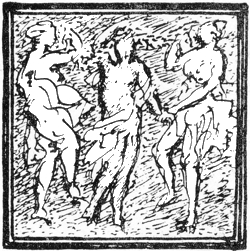
Fig. 118.
Marble Wall-Linings.—In London, at Silchester, and elsewhere, fragments of coloured marbles, and even of porphyries, have been found, which suggest that they were parts of wall-linings, or rather of dadoes. Wright says, of the Great Villa at Woodchester: “Several slices of marble, of different sorts, but chiefly foreign, were also found. These had, perhaps, been employed to encrust the walls. Some of these pieces were not more than a quarter of 175an inch thick.” At Silchester pieces of porphyry have been found not more than three-sixteenths of an inch thick, and also pieces of fine white marble. At Colchester, fragments of Purbeck and white marble and porphyry have just been dug up. At the British Museum there are many small pieces of marble of various colours, and some of red and green porphyry. A piece of white marble at the British Museum has a shallow edge moulding such as I have frequently seen on dado-slabs in Rome. Such moulding is an excellent way of joining up continuous slab work. The pieces of green porphyry at the British Museum are from the site of East India House (where the Bacchus pavement was found), and they were given by Sir W. Tite in 1884, who, about that time, wrote on the mosaic pavement. These pieces are cut into forms—a part of a circular band and a triangle; they must have belonged to some handsome piece of work, like an Opus Alexandrinum pavement. It looks as if this building, close by the Forum and Basilica, was of special importance—perhaps the governor’s palace.
There must have been skilled marble workers in London. This is proved by the fact that fragments of polished native marbles have been found. Roach Smith, as before said, speaks of “native green marble.” Fragments of Purbeck are common.
At Silchester evidence has been found that mosaics were applied to the walls of a chamber in the Baths; and at Wroxeter a considerable fragment of wall mosaic was found in place many years ago.
LETTERS.—Fine lettering is the most perfect thing in the art of the Romans. For one thing, it was developed on a field where they were not obsessed with the idea of imitating Greek art; it was their very own, and it was swiftly carried to an apex of perfection in the first century A.D. It is a constant phenomenon on all the fields of Art that it is the first great flow of development which chiefly matters; all things of life and growth are like this, and, as I once heard a fine old Devonshire farmer say, “You can’t have two forenoons in one day.” The Romans, not the Greeks, had the forenoon of the day of their manner of lettering. This manner is clear, sharp, confident; it is like Greek art only in being free.

Fig. 119.—Inscription from the front of a Roman Tomb found at Westminster Abbey in 1869: now by the entrance to the Chapter House.
MEMORIAE·VALER·AMAN
DINI·VALERI·SVPERVEN
TOR·ET·MARCELLVS·PATRI·FECER·
Early inscriptions had for the most part been cut on stone. Then from about 300 B.C. came a time of writing with a pen. Rome took this over from Alexandria and Pergamon, and these written characters became the foundation of a new style of monumental inscription. In pen-written characters the thick and thin strokes make themselves without there being any design in the matter. It seems equally natural in large clear writing to finish off the strokes with a thin touch of the pen to sharpen the forms. This procedure was taken over so 178exactly into inscriptions cut on stone that, for the most part, it seems these must first have been written on the stone with an implement like a wide brush and cut in afterwards by a mason. The chisel, like the pen, is thin and wide, and thus perfectly fitted to develop the habit of the pen. The cut letters were themselves usually finished by painting. Whoever wishes to design inscriptions must begin on the writing basis, and I should like to advise every student who may read these words to take up the practice of writing capital and small letters with single strokes of the pen, not “touching up” or “painting” the letters, and, above all, not “designing” them with high-waisted bars, swollen loops, little-headed S curves, and other horrors of ignorance and vulgarity, but learning once for all a central standard style. Half an hour a day for one week would teach much to any one who was ready to learn and did not want to do everything by genius.
We have in England a great number of fine Roman inscriptions, and it would be an excellent piece of work to gather a selection into an example-book of illustrations based on corrected rubbings. Even the inscriptions of London carefully studied would be subject-matter for a delightful and valuable essay.
1. The finest London inscription is that on a tomb front in the British Museum (Fig. 120). This must be a first-century work nearly contemporary with the famous inscription of the Trajan column. The letters are large, deep, clearly cut, and of quite perfect form. It is something of a puzzle that such an artist as the author of this tomb should have been working in London only a few years after the 179Claudian Conquest. The letters of this inscription are still wonderfully sharp; the thick strokes of the big letters are about an inch wide, and the “serifs” are light and free as the stroke of a pen. Notice especially the beautiful curve of S, the square touch at the apex of N and A, and the sharp little triangular division point after the second letter in the last line (Fig. 121. See also Figs. 66 and 67).
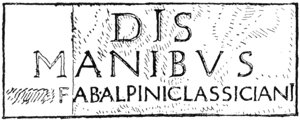
Fig. 120.
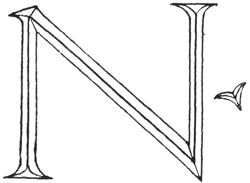
Fig. 121.
2. Another very fine inscription is on the tomb front of Valerius at Westminster Abbey. The letters are smaller, the stone is rather decayed on the surface, and it is not seen in a good light. The beauty of the lettering and spacing has consequently hardly been remarked. Here the lines are longer, and the letters seem to follow one another rhythmically, trippingly; it is an extraordinarily vivid and elegant 180piece of work, which, I think, should be dated in the second century A.D. The letters A M and N have cross touches at the apex of the angles, and the stops are little triangles as in the inscription before described. Here it can just be seen that lines were ruled (scored) on the stone as guides for ranging the letters (Figs. 119 and 122).
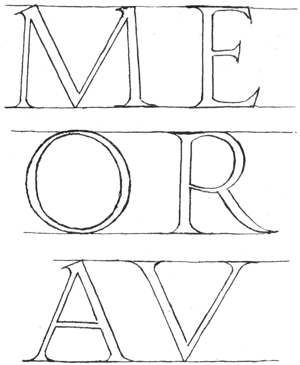
Fig. 122.
3. In the London Museum is a small tablet of white marble, which has similar lines, lettering and stops, and must be nearly of the same age. I give in Fig. 123 a very rough sketch of this excellent little slab. I have felt some doubt as to whether this was a London antiquity indeed, but the many resemblances to other inscriptions have fully convinced me that it is.
1814. At the Guildhall there is another small slab, having only a few letters, but these of fine early style (Fig. 124). Both these little tablets and others probably were set on the wall of some burial chamber of the Columbarium type.
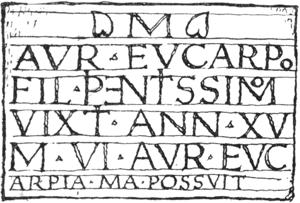
Fig. 123.
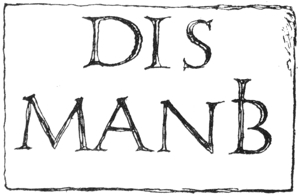
Fig. 124.

Fig. 125.
5. Another inscription of much the same character, but in smaller letters, is that on the hexagonal pedestal in the Guildhall Museum, of which a sketch was given in an earlier part. This provides an example of a group of tied letters (Fig. 125). The 182writers of Roman inscriptions allowed themselves much freedom in contracting words, in setting a small letter within a big one, as in Fig. 119, and in combining two or three letters together. In Fig. 126 I have noted one or two other examples not all from London.

Fig. 126.
6. In a fragment of inscription from Greenwich Park at the British Museum, the letters were much compressed, and many of them were linked together (Fig. 127).
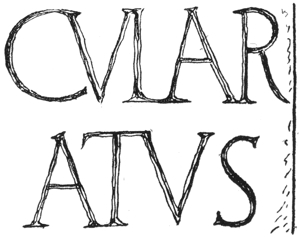
Fig. 127.
It is difficult to draw out any general rules of form and spacing; generally o and c were very round in form, N of square proportion, and M wider than a square. The round letters were usually thickened, not where the curves would touch vertical tangents, but a little under and over, just as is natural in writing the letters. The loops of 183D and R do not become horizontal at top and bottom, but bend freely. A, N and M usually have square terminations at the upper angles. Initial letters are not larger than the rest.
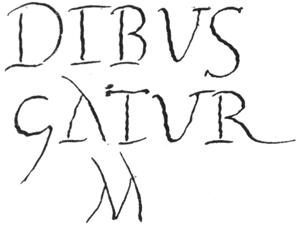
Fig. 128.
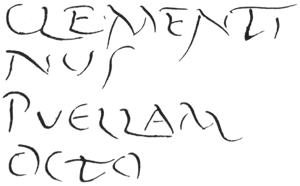
Fig. 129.
One or two examples of rapid cursive writing have been preserved on bricks and tiles. Fig. 128 gives some letters of interesting form from a tile at the Guildhall. The A, G and M are on the way to be transformed into—a, g and m; apparently the hook of the “a” had its origin in the overlapping termination at the apex in the monumental inscriptions. Fig. 129 is from a still more rapid scribble; L, T and E here approach our modern 184handwriting forms. These examples are enough to show how the more cursive writing styles and our own handwriting have been developed from the Roman capitals.
Roman books and correspondence were written in such hands, and Dr. Haverfield has pointed out, as such scribblings on tiles were obviously in many cases by labourers in the brickfields, it follows that the common people in British towns had come to talk Latin. Dr. Haverfield went on to question whether town workmen even spoke Celtic. “Had they known Celtic well, it is hardly credible that they should not have sometimes written in that language. No such scrawl has been found in Britain. This total absence of Celtic cannot be mere accident” (Romanization). This argument overlooks a probability that Latin was a written language, while Celtic was not. We hardly realise our direct and full classical inheritance, and the fact that Londinium was a Roman city for three and a half centuries. Here the Latin Pantheon must have been completely absorbed into the common texture of traditional thought; here boys would have carried texts of Virgil in their satchels, and here, again, the story of the Gospel must have been brought in its first westward expansion.
Inscriptions.—In the notes which follow, I am more than ever off my proper ground, and, moreover, they are likely to be very dreary to any one who does not feel the romance of early London and Britain through all the dryasdust detail in which we have to work.
An important inscription was found in 1850 under St. Nicholas Lane. It was described in the same year (Gent. Mag. xi. p. 104): “A large slab 185with the following Roman inscription in well-cut letters 5 in. or 6 in. in length:
It is doubtful if the fourth letter in the first line be C or O. The stone is in fine preservation, and others ought to have been discovered, but the excavators were not permitted to turn either to the right or to the left, notwithstanding a gentleman offered to pay any expense.” This must have been Roach Smith, who, as the practical repetition of the phrases given below shows, must have been the author of the note. An MS. letter, which is in my possession, is as follows:
“My dear Fairholt,—I have given Richards £10 for you.... In the Guildhall is a fragment of a large inscription from Nicholas Lane which we should give rather large. It lay just within the lower door of the Library. The letters are deeply cut and should be shown clear. Can you see if the stone be broken? [Sketch.] Note if letter 4, line 1, be a C, and please measure it. It is most important. I suppose it is half the original length.—Yours sincerely,
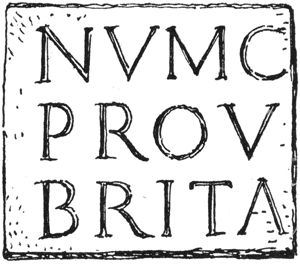
Fig. 130.
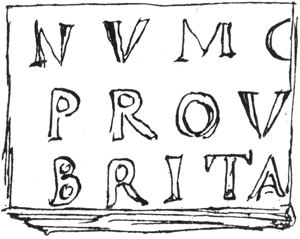
Fig. 131.
The stone had disappeared and has never been heard of since. The size was recorded by Birch as 2 ft. 4 in. high, and 3 ft. wide on the face. V.C.H. 186says 6 ft. long, but this is a mistake. Fortunately a careful drawing of the stone was made by Archer, which is preserved in the British Museum (Fig. 130). Archer’s drawing confirms Roach Smith’s reading of C at the end of the first line next a vertical joint. My sketch by Roach Smith seems to be the only other record (Fig. 131). In Illustrations of Roman London, he says: “It was found close to a wall, 187and there is reason to think other stones having the remainder of the inscription were not far off from the one excavated. In the present year (1859), being desirous to compare it with my sketch, I ascertained it was not to be found. The stone was between 2 and 3 ft. in length. The fourth letter in the first line appeared to me when I made the sketch more like a C (which I considered it to be) than it seems to be in the woodcut. From the magnitude of the stone and the character of the letters it is clear that the inscription surmounted the entrance of some public edifice, apparently a temple. It is probably the commencement of a dedication which occupied two or four stones. The wider distance from the top than of the third line from the bottom weighs in favour of the belief that we have only the first quarter. There can be no doubt that NVM should read Numini, and that PROV BRITA should be read Provincia Britannia; the supposed equal length of the second stone and the number of letters required, render this reading obvious. Seneca and Tacitus concur as to a temple having been erected in Britain to the Emperor Claudius; the latter locates it at Camuludunum. This temple was probably erected soon after the subjugation of the Trinobantes. It may be readily conceived that Londinium possessed some edifice dedicated to that emperor. Although it is impossible to decide positively, we cannot avoid associating the historical evidence with an inscription which must have been of an early period, of a rare class, and almost unique in this country.” This idea that there were formerly four stones is now much strengthened by the fact that a curiously similar temple dedication is illustrated by Espèrandieu (iv. p. 126) from 188D’Yzeures. This inscription begins Numinibus Augustorum and is on four equal stones with joints meeting at the centre, thus +. Hübner (C.I.L. vii. No. 22) gives the boundary to the right of the London stone as a fracture, and restored the inscription with Num. Caes. et Genio in the top line. It is at once apparent that this would not space out properly with the single words of second and third lines. Haverfield leaves out Genio and reads, “To the Divinity of the Emperor and to the Province of Britain.” This, I suppose, might be possible in a contracted inscription, but I am drawn back to Roach Smith’s view, and would venture to suggest the possibility of some such restoration as:
I am ignorant whether it would be possible to have a dedication from the Province of Britain to Claudius in such a form, but if so it would be a record of great significance. The fourth letter was certainly C, because an O would not have avoided the joint. The letters in the top line were about 6 in. high, and the whole was of fine style. As Hübner says, it is doubtless of the first century. It was certainly affixed to a temple dedicated to an Emperor-divinity. The complete inscription probably occupied four stones.
2. Several brick inscriptions are of special interest, as most of them contain the name London. There are two varieties: (a) P.PR.BR. in a label; and (b) P.P.BR.LON (Figs. 132 and 133). The 189former (a) has large letters, and they are enclosed in a tablet: it seems of earlier style than the other. Wright says of the second: “The most probable interpretation is Proprætor Britanniæ Londinii; this has a peculiar interest as showing that London was the seat of government of the province.” When Wright wrote only a roof tile of variety (a) seems to have been known, but now there are several plain tiles at the Guildhall and one at the British Museum which have the same mark. All these are alike in having four notches in their long edges, and one flat side of each is scored over with lines to give better hold for plastering. It seems that these tiles must have been used for lining walls, nails being driven in at the notches; their size is 16 in. by 11 in.
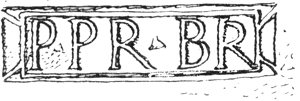
Fig. 132.

Fig. 133.
The explanation of Hübner adopted in the new British Museum Guide is that P. in (a) and (b) both “represent the publicani who farmed the taxes (the ‘publicans’ of the Gospels) of the province of Britain in London.”
190Nothing is so expert a matter as Latin inscriptions, and it would be absurd for one who is entirely ignorant to pretend to a difference of opinion. I may, however, venture to point out that Hübner himself does not seem very certain, and that the difference of the two forms seems to coincide with the historical fact that earlier Britain was one province and that later it was subdivided. Variety (a), I have little doubt, is a second-century inscription (similar labels are found on pigs of lead of the time); while form (b) is quite late (probably end of fourth century). The first variety I should like to suggest represents the governor of the undivided province, and the second the subdivided province with its centre at London. If I am not entirely outside the possibilities of the case there is some confirmation of Wright’s view in the fact that other tiles bear the stamps of high authorities; thus a tile at Silchester has the name of the Emperor Nero in a circle, and other tiles are known stamped with the marks of army and navy commands.
3. At the British Museum is a silver ingot (found on the site of the Tower of London), stamped with an inscription given as
and described thus: “Ex Of[ficina] Fl[avii ?] Honorini: found with gold coins of the Emperors Arcadius and Honorius.” The reading FL at the end of the first line is probably adopted because the Emperor Honorius had also the name Flavius; but to my eyes the letters look more like FE. Other similar marks on silver show that 191we need not expect an emperor’s name. (One in the British Museum reads EX OF PATRICI.) Roach Smith read the London inscription, EX OFFI, and explained the whole “From the workshop of Honorinus.” I may suggest Felix Honorinus.
4. Lying in the grass in front of St. Margaret’s, Westminster, is a large white stone, bearing only T II in what appears to be Roman work and style. It was found near its present site about forty years ago, and was accepted as Roman and explained as a boundary (terminus) mark. It may be noted that it lies close to the line of the presumed Roman road along Tothill Street to the river. The nearest parallel I have seen is a stone found near Falkirk, described in Haverfield’s addition to the C.I.L. (No. 1264): T III (turma tertia).
5. An inscription at the Guildhall
is, as has been pointed out, a record of the restoration of some edifice or sculpture dedicated to the mother goddesses. The lettering is on the half of the crowning member of a cornice which may have been over a narrow door, and Roach Smith was probably right in assuming the existence of a small temple.
6. A sketch of the inscription found on a mosaic floor near Pudding Lane is preserved at the Society of Antiquaries: it has indications not brought out by printing it in type, and an expert could probably gather more from it than has been made out.
7. The sarcophagus from Clapton at the Guildhall has a much-defaced inscription on the front panel ending apparently, as the catalogue says, 192with the name MARITIMIVS. Here, again, it is possible that careful examination by experts would bring out further facts.
These inadequate, indeed incompetent, notes on a few selected inscriptions are at least enough to show that the inscriptions of Londinium are worth the attention of properly equipped scholars. A carefully illustrated account of them might be made interesting to all intelligent citizens and help them to get really into their minds an idea of the Roman age in London.

From a Relief at Bath.
IN his account of Roman London, the late Dr. Haverfield writes (J.R.S., vol. i.): “The citizens appear to have been Roman or definitely Romanised. Of Roman speech in London we have an isolated but sufficient proof. A tile dug up in Warwick Lane, in 1886, bore an inscription, meaning, apparently, ‘Austalis (Augustalis) goes off on his own every day for a fortnight.’ It seems to follow that some of the bricklayers [makers] of Londinium could write Latin. In the lands ruled by Rome, education was better under the Empire than at any time since until about 1848. The occupations of these Roman or Romanised civilians are unknown to us. Articles manufactured on the Continent were certainly imported. There were also exports of grain, cloth (or wool), and lead, and so forth. We may believe that Roman London devoted its time to financial rather than industrial activity.”
Evidence for the practice of arts in Londinium is really considerable. It was doubtless first of all a port, and probably originated as the seaport of the pre-Roman city of Verulamium; but it became the largest city in Britain, the chief distributing centre and the artistic capital. We are apt to think 194of Dover, or rather Richborough, as the chief port of the country, but London itself was the largest consumer, and the line of traffic was rather to the mouth of the Rhine than to Boulogne. Londinium was a little Alexandria in the West, and represented Britain as the other did Egypt. The building of such a city called together many able craftsmen—builders, sculptors, painters and mosaic workers. There must also have been shipbuilders and a due proportion of craftsmen-producers, potters, bone- and metal-workers, shoemakers, clothiers and the rest. An enormous quantity of pottery has been found, much of fine imported wares, but the most part varieties of native fabric, of which a large proportion was doubtless made of local clay. The site of St. Paul’s Cathedral was covered with “pot-earth,” and the town potteries seem to have been here.
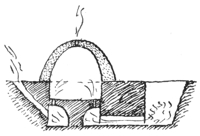
Fig. 134.
Native Pottery.—In the British Museum are some valuable MS. notes made in the years 1674-79, “by Mr. John Conyers, apothecary, at the ‘White Lion,’ in Fleet Street” (Sloane, 958, 816, 937). In mentioning St. Faith’s Chapel, at St. Paul’s, he says that his father and mother were there married forty-five years since (from 1677). Incidentally, he speaks of two brothers, and of being “at Epping Forest hunting ye hare, but ye frost prevented the scent.” This is a late example of the sporting customs of ancient London. His observations refer to excavations on the site of St. Paul’s and along the Fleet. In regard to the former it appears certain that there were a number of Roman rubbish pits on the site, similar to those recently excavated on the Post Office site. Here also were found pottery-kilns and glass furnaces with 195pottery, bone and other objects. This seems to have been a manufacturing quarter of the city unoccupied by dwellings. Some sketches show that the pottery kilns were circles of small diameter, having a raised floor supported on a central post, like a table, all of clay and broken stuff roughly formed; the lower stage or fire chamber was thus a ring around the central prop, and in the raised “floor” were several small holes. There must have been an external pit with a stoke-hole, and also a flue from the fire chamber. Four such kilns were found close together, forming a quatrefoil group. The dome of the kiln seems to have been roughly new formed over the pottery to be fired (Fig. 134). Conyers, in the account of finds on the site of St. Paul’s, gives sketches of the kilns found at St. Paul’s with several kinds of pots: “Figures of two kinds of kilns or furnaces of various pots, jugs, etc., of different kinds of earth and pottery. One kiln in loamy ground about 26 ft. deep, near the place where the Mercat-house stood in Oliver’s time. The discovery made in 1677 on digging the foundation of the north-east cross part of St. Paul’s amongst gravel-pits and loam-pits.... Coffins lay over this loamy kiln, the lowest coffins made of chalk, and this supposed to be about Domitian’s time. This kiln was full of ye worst sort of pots, lamps, urns, and not many were saved whole. Four of these [kilns] had been made in the sandy-loam in the fashion of a cross on the ground; the foundations 196of these left standing 5 ft. from top to bottom, and better, and as many feet in breadth, and had no other matter for its form or building but the outward loam crusted hardish by the heat burning the loam red like brick. The flooring in the middle, supported by and cut out of loam and helped with old-fashioned Roman tiles, sherds, but very few, and such as I have seen used for repositories for urns in ye fashion of little ovens, and they plastered within with a reddish mortar; but here was no mortar, but only ye sandy loam for cement.... A censer or lamp, whitish earth; one great earthen dish; earthen lamp gilded with electrum,” etc. etc.
Again, Conyers says the labourers under part of the place where St. Paul’s Cross stood, 25 ft. or 30 ft. deep, as the earth ceased to be black and came to the yellow sand, found earthen potsherds as red and fine as sealing-wax, and upon some inscriptions, “De Ovimini,” “De Parici,” “De Quintimani,” “Victor,” “Janus Ricino.” [These were Samian, but he goes on to describe very accurately native pottery.] “And pots like broken urns, which were curiously laid on the outside with like thornpricks of rose trees, in the manner of raised work. Other were of cinnamon colour, urn fashion, and as if gilded with gold but faded. Some of strange fashion, jugs bent in so as to be six-square, raised work upon them pricked as curious raisers of paste may imitate; some like black earth for pudding pans, on ye outside indented and crossed quincunx fashion. They had some odd colours (not blue) in these times and a way of glazing different to what now; the red earth bare away the bell.”
“Now, besides red pots,” says Conyers, “such as have inscriptions in the bottoms [i.e. Samian], 197there were black pots with inscriptions and part of white earth and the glazing black, and both these might be made in ye places, as well as a gilded sort of earthenware. There was a brownish sort inclining to yellow, and the gilding easily coming off. Now, whether this was a thin wash of gold colour or foliated, I know not, yet I think foliated [really mica]. Other pots and urns of a whitish yellow and a soft kind of earth and shells strewed at the bottom inside. Now, other pots as thin as glass with raised work, and these as of a silvered or bell-metal coloured glazing. The imagery, hounds, hares, stags, thorns, trees and branching, flourishings—all raised work. Then I have lamps of gilded British-work [local] and coarse whitish-yellow colours, and bottles and pots for dropping, of the same colours.” In one of his repetitions, Conyers mentions “great potsherds and ears of six-gallon pots.” He also gives sketches of many of the vessels. Doubtless those drawn were in most cases whole vessels and they are of the coarser wares, other than Samian. It is probable, therefore, that they were pottery made on the spot. Dr. Harwood, describing the excavations in the site of St. Mary Woolnoth in 1724, says that “Roman foundations were found made of offal of brick kilns and furnaces” (Soc. Antiq. Minutes).
It would be an easy thing to identify in our collections vessels which conform to the types sketched by Conyers and then to form a group of actual pots which presumably were made in London. This coarse and ordinary ware is usually classed as “Roman,” but it was in a large degree a Celtic inheritance. The black wares of “carinated” profile (Figs. 135 and 136) and more or less “cordonned” 198decorations are very like Marne pottery of the Celtic period. It seems quite likely that the potteries of Londinium may have existed before the Roman Conquest.
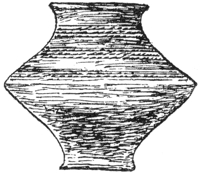
Fig. 135.
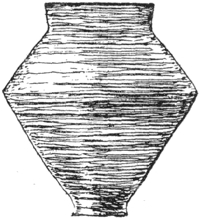
Fig. 136.
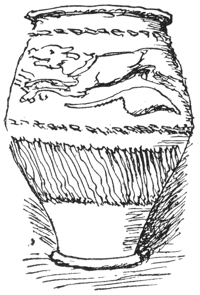
Fig. 137.
Many of the decorated pots in our museums are so clearly described by Conyers that they, too, can be identified. It is evident, for instance, that Castor-ware vessels with hunting scenes in slip were as well represented in the finds as they are in our museums to-day. Hunting itself must have been much in the people’s minds, with chariot races and the gladiator “matches.”

Fig. 138.
Sporting subjects, such as are mentioned by Conyers, are plentifully represented in our museums. In Fairholt’s sketch-book I find a drawing of a pot found in Cateaton Street (Fig. 137). There is also a sketch of a fragment of a similar urn found at Chesterford (Fig. 138). Compare the sculpture, Fig. 62. 199The piece engraved in Wright’s book as an example of a British hunting dog was also from a sketch by Fairholt of a London fragment. He also drew a piece found in Bishopsgate Street, which shows the heads of four horses, one over the other. This is explained by a complete pot at the British Museum, from Colchester, which has reliefs of racing chariots as mentioned before (p. 51). On another Colchester vase are Gladiators with their names scratched above. The eagle (Fig. 139) is from a fragment at Silchester.
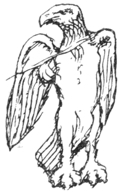
Fig. 139.

Fig. 140.
After having identified the pottery actually made in London, and the other native sources from which other wares were brought, we might go on to determine how far this native pottery is Celtic and how far Roman. Fig. 140, restored from a large fragment of very coarse make in the London Museum, and said to have been found at Mortlake, must have been made long before the Roman invasion. Figs. 135 and 136 are urns of Upchurch ware, carefully made and of lustrous 200black surface. The forms of these are not Roman. The “spirit” of all is of Bronze Age and Mycenæan character. The black pottery with “carinated” profiles found in London, and now in our museums, may be Upchurch ware, but from Conyers’ account and sketches it seems probable that black and grey pottery was made locally. In the museums, there are a few examples which seem to be clearly Celtic, as, for example, a large fragment at the British Museum with white stripes over a grey fabric. There seems, however, to have been a curious disinclination to recognise Celtic art, and a desire to call all Roman.
Samian.—The early prosperity of London is well shown by the great quantity of Samian ware which has been found of the period about 60-85, and by the examples of the work of the best makers, such as Vitalis, Rubricius, Saturnus and Rufinus. Of the first-named there are some excellent vases in the collection at South Kensington; he distributed his pottery from Carthage to Carlisle, and from Pompeii to London. Saturnus has half a chapter to himself in a big book on the Roman pottery found in Trier. The Samian question is too vast for me to attempt to deal with it here, and I can merely note one or two details. In Fairholt’s sketch-books at the Victoria and Albert Museum there are several drawings of Samian fragments. One of these, which I have not seen elsewhere, is an excellent example of animals running under trees—a scheme taken over into our Castor-ware, which Dr. Haverfield thought might be a Celtic tradition (Romanization). (Fig. 141, and compare Fig. 138.) At the Guildhall are nearly a dozen fragments of a rare kind of Samian 201vase, in which the ornament of figures and foliage was applied in separate units, the leaves, etc., being linked up by stalks skilfully done by the “barbotine” method. Three larger and some smaller fragments come from a vase of rather globular shape which was very similar to a vase found at Cornhill, one of the chief treasures of the Roman Room at the British Museum. The latter is well described in Mr. Walter’s Catalogue of Roman Pottery, which is the best account available of pottery found in London. It is not observed that the Guildhall fragments contain a figure which is half lost in the restored vase at the British Museum. On the other hand, comparison with the latter would make it easy to restore the Guildhall example. The details of both were formed by the same stamps. I give in Figs. 142 and 143 the scheme of the decoration: B was the general shape of the pot.
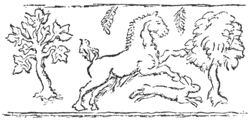
Fig. 141.
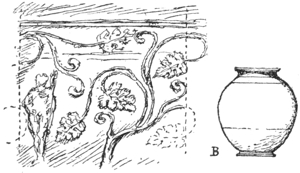
Fig. 142.
Two or three other sherds at the Guildhall belonged to a somewhat similar but smaller urn which had Bacchic subjects—a satyr with goat legs, and a faun before whom is a wine jar into which 202he seems to be dropping grape juice. These figures were evidently also set between scrolls of vegetation, and this also can be restored. Again there is a sherd of a vine pattern similar to Fig. 142, but, I think, from a third pot. There is also a figure from a dark-grey pot, which must have been yet another of the same kind. (For the last word on Samian pottery, see Oswald and Price’s Terra Sigillata.)
A volume on the pottery found in London by a specialist, like that on Silchester, would be certain to bring out valuable historical results on the existence and persistence of Celtic wares, on importations before the Claudian Conquest, and on the large quantity of imports in early Roman days.
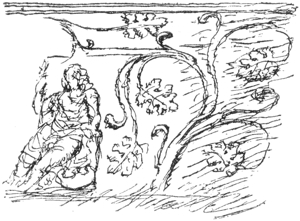
Fig. 143.
Glass.—Much broken glass is usually found on Roman sites, vessels, window-panes, etc., and it was probably wrought, in many centres, from imported material. Evidence of this has been found at Silchester and elsewhere (see Mr. T. May’s Warrington). Some window glass was described by Price as “plate polished on one side and ground on the other”; this probably means that it was cast and that the rough side came next the mould.
Conyers, describing the finds on the side of St. Paul’s in 1675, says: “The labourers told me of some remains that were found up and down near the place of the other pot-kilns, and these had a 203funnel to convey the smoke, which might serve for glass furnaces. For though not any pots with glass in them whole in the furnaces were there found, yet broken crucibles, or tests for molting of glasses, together with boltered glasses such as are to be seen remaining at glass-houses amongst the broken glass, which were glasses spoilt in the making, were there found, but not plenty, and especially coloured and prepared for jewel-like ornament, but mostly such as for cruets or glasses with a lip to drop withal of a greenish light blue colour. Of any sort of glass there was but little; so that the glasswork might be scarce, for I think a hundred times more of pots was found to one of glass....
“Now doth appear the Romans had excellent mechanics, pot makers, stampers of coins, and excellent workers in glass, for amongst those Roman pots were found glass beads as big as could be put on your little finger, and these hollow within and of blue glass wrought or enamelled with yellow glass, and blue beads of the colour of a Turkoise stone. Divided were these beads with threads as big as pack thread. Amongst the rest, great pins made of bone or ivory, etc., heads of many like the great brass-pins, and others vermicular or screw-head, others like the Pope’s triple crown; of these fell to my share as many as a pint-pot would hold.... Taken up a speculum of metal to show the face, of fine bell-metal. There were also found brass embossments with glass set instead of better jewels, which I keep, and glass drops that were loose, and the bottom of an old-fashioned crucible which had glass melted in it, and there were also pieces of necks of glass cruets to pour out by.”
Much of the large number of plainer glass vessels 204in our museums was doubtless made in the London glass works from imported metal, and probably some ornamental pieces were also manufactured. Thomas Wright thought that glass itself was made in Roman days on the coast near Brighton where “pebbles of glass” have been found; but from comparatively late records of glass making about Rye, etc., the Roman origin of the “pebbles” seems unlikely.
In the British Museum are some fragments of glass vessels having moulded reliefs of chariot races and combats, with the names of the competitors above them. T. Wright illustrates “a fragment of a very remarkable cup in green glass found in the Roman Villa at Hartlip in Kent.... Roach Smith possessed two similar fragments found in London, one of which is identical with the Hartlip fragment in its design and appears to be from the same mould; the other is from a vessel of a different shape and has a quadriga in bas-relief. We have before had occasion to observe how popular gladiatorial contests and the games of the circus were among the Roman inhabitants of this island, and how often we find them represented on the pottery as on the glass.” If a glass vessel found in Kent is exactly like another found in London, it is probable that the former was itself obtained in London, where both may have been made. One of the fragments in the British Museum is from Colchester. We have seen before how that some of the Castor-ware pots were decorated with similar racing chariots, and one of these was found in London and the other in Colchester. Racing chariots also decorate a leaden box found in London and described below.
205Glass vessels having reliefs of racing chariots have been found on the Continent, and in the British Museum Guide it is said that our examples “probably came from a Belgian workshop, as a glass of the same kind has been found at Couvin, in the province of Namur, bearing two of the same competitors’ names in a four-horse chariot race. Race cups of this kind date about A.D. 100, and have been found in France, Belgium and Germany. The six cups or fragments found in Britain were no doubt imported across the Channel.” There is, I think, room for some doubt. In any case there seems to be ample evidence that glassware was made in Britain and in Londinium.

Fig. 144.
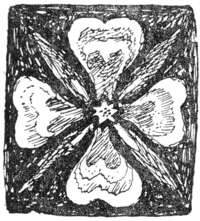
Fig. 145.
Much glass of finer quality was imported. There is in the Guildhall Museum a fragment signed by a maker of Sidon, and fragments of several small plaques in the British Museum having patterns wrought in the substance are of a kind found in Egypt. At the Egyptian exhibition of the Burlington Club, 1921, similar plaques were shown, some having sprigs of flowers, and one a single rose petal pattern in yellow, white and red on the dark ground (cf. Fig. 145). The three pieces at the British Museum are all different and all can be 206restored. Fig. 144 is from Roach Smith. Fig. 145 is a rough indication of the pattern of another, and the third is a variant of Fig. 144. These interesting and beautiful little fragments are obscure from age; they might with great advantage be partially repolished, laid out on restored drawings, and be made much of. The recent rearrangement of the contents of the Roman Room at the British Museum, and the admirable new Guide, have so greatly increased the interest of the objects that I want still more. I also wish that the London things in the collection could be shown together. Roach Smith never intended his objects to be separated.
Enamels.—Conyers’ phrases about coloured glass “prepared for jewel-like ornament,” and “the brass embossments with glass set instead of jewels,” apparently refer to enamels and seem to imply that enamelled objects were made at the London glass works.
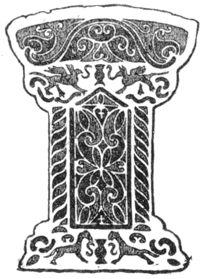
Fig. 146.

Fig. 147.
A large number of small enamelled objects, from little bowls to brooches, have been found in Britain. The art of enamelling was known here before the Roman age, but objects having several colours seem to be “Roman,” although there are Celtic characteristics in the patterns, and it is agreed that there was a native manufacture (British Museum Guide, p. 95) of such enamels. The finest piece is a “casket” in the form of a little vase with a handle. This handle has turned-up ends of a kind frequently found in Alexandrian silverwork. One of the bands of enamel is a meandering stem and vine leaves. This beautiful object was found in Essex, and there is in the British Museum another little enamelled bowl also found not far from London, at Braughing, Hertfordshire. The details 207in these two pieces are very similar, so are those of a little enamelled cock found near the Royal Exchange. Notice the use of long triangular forms and narrow saw-edged fillets. It seems probable that all were made in London, and further evidence is found in a remarkable enamelled plate taken out of the Thames (Fig. 146). This “being an unfinished piece, was probably made in this country”—and city, I would add. In colouring and technique this plate (probably part of a memorial) is very like the objects already mentioned. A leaf form on it which ends in a tendril is found also on the Braughing bowl; both these pieces might have come from one shop. The type of ornament is remarkably Celtic. In the Guide it is said that “debased Amazon shields can be recognised, and Riegel has pointed out that the panel is not a unit, but belongs to a larger all-over pattern which could be repeated indefinitely, and reveals an artistic tendency of the later Roman Empire.” I do not agree with either of these statements. The pattern seems to me to have been designed as a reversed scroll pattern, subdivided by setting down oval forms in the spaces to counterchange the colour in a typically Celtic manner. In the diagram (Fig. 147), A is the pattern 208type; B is the application to the space; C is the subdivision of the spaces completing the design. In D and E, I have made an original design on the same principle. Other details in the filling of the space at the top are Celtic. Notice again a heart-shaped form at X. This form is frequent in small seal-boxes, several of which have been found in London, of which F is from one lately added to the Guildhall collection. It is probable, I think, that such enamels were made in London by Celtic artists. An enamelled harness plate found in London and illustrated by Roach Smith is like others found in Somersetshire (see G). A small brooch in the form of a fish at the London Museum may be early Christian.
Leadwork.—Britain was the chief source for lead in the later Roman era. Of about a hundred and twenty Roman pigs of lead in the museums of Europe, about half were of British origin, as appears from the inscriptions. Cast sheet lead was used for coverings. Some actually in position was found lining the bottom of the hot bath at Bath in 1864. It was afterwards sold for £70! Mr. Irvine, in an article on the Corinthian temple at Bath, assumes that the roof was covered with lead. He says that the sheet lead found in Bath was about three-eighths of an inch thick and showed that it was cast on a sand-bed. Melted lead was found at St. Albans under conditions which suggested that it had come from the roof of the Basilica. We may be satisfied that lead was used for important roofs. Lead pipes are also found.
Many lead coffins have been found in and about London—about a dozen in all—and they were doubtless made in the city. The fashion of using 209lead coffins seems to have originated in the Romanised East about the time of the recognition of Christianity, and those found in London follow the general type very closely. I give in Fig. 148 a rough sketch made in Constantinople twenty-five years ago of a lead coffin found at Sidon. Another coffin from Sidon has recently been acquired by the British Museum. Figs. 149, 150 and 151 are from coffins found in London.
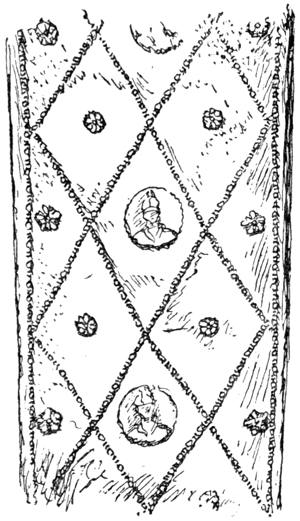
Fig. 148.

Fig. 149.
One discovered many years ago in South London, illustrated in Archæologia, vol. xvii., had on it two little figures like Minerva—probably Britannia. Another found at Sittingbourne, recently set out for exhibition at the British Museum, has little Medusa heads and pairs of lions watching a vase (Fig. 152).

Fig. 150.

Fig. 151
210A round lead box, for the reception of burnt bones, found in London and now in the British Museum, has repeated on it a relief of a four-horse chariot. This is described in the Guide as the chariot of the Sun; but comparison with other chariot-racing groups on the pottery and glass vessels shows that these reliefs must also represent a chariot race (Fig. 153). This fact adds to the probability that the glass vessels with reliefs of racing chariots were also made in Londinium. Fig. 154 is from a simpler lead box found in London; compare the rings with the painted pattern described at the bottom of p. 169.
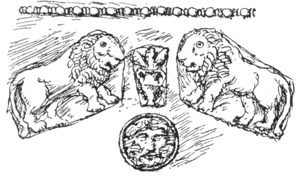
Fig. 152.
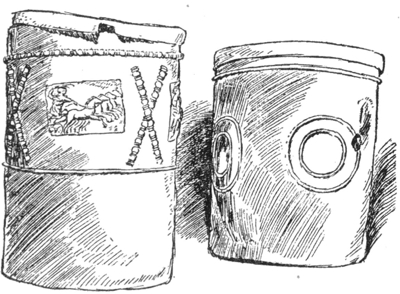
Fig. 153. Fig. 154.
211Pewter.—A large quantity of pewter ware, vessels and dishes, has been discovered in Britain. Many ingots of the metal were found in the last century at Battersea in the river. Lysons figured a fragment of “lead” found at Lydney stamped with a name, and this may have been pewter. The ingots of pewter were doubtless of British origin, and it is very probable that the finished objects of this metal were manufactured here. Many of the dishes have engraved centres of a type of design which can hardly be earlier than the fourth century. This engraving was filled with black composition imitating niello. The ingots 212bear marks which show that they belong to a time when Christianity was recognised.
In the London Museum is a dish with an engraved centre, and at the British Museum are some plain dishes signed with the name of the owner or maker, Martinus, which were found in Southwark. Most of the finds of pewter ware have been made in south-east England, and London is the most likely place of origin. Lysons illustrates a dish found at Manchester (it is now in the British Museum) with an engraved centre so like those found in the south of England that it is probable it also was made in the south. These dishes were finished in a lathe; at the back they have traces of three projections by which they were held in turning but afterwards cut away.
Bone, Leatherwork, etc.—We have seen above that Conyers speaks of the large quantity of bone objects found in excavations. Of the St. Paul’s site he says: “And amongst ye heap or mixture of rubbish, hartshorn sawed into pieces, old heifers’ horns, and abundance of boars’ tusks—some in their jaw bones which shows that they did often hunt ye wild boar.... It is very remarkable that ivory-work and great pins made of bone and bodkins of great numbers was found buried together with store of boars’ teeth, of oysters and other shells, Roman coins and ornamental beads, of blue like enamel and the fibulæ they used to fasten their garments, earthenware with inscriptions and glass was found in gravel pits near St. Paul’s School.” Several carved pieces of similar style in the London Museum—notably little reliefs of gladiators—suggest that there were expert bone carvers in London. A bone pin with a figure of Fortuna 213found in London, and a carving of a sphinx from Colchester—both in the British Museum—are really beautiful work. The admirable fragments of an ivory scabbard found in Greenwich Park in 1906 can hardly be London work.
A considerable number of beautifully-made leather shoes having elaborately pierced patterns are doubtless of local work. One found at South-fleet, now at the British Museum, was coloured purple and decorated with gilding, as is recorded on a drawing at the Society of Antiquaries, made when it was newly found.
The site of London is still unexhausted; even while I am writing this I see in the morning’s paper, “Recent excavations in Lothbury have brought to light relics of Roman occupation—bone bodkins, oyster shells and broken pottery. The bodkins are large, and it is thought that they were probably used in mat-making.” London must have been an art-producing centre for two thousand years.
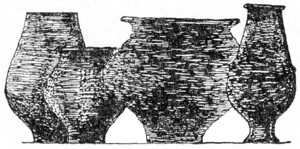
Locally made Pottery.
“It was no longer thought to be Britain but a Roman island; and all their money was stamped with Cæsar’s image. Meanwhile these islands, stiff with frost, received the beams of light, the holy precepts of Christ, the true Sun, at the later part of the reign of Tiberius Cæsar.”
CHRISTIAN BRITAIN.—The whole subject of Christian antiquities in Britain was for a long time clouded by mere doubt of testimony, until the comparatively recent discovery of the foundations of an early Christian basilican church at Silchester, in 1892, gradually changed the temperature and atmosphere in which facts are seen. Thomas Wright had swept the thing aside, Gildas and all. This difference of attitude is well brought out in the earlier and more recent writings of Dr. Haverfield. Compare, for instance, his over-cautious article in the English Historical Review about twenty years ago with another in Archæologia Æliana, 1917, which is written in quite a different temper. It is now clear that Britain marched with Gaul in the acceptance of Christianity, although one step behind.
In Cabrol’s great French Dictionary of Christian Antiquities we may obtain a valuable unbiased account of British Christian antiquities. The best general introduction known to me is a chapter in 215Sir C. Oman’s excellent England before the Norman Conquest, from which I will condense a paragraph.
“There is no doubt that individual Christians, perhaps even small communities, were to be found in Britain as early as the second century. There is no reason to doubt Tertullian writing in about A.D. 208, or Origen writing about A.D. 230, that the Christian religion had converts in the province of the extreme north-west.... In the long peace which followed the persecution of Severus the new religion pushed northward and westward with greater power. There seems no reason to doubt the small number of British martyrs whose names appear in the earliest martyrologies. The very early martyrology gives three names drawn from Britain—the latest St. Patrick (obiit c. 461), the other two are Augulus, bishop of Augusta (London), and Alban. We know nothing of Augulus, but the fact that his See is called Augusta shows that the name was taken down between 340 and 410, for London was only known as Augusta in the second half of the fourth century. Of Alban’s existence our knowledge is more certain, since Germanus visited his grave in 429; his cult, therefore, was well established in the early fifth century.... As early as 314, three bishops from Britain appeared at the Council of Arles—Eborius of York, Restitutus of London and Adelphius of Lincoln. There seems reason to think that the bulk of the population remained pagan till a later date than was the case elsewhere. If the Christians of Calleva found the diminutive church lately discovered sufficient for their needs they must have been but a few hundreds. In that same town a temple to Mars was found, which must have been used down to the end. If 216Calleva had become completely Christian before its evacuation the image of Mars would not have been left. The small number of Christian sepulchral inscriptions is notable, though such have been found at Carlisle, Lincoln and elsewhere. It is very strange that a religion which was first publicly tolerated, and later encouraged for nearly a hundred years before A.D. 410, should have left so few records. The existence of a vigorous British Christendom in the fourth century is sufficiently proved by literary evidence. Without that evidence we should have gathered little from archæological research. Secular inscriptions and buildings of the fourth century are rare, no less than ecclesiastical ones. The British Church produced, in the last days of the Romans, a heresiarch, the celebrated Pelagius, a monk. Born about 370-80, he taught in Rome itself. The earliest recorded works written by Britons are those of the heresiarch and of a British bishop named Fastidius.”
In an excellent short account of British Christian antiquities in the new Guide to the Christian Collection at the British Museum (1921), Mr. Dalton remarks that “the statement of the sixth-century British historian, Gildas, that in Roman times Britain had many churches was always credible, but positive proof was not forthcoming until the excavations on the site of Calleva (Silchester) brought to light the foundations of a church, the Roman origin of which is beyond dispute.” Gildas, again, is confirmed by Bede’s account of ruined Christian churches existing in the sixth century. According to Cabrol’s Dictionary even some of the greater country villas, like Chedworth, were occupied by Christian proprietors. On a mosaic pavement 217at Frampton the monogram of Christ appears in the central space of a border. It has been argued that the monogram might be later than the pavement, but the design of the border itself shows that it had a central feature from the first. It seems probable to me, as before said, that several other mosaic pavements were Christian.
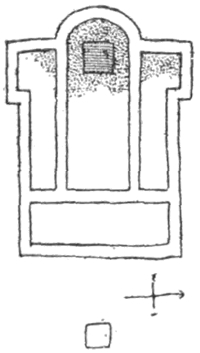
Fig. 155.

Fig. 156.
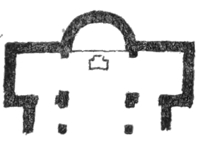
Fig. 157.
A British Church.—The little church at Silchester is extraordinarily interesting in many ways. It was probably built not later than the middle of the fourth century and is thus one of the earliest churches known. It occupied an important position in the city close to the Forum, and it is probable from this and from the importance of the city that it was a bishop’s church. Moreover, it is evident that if there was such a church at Silchester there must have been others in Canterbury, Verulam, London and other cities. This church was only about 30 ft. square, exclusive of the narthex (Fig. 155). Some day, when we reverence our antiquities more, it might be excavated once again and, having a decent roof erected over it, be made a place of pilgrimage. I should like to see a copy of it put up somewhere for use—it might cost half as much as 218a poor stained-glass window. As I have just said, the plan, exclusive of the narthex, was square, so also is the plan of an early church in Asia Minor which I give for comparison (Fig. 156). This squareness was, I believe, intended as a symbol of the Ark. I also give the altar end of an early church in Greece, Fig. 157 (Nichopoleos: see Athenian Ephemeris, 1916).
The plan of the Silchester church seems to be of an Eastern rather than Roman type; and small as it is, it has slight transeptal projections which, when compared with the other plans, show that the form of the cross was intended to be suggested. The altar was not regarded as being in the apse, but rather in front of it (compare Fig. 157). The apse was to the west and the entrance at the east, following the early custom. In front was a court with a water basin in the centre. In regard to the non-Roman character of the plan, it may be noted that the late Mr. Edmund Bishop, a great liturgical authority, showed that early Irish Christianity was of an Iberian type.
London Saints.—Bishop Augulus and Restitutus of London ought to be commemorated in some way in the City. We are singularly wasteful of the power there is in the antiquities of a nation when sympathetically understood. If, for instance, Patrick had been recognised for the great British personage he was—the son and grandson of Christian parents captured to be a slave in Ireland—the magnanimous missionary might have been a mediator between the Irish and ourselves, a mixed race, part English, part British and part Roman. St. Augulus is included in the Roman Catholic Menology of the British Church. “Feb. 7.—In London the 219Passion of St. Augulus, Bishop and Martyr (A.D. 300 c.). Named on this day in the Roman Martyrology and in all the ancient calendars as a bishop who suffered martyrdom in London. The conjecture of historians is that he suffered in the persecution of Diocletian about the same time as St. Alban.” He is given a place in the paintings of the English College, Rome. It is curious that of two contemporary martyrs, St. Alban should have been taken up by fame and the other left. Confirmation of the point made by Sir C. Oman in regard to the name Augusta applied to London has appeared in the recent identification by Sir A. Evans of a late fourth-century coin with the Mint mark AVG.
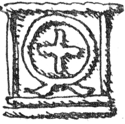
Fig. 158.
Early Christian Objects.—The earliest existing “monument” of Christian Londinium is dated only a little later than the year in which Restitutus attended the Council of Arles. This is the reverse of a coin of Constantine, recently discovered (1909) at Poltross Burn, on the great Roman Wall, and thus described: “Mint mark PLN; of the London Mint and bearing the Christian emblem; A.D. 317-324; variety of Cohen 638. Two Victories placing on an altar a shield inscribed VOT. PR.; on the face of the altar a cross within a wreath. This is a London-minted coin bearing upon its reverse the Christian emblem of such rarity that the use of Christian emblems in the London Mint has been called in question. The only recorded specimens are a coin of Constantine II. in the British Museum, one of Crispus, found in 1909 at Corstopitum, and the present example. All have the same reverse” (Fig. 158). This is in every way a very remarkable coin; the Victories placing the shield on a Christian altar is obviously a record of 220the official recognition of Christianity. From this moment when the Cross appeared on what Sir C. Oman calls “the public gazette of the Roman Empire,” every one in Londinium must have known what the Cross stood for. “In an issue of money between 317 and 324, Constantine used Christian signs in such a way as to solemnly affirm his Christian faith, and thus by universal custom made known the imperial will. The coins of London hardly make the same affirmation of Christianity by the Emperor as that of Siscia, but they testify to the intentions of certain officers of the Mint” (Maurice, Numis. Constant.). On the coin of Crispus mentioned above, the Classical Year Book, 1911, remarked: “This is a novelty, as hitherto it has been supposed that Christian symbols did not occur on London coins of the Constantinian epoch.” “It is curious that the London Mint put Christian emblems on its coins before those of Trier, Lyons or Arles” (Oman).

Fig. 159.
With the coins may be associated a small silver disc mounted as the head of a pin, now in the Roach Smith collection at the British Museum. My figure is from a drawing by Fairholt, according to whom it was found in Lothbury with several other small Roman objects. It seems quite certainly to represent, as Roach Smith supposed, Constantine’s vision of the Cross in the heavens (Fig. 159).
221A small equal-armed cross forms the clasp of a Roman bronze chain-bracelet found in London, now in the British Museum, which can hardly be other than Christian (Fig. 160). There has been some reluctance in accepting crosses of Roman date as Christian, but the evidence of the coins should modify this.

Fig. 160.
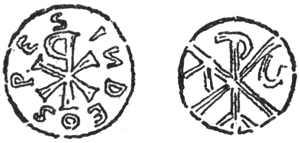
Fig. 161.
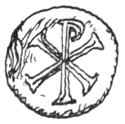
Fig. 162.
In 1862 several ingots of pewter were dredged up from the Thames near Battersea Bridge, and in 1890 more were discovered. Two are in the York Museum and the rest are in the British Museum (Archæol. Journal, 48). They are stamped with the monogram of Christ in two forms, with one of which is associated the words, “Spes in Deo” (Fig. 161), and the name “Syagrius” also appears. Silver and copper ingots discovered in this country have official stamps (non-Christian), and it may not be doubted that the pewter marks were also official. A lead seal in the Reading Museum, found in the Civil Basilica at Silchester, has an XP monogram, which is very similar (Fig. 162), and this, too, was probably official. The most interesting parallel known to me of the stamps on the pewter ingots is a seal from 222a wine jar found at Naucratis, in Egypt (Nau. ii. pl. 22), where we find “Spes in Deo” in a circle around a cross (Fig. 163). The circular form had long been used for official stamps (cf. a brick stamp with the name of Nero in Reading Museum). Pewter ware was popular at the end of the fourth century, and this is probably the date of our ingots. The name which appears on them was in use at a late time. One Syagrius, “last of the Romans,” was driven from his kingdom of Soissons by the Franks in A.D. 480.
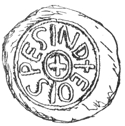
Fig. 163.
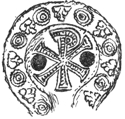
Fig. 164.
At the Guildhall Museum are two small terra-cotta lamps (Nos. 17 and 18), each having the Christian monogram in the centre (Fig. 164). These are not of British make, but they may have been imported in the Roman age. (A lamp which Sir L. Gomme made much of, with a little view of a city on it, was also of foreign origin, and there is no reason to think that the view had any connection with London.) Two other lamps in the Guildhall collection (Nos. 54 and 117) are described as having “limbs of cross on body, perhaps early Christian,” but I have not found these and some other objects which it is said may possibly be Christian.
In the description of Wren’s finds on the site 223of St. Paul’s, given in Parentalia, is mentioned “a sepulchral earthen lamp figured with two branches of palms, supposed Christian.” Comparing the description with Figs. 165 and 166 there cannot be any doubt that Wren’s lamp was Christian. In the British Museum is a little rough lamp found at Tidworth, Wilts, which has a pair of palm branches, and I think that there is another in Canterbury Museum; the former is so like others from Syria in the Early Christian Room at the British Museum that there cannot be a doubt that it is not a native work; possibly it was brought back by a pilgrim from the Holy Land. Fig. 165 illustrates the seal of a ring found at Fifehead Neville, Dorset, now in the British Museum; on it we find the sign of Christ in the later form (in which the X has become a cross) surmounted by a dove, and between two palms. It means something like “the Believer resting on the victorious Cross of Christ.” The earlier form of the monogram was made of the first two letters of the name Christ, XP; the later form was formed by a cross and XP or P, and this seems to have meant the Crucifixion.

Fig. 165.
These comparisons will help to interpret a fascinating fragment of a symbolical design engraved on a glass cup found at Silchester. Here, instead of the sign for Christ, we find the upper part of a letter, which can hardly have been anything else than T, for nothing else would be central in the design, and in place of the dove we have a fish. T was the early form of the sign of the cross, and is found several times in the Catacombs; the fish is a rebus for the words Jesus Christ, God’s Son 224Saviour (ΙΧΘΎΣ); the palms are again signs of victory. It seems to be an early symbolical representation of Christ on the cross, and one of the most interesting which exists (compare Figs. 46 and 47 in the British Museum Guide to Christian Antiquities). Another tiny fragment of the same glass has the letter O on it, and there must have been some short inscription as well as the fish symbol and palms (Fig. 166).
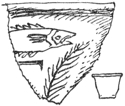
Fig. 166.
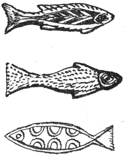
Figs. 167, 168, 169.
In the London Museum is an enamelled brooch in the form of a fish (Fig. 167). As the fish was a well-known Christian symbol, we may hardly doubt that this brooch must be counted among our Christian antiquities. It is exactly similar to a brooch illustrated by Mr. Ward (Roman Era, Fig. 75) as having been found in Rotherley. They are duplicates, and must have come from the same “shop.” In V.C.H. it is recorded that a fish-shaped enamelled fibula was found in excavations at London Wall in 1901-5 (compare Builder, December 13, 1902). This may be the same piece. At Silchester a plain bronze brooch in fish form was found (Fig. 168). The fish symbol in an almost identical form is found engraved on a pewter dish, one of a set found at Appleshaw (Hants) and now in the British Museum (Fig. 169); the dish itself on which it appears is sometimes described as fish-shaped, 225but it was rather a long oval with projections at the ends. Another of the same set of pewter pieces has the XP monogram engraved on it (Fig. 170). As a third of the pieces is of the form of a chalice, there seems to be every reason to regard the whole set as church plate, and I find this definitely asserted in an article in the Athenæum (August 11, 1906): “In 1890 a body was found at Reading lying east and west, together with Roman British relics, and a lead plate bearing three crosses; near by was another skeleton with a small pewter chalice. This may be accepted as the grave of a Christian priest. This chalice should be compared with that of a Roman altar set of pewter recently found at Appleshaw.”
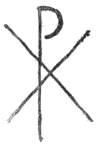
Fig. 170.
As said before, when tombs and coffins were discussed, it is probable that some of these represent Christian burials. A coin of the Emperor Gratian bearing the monogram of Christ was found at Smithfield, together with some wooden coffins, and it was probably buried as a sign of faith (V.C.H.). Two or three rough stone coffins found in Kent seem to have been Christian. The first bishops of the Saxon church at Canterbury were interred in stone coffins of a Roman type.
St. Peters, Cornhill.—Ancient tradition, which may be traced back to the twelfth century, claimed that the Church of St. Peter on Cornhill was older than St. Paul’s Cathedral, and a church of Roman foundation. The site is important, being close to (as I suppose) or within the boundary of the Forum and Civil Basilica of Londinium. The main walls of the present church are neither parallel with Cornhill nor square with Gracechurch Street, and Roman 226foundations have recently been found in the neighbourhood of the church. Until all the lines of the walls which have been discovered have been carefully laid down on a large-scale plan, it would be rash to offer any opinion as to a possible Roman foundation of the church; but if the church should prove to have been near, but outside the Forum, the position of the church at Silchester would be significant evidence. If, on the other hand, the church site proves to have been within the boundary of the Forum, its Roman foundation would be improbable.
Recent records of finds near the church mention “an old piece of Roman wall passing through the present wall of the church at a slight angle under demolished buildings [along the north front].... This may possibly belong to the original church” (March 2, 1922). From an article in The Times of September 29, 1922, I condense the following account of discoveries made at the end of the year 1921 on the north side of St. Peter’s Church: “A magnificent wall went down about 20 ft., but at 15 ft. were the footings. The wall was here 5 ft. wide; above the footings were three courses of tiles four abreast, each 13 in. wide, making 52 in. wide. This wall had been plastered on the south side, and at some subsequent date [?] rooms had been made by other walls, on the plastering of which was still to be seen a pattern of imitation marble or alabaster. There were two layers of plaster and then a layer of white cement almost as thin as paper, on which designs had been painted by a skilful artist. This wall had been broken down, and at a level 5½ ft. higher, a tessellated pavement had been laid. Later, at 56 and 57 Cornhill, a similar wall 227was uncovered. The mortar joints between the tiles were wide. The wall was found on the south [afterwards corrected to north] side of the church wall, so that the ancient Church of St. Peter was probably built inside what was a Roman fortress.” For fortress I would read the Forum. The church can hardly have been founded in such a position until the Forum had gone out of use and the Roman age in Londinium had passed, but it might then very well have been constructed within old Roman walls or on their foundations. We saw before that wall tiles of exceptional size had been used in the Civil Basilica of the Forum, and the tiles, 13 in. wide, mentioned above would seem to be of the same size. Twenty-five years ago a Roman wall was found, described as “very close to St. Peter’s upon Cornhill, of immense thickness, proceeding in a westerly direction from Leadenhall Market, under the Woolpack Tavern in Gracechurch Street, along St. Peter’s Alley, a few feet on the south side of St. Peter’s, continuing under the banking-house of Messrs. Prescott, Dimsdale & Co. (50 Cornhill), supposed to continue under the roadway of Cornhill, and appearing again in the foundations of the new building now being erected on the north side of Cornhill (No. 70) for the Union Bank of Australia.” (Middlesex and Herts Notes and Queries, 1897.) This wall, if one may guess, appears to have been parallel to the 5 ft. wall on the north of the church, and between them seem to have been important chambers of the Forum buildings.
Dr. Bury has lately given reasons for thinking that the Romans did not finally evacuate Britain until 442 (J.R.S., vol. x.).
3. The substance of this chapter was read at the Society of Antiquaries about 1917, but it has not been printed before.
FIRST BRITISH CITIES.—Ancient cities were not planted down by an act of will, they sprang up on lines of communication as centres of control and commerce. On a geological map it appears that a chalk belt passes from Kent to Hampshire towards the south bank of the Thames. From the north bank another wide belt diverges to the north-east. The backbones of these chalk regions are the North Downs of Kent and the Chiltern Hills; they contain between them a long triangle of gravel drift and marsh flats through which the Thames flows to the sea. These downs, as we know to-day, when we find ourselves on them, are pre-eminently walking grounds, and they must have been the prehistoric ways of communication. “Primitive man traversed the ranges lengthways: in the valleys were forests almost impenetrable, whereas the backbone of each ridge would stand bald above the 229ocean of trees.” The oldest roads were “Ridge-ways.” On the high Wiltshire downs at, or near, a point where the southern system of downs converge, stands Stonehenge, and I cannot doubt that it was in some way conceived as being a centre and “capital” of the country. The Gauls recognised such a centre, or “omphalos,” near Chartres. Since writing this, I find that Sir C. Oman has said, “Britain must have had some focus corresponding to that for Gaul; possibly among the prehistoric monuments of Salisbury Plain.” Stonehenge, I may say in passing, is a monument of wrought stone set out with precision, and I cannot see how it can be earlier than about 500-700 B.C.
The ancient trackway along the Chilterns, known as the Ickneld Way, reached the Thames near Wallingford. Travellers going south and east from this point struck across the narrow space of low broken ground between the two chalk ranges by a short linking road. Silchester, the capital of an important Brito-Belgic tribe, lies on or near the course of such a road in a corn-bearing region. Silchester was the key of the old road system over the Thames fords. It is known to have been one of three most important pre-Roman British centres, and we may, I think, look on it as the first British city.
The British city of Verulamium lay to the south of the Ickneld Way, in the same great triangle between the two chalk regions which is here much wider. The rise of this centre suggests that a road linking the two chalk ranges had been found across the river valley much lower than Silchester. The later Roman Watling Street, directed straight 230on Verulam, formed such a link, and there are many reasons which suggests that some underlying British trackway must have been the cause why Verulam became important. Later, again, Colchester came to be the chief city. Possibly it was favoured as being more remote when the Romans should make an attack. It seems to have been named after the Celtic war-god, and this may be significant. (In Roman days as in mediæval, there was probably a ferry from Gravesend to Tilbury for direct access to Colchester from Kent. This seems to be suggested by the Peutinger roadmap.)
Origin of London.—By origin I mean the beginning of a development which led to the establishment of a port and commercial town. Doubtless the site may have been occupied by some dwellers in the Stone Age. For many centuries before the Roman conquest Britain had been in commercial relations with the Continent. Just before the conquest Verulam was the capital of the leading Celtic kingdom. This Brito-Belgic kingdom had its southern boundary along the Thames and its eastern at the Lea, and these are still boundaries of Middlesex. If this kingdom, with its capital some twenty miles inland, had any sea-borne trade, its port must have been on or near the site of London. It is even probable that this port was the cause of the pre-eminence of the little kingdom to which it belonged. The port was to Verulam what the Piræus was to Athens, Ostia to Rome, Dover to Canterbury, and Southampton to Winchester. London was doubtless the source of the wealth of King Cymbeline, and we might very well look on him as the founder.
231Dr. Guest argued that London was founded as a Roman camp at the time of the Claudian conquest; but it is now agreed that the name is Celtic; and it must not be forgotten that London is and always was a port. When we first hear of London only seventeen years after the Claudian conquest, it was already, as Tacitus says, famous for the number of its merchants, and this must imply that it was a principal port. Dr. Haverfield, while admitting that the name is Celtic, went on to say: “The name Londinium, the place of Londinos, witnesses at most to nothing more than one wigwam or one barn.” This “at most” can only mean that every town presumably begins with one building; in London, however, the building is not likely to have been a barn amid the bare gravels, but rather a boatman’s house. Further evidence for the existence of a pre-Roman town is brought out by the large number of Celtic objects found on the site and in the neighbourhood, but they have never been properly catalogued as a group. Dr. Haverfield allowed that three pieces of imported Samian ware in the British Museum might belong to the period A.D. 10-40. “We might then conclude that through the influx of Roman traders London had been noted as a suitable trading centre a few years previous to the Roman conquest; but the minute dating of these potsherds is not easy, and we must leave the question of pre-Roman London unsettled. Either there was no pre-Roman London, or it was an undeveloped settlement, which may have been on the south bank of the Thames” (Journ. Rom. Studies, vol. i. p. 146). The evidence of such early imports is greatly strengthened by other discoveries at Silchester. Mr. May, speaking 232of the early “Samian” ware, says: “The Silchester examples are of much significance. Together with the contemporary Belgic imitations they prove that the inhabitants of the capital of the Atrebati were importing costly luxuries in considerable quantities from Italy and Northern Gaul at the beginning of the Christian era.” Early Belgic pottery has been found in London as well as “Samian,” and there is in the British Museum a wine jar of an early type found in Southwark. Some British pottery was doubtless made in Londinium itself before the Roman conquest. Mr. Lambert has described specimens of coarse wares in Archæologia. Of one of these he writes: “Bead-rimmed pot, coarse grey ware, irregularly burnt. A pre-Roman type, surviving into the Roman period.” He dates it A.D. 50-80, I suppose thinking that it cannot have really been pre-Roman.
London above bridge is an inland city, the English capital; below bridge it is a great seaport. In a description of England, published in 1753, I find this: “That part of the Thames, which is properly the harbour, is called the Pool, and begins at the turning out of Limehouse Reach and extends to the Custom House quays. In this compass I had the curiosity to count the ships, and I have found about 2000 sail of all sorts of vessels that really go to sea.” In a twelfth-century rhyme on English towns are the words, “London for ships most.” Bede describes London as a great ship port. The city is placed just where the Thames widened into an estuary. At Battersea the river was little wider two thousand years ago than at present; it overflowed wide spaces of marsh about Westminster and again contracted by London. Her high ground 233came close to the water on the north, and on the Southwark side there was only a narrow margin of low ground. Directly to the east of London was the low land called in the Middle Ages “Wapping Marsh” (Middlesex Feet of Fines). In the Pepys collection at Cambridge I have seen an engraved plan of “Lands by Wall or Wapping Marsh, 1683: seven acres of land in which the millponds and ditches did all over dispersedly lie.” Stow tells of Limehouse marshes being “drowned.” Before the lower Thames was embanked the river must have been two or three miles wide, at every tide, a little below London, where the considerable little river, the Lea, runs into it. The higher ground of the site of London is in the angle formed by the Thames and Lea, and is the extremity of the northern hills, Highgate and Islington. From the hills several streams flowed through deeply excavated beds into the Thames. The most considerable of these was the Fleet; the smaller Walbrook intersected the site of the city. Conyers in his MS. at the British Museum noted how the Fleet was embanked in 1675 with material taken from old St. Paul’s, “to narrow-in the spreading breadth of Fleet River.... The waters overflowed these parts in the old times.” The general topographical conditions were well observed by Drayton in Polyolbion—The city was built on a rising bank of gravel and sand, surrounded by lower ground: the tide flowing up the Lea and Fleet prevented the town from growing too long: to the north and south of the Thames were ranges of hills: “And such a road for ships scarce all the world commands.”
Way to the Port.—The men who first came to 234the site of London must have come from the higher ground of Islington and Highgate; they did not cross the Lea or the Fleet. Before some engineering was done the natural way was from the direction of Verulam. Now, an ancient road lies along this course from St. Albans to Aldersgate. As it approaches London it passes between the Walbrook and the Fleet, pointing towards what the old tablet near St. Paul’s says is the highest land in the city. The Walbrook where it fell into the Thames must have had steep clean gravel banks containing a tidal inlet—a perfect landing-place where small ancient ships could be brought alongside. This creek, afterwards known as Dowgate, must have been the original port of London. Along the old road wine, pottery and bronzes were carried into the interior, and corn was brought for export. Dowgate is known as a port for foreign ships from Saxon days (Round’s Commune of London). It is especially interesting to find from Stow that in the fifteenth century the Abbot of St. Albans had a quay by Dowgate. (Old writers supposed that “Dow” represented the British word for water; recent scholars equate it with Dove; but even so there is the curious analogy with Dover and such like place-names.) The Roman gates of London, of course, opened on important routes, and “the street from Aldersgate to Islington” is mentioned in the twelfth century (Middlesex Feet of Fines). Stow says: “From the further end of Aldersgate Street straight north to the Bar is called Goswell Street. Beyond leaving the Charterhouse on the left hand the way stretcheth up towards Iseldon.” Again on the old woodcut, usually called Aggas’s map, the street out of Aldersgate 235is inscribed “the way to St. Albans.” That excellent old book, John Nelson’s History of Islington, carries the account of this road forward, and he thought that it was Roman. He quotes a passage from Norden, to the effect that it passed east of Highgate through Tollington Lane to Crouch End, Hornsey Park, Muswell Hill, etc. “Tolentone,” he points out, is mentioned in Domesday. This road is laid down on old maps. Recent modifications at Islington may be made out by comparing maps given by Nelson and by Lewis in 1842.
I now quote the passage relating to this old ridgeway road to Verulam from Norden’s MS. (British Museum, 570). He begins at Clerkenwell instead of from the City: “It is not to be omitted to declare the old and ancient highways heretofore used by our fathers though the new be of greater regard and account for that they yield more ease unto the travellers. There was an old way that passed from Clerkenwell as also from Portpoole [Gray’s Inn] towards Barnet and so to St. Albans. From Clerkenwell it extended as the way now is unto a bridge or brooke between Gray’s Inn Lane and Pancras Church, near which brooke it entered into an old lane leaving Pancras Church on the west. It is called Longwich Lane, through which lane it passed along leaving also Highgate on the west and passed through Tollington Lane, whence it extended to Crouch End and thence through the Park to Muswell Hill near by Colney Hatch and so to Friern Barnet, from thence to Whetstone and there meeteth the new way. The cause why travellers left this old and ancient way was the deep and dirty passage in the winter.”
The road is well described in Pennant’s Tour 236(1782): “On quitting St. Albans I passed the wall of Sopwell Nunnery mixed with quantities of Roman tiles. After London Colney on the Colne I reached Ridgehill (!), a most extensive view. At South Mimms enter Middlesex and about a mile farther made Barnet; in Saxon times a vast wood filled this tract. From this town is a quick descent. Just beyond Whetstone the road passes over Finchley Common, infamous for robberies, and often planted with gibbets. About a mile beyond stands Highgate, a large village seated on a lofty eminence overlooking the smoky extent beneath. Here, in my memory, stood a gateway at which in old time a toll was paid to the Bishop of London for liberty, granted between four and five hundred years ago, for passing from Whetstone along the present road instead of the old miry way by Friern Barnet, Colnie Hatch, Muswell Hill, Crouch End, and leaving Highgate to the west by the Church of St. Pancras. After resting for a small space over the busy prospect, I descended into the plain, reached the metropolis, and disappeared in the crowd.”
The old miry way by Crouch End is, I cannot doubt, the original British road from Verulam to Londinium. (St. Pancras, it may be mentioned here, must be a very old settlement; near by was a bridge over the Fleet River, at a later time called “Battle Bridge,” on which name theories have been founded, but I think the bridge may have taken the place of “Bradford in the Parish of St. Pancras,” mentioned in the Feet of Fines, 23 H. viii.)
A summer’s day journey to London, such as Matthew Paris would have known it, must have been of beauty unimaginable when the miry lane 237was not too wet. Mention is made in the time of Henry VIII. of “a capital messuage called Muswell Farm in the parish of Clerkenwell and Hornsey, and the site of a certain chapel in the said parish, now dissolved, lately called Muswell Chapel” (Middlesex Feet of Fines, 35 H. viii.). A memory of the view of St. Paul’s rising from the midst of the walled city is given in a little sketch by Matthew Paris himself. I find this of Highgate in 1753: “On the summit of the hill a view over the whole vale to the city, and that so eminently that they see the ships passing up and down the river for twelve or fifteen miles below London.” Of Hampstead: “The Heath affords a most beautiful prospect, for we see within eight miles of Northampton, and the prospect to London and beyond it to Banstead Downs, Shooter’s Hill, Red Hill, and Windsor Castle is uninterrupted.”
A note of Camden speaks of another old road striking across to Edgware. “Hampstead Heath, from which you have a most pleasant prospect of the most beautiful city of London and the lovely country about it, over which the ancient Roman military way led to Verulam by Edgworth and not by Highgate as now, which new way was opened by the Bishop of London about 300 years since.”
Drayton showed remarkable perception when, describing the hills about London, he wrote of Highgate:
When Walbrook Creek was a landing-place having a road connecting it with the interior, we 238may be sure that boating passages across the Thames would be common, and very soon a link with the road to Dover would be formed on this line. Thus, the road through Southwark must have followed the foundation of London immediately. As is well known, Ptolemy put Londinium in Kent, but he—as Dr. Bradley pointed out—was frequently very wrong in regard to inland places.
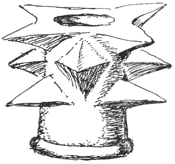
Fig. 171.
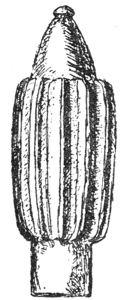
Fig. 172.
An ancient bronze mace-head was discovered in the gravel taken from under old London Bridge, which, I believe, has never been illustrated (Fig. 171). It was one of the mace-heads which are classed in the British Museum as of the Bronze Age, but they are, I think, early British. I have found a drawing of the mace-head in question in some interesting volumes of sketches by Fairholt at the South Kensington Museum. Fairholt’s note reads: “Bronze mace found at Barnes, November 10, 1841, amongst the gravel taken from old London Bridge.” Fig. 172 is an early bronze mace-head 239from Italy, in the British Museum, given for comparison.
The conditions were favourable for establishing a way in the line of London Bridge, for hard ground here approaches near to the south bank of the river. That the Roman city spread from Walbrook Creek as a centre is now generally agreed. Mr. Lambert’s plan of the finding-places of Claudian and pre-Claudian coins shows them distributed near the primitive port. Again, the city Watling Street is probably the beginning of the old road from the port. Wren found traces of an old street running aslant under the end of old St. Paul’s, and this probably formed part of the way towards Aldersgate. The acceptance of such a route as the main street of the oldest London would solve the difficulty of the “fault” in the lines of Newgate Street and Cheapside. I suppose that the Roman street through Newgate (which all would agree was formed at a late time when the walls and gates were built) branched westward from the old Verulam road I have been describing. In a similar way, the Roman road on the course of Old Street probably branched to the east out of the same ancient Verulam road. Mr. Codrington and others have supposed that the road to the east was continued also westward, but no evidence of this has been found. Stow, in his account of Aldersgate Street, says: “On the east side at a Red Cross turneth the Ealde Street, so called for that it was the old highway from Aldersgate Street for the north-east parts of England before Bishopsgate was builded.”
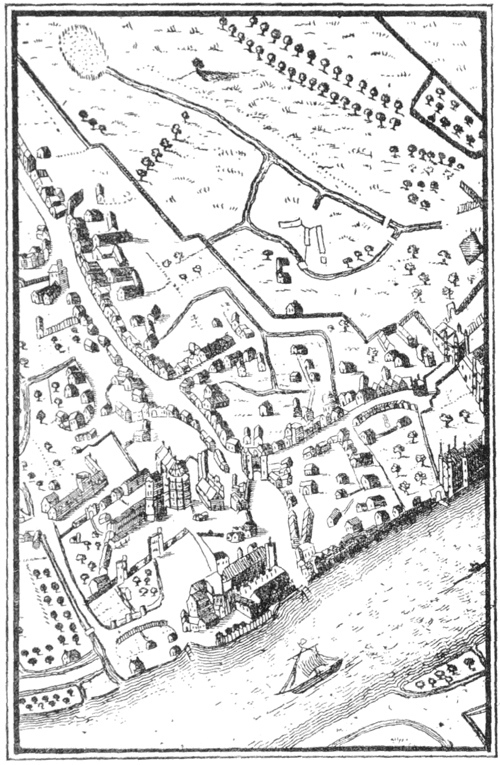
Fig. 173.
The Westminster Crossing.—It was remarked above that the emergence of Verulam into importance probably followed on the use of a river crossing at 240Westminster and a trackway in the course of Edgware Road, which is known to have been part of a later Roman highway—the Great Watling Street. It is generally allowed, as by Dr. Rice Holmes, that a British trackway underlies the general course of this great Roman highway from Dover to St. Albans and beyond. The monk Higden, writing about 1360, said that Watling Street passed to the west of Westminster, but it has been objected that what the monk thought was not evidence. However, in his time and until about two centuries ago, an important river crossing was maintained at the Horse-Ferry. The Horse-Ferry Road appears to have been made to divert a direct passage at Westminster when the great hall of the new Palace was built, about 1100. Sighting the line of Tothill Street, we see that it would have passed by the old Palace, but that the Hall blocks the way. The Abbey lies at the side of this line, which seems to mark the boundary of St. Margaret’s churchyard. Here, too, were found the Roman tomb and what appears to be a terminus mark (T II). The Horse-ferry is mentioned in an order of 1246: “The Bailiff of Kennington is to cause a barge to be made to carry people and horses over the Thames” (Hudson Turner’s Domestic Architecture, vol. i.). Canterbury documents show that the ferry was later in the charge of the Archbishop of Canterbury, and doubtless Lambeth Palace exists here as being on the great road. In the more direct line there still exists a short street called Stangate, which is an old name for a paved way. When Elizabeth, daughter of Henry VII., died at Eltham, “her body was conveyed to Stangate over against Westminster” (Sandford). A way to the river also was long 241maintained through New Palace Yard to a landing-place (see Fig. 173), from Norden’s map, c. 1600). Matthew Paris, in his route map of the way to Jerusalem, shows London Bridge and also the Westminster and Lambeth route, because these were alternative crossings. Tothill Street is mentioned in mediæval documents. It is possible that in early days there was a ford at Westminster, for Mr. Lambert has given reasons for thinking that formerly the tide did not rise so high as at present by 6 ft. Testimony on the course of the way 242from Westminster to Edgware Road is given in Ogilvie’s Road Book, 1675: “Piccadilly ... on the left falls in the way from Westminster by Tuttle Street; four poles from this corner, you have a way on the right by the side of Hyde Park into the other road at Tyburn.” The ancient road from Westminster would have crossed what is now Green Park in the direction of Tyburn Lane, now Park Lane. Here, in Tyburn Lane, was “Osulstone,” which gave its name to the Hundred in which London city is situated (see map recently reproduced by London Topographical Society). Tyburn, close by, was the place of execution, and doubtless the place of meeting of the old folk-mote of the Hundred, because it was at the cross roads. I have more detail establishing the continuity of this route (on which Dr. Haverfield expressed doubt), but I will pass to a few general final considerations.
The primitive road in Kent as far as Greenwich was on high ground, but beyond was the wide river valley. By bending to the left on the edge of higher ground, through Camberwell where Roman objects have been found, the river might be more nearly approached opposite Westminster, and there was solid land on the opposite bank also. Beyond, at Park Lane, the higher firm ground pushed down towards Westminster, between two little streams—the road here, indeed, was a low ridgeway. All evidence suggests that a British road to Verulam passed the Thames at Westminster. In Allen’s Lambeth, it is said that three “Celts” were found in digging the foundations of Westminster Bridge. Now, in Fairholt’s Albums of Sketches, at South Kensington, are drawings of three bronze weapons thus described: “Swords and spear found August 2431847, under Westminster Bridge by a ballast heaver.” The swords (Fig. 174) were 28½ in. and 23½ in. long, the spear-head or dagger was 16½ in. long. Other pieces of British bronze work have been found in the river in the neighbourhood of the Westminster crossing. Westminster Bridge itself still carries on the tradition by crossing the river at this point, and it is interesting to find recorded that the building of the bridge in the line of the Horse-ferry was the first intention. The importance of the Horse-ferry about 1700 is shown by the list of charges given in Hatton’s New View (1708).
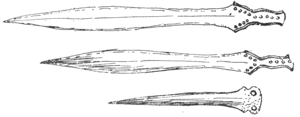
Fig. 174.
My general results in regard to the British and Roman road systems may be summarised thus:
1. A primitive trackway along the North Downs near the south bank of the river.
2. An ancient river-crossing by a ford at Westminster and thence north-west through Britain.
3. The growth of Verulam on this road, and the rise of London as a port in connection with it.
4. A direct London-Verulam road made over Islington—a ridgeway.
5. Hardly two or three persons possessing a boat could have been settled on the site of London before a direct path across Southwark would be taken to reach the Kentish road; thus the route 244marked by London Bridge must be of pre-Roman origin.
6. Other ways were thrown out; along the Strand to the Westminster crossing; along the comparatively high ground of Piccadilly to the west, and by Old Street and Old Ford to the east.
7. The British road system was rectified by Roman engineers. The chief route was now over London Bridge; the Roman road along Oxford Street was made in connection with the enlarged Londinium issuing from it at Newgate; it was continued to Brentford, where it met the older road by Piccadilly; the old track from Westminster to Verulam was improved only from this new road, and the link across the river became of secondary importance; Mile End Road superseded the route by Old Ford. There were thus older and newer roads—British ways following the higher and harder ground; and Roman roads laid down in straight lines.
In saying that London had its origin as the port of Verulam, I would not necessarily imply more than this: each may so have reacted on the other that it would be impossible to say which was the first cause. It is possible, indeed, that the Belgic kingdoms of south-east England were founded by invasions striking up the river, and that a landing at the site of London was earlier than settling down about St. Albans. It is remarkable that the Cattivellauni and Atrabates occupied much the same relative places in Britain as they did in their continental homes about Chalons and Arras. In this case, however, London would be none the less the port of Verulam.
Camden clearly saw that London began as a 245port. Discussing its name, he suggested as one possibility that “It might have had its name from the same original that it had its growth and glory; I mean ships, called by the British Lhong; so that London is a Harbour or City of Ships. For several cities have had their name from shipping, none of which can lay better claim to the name of harbour than our London. For ’tis admirably accommodated with both elements, and the river Thames brings it in the riches of the world. Moreover, it is such a sure and complete station for ships that one may liken it to a groved wood, so shaded it is with masts and sails.”
Conyers, the old antiquary apothecary, two centuries and a half ago, said: “Verulam was a kingly seat of the Britons, and the principal trade they had was between Verulam and London. So that on Watling or Verulam road there was a communication backward and forward.”